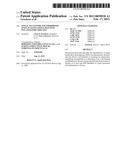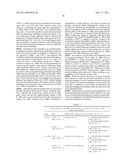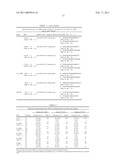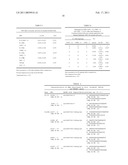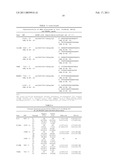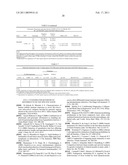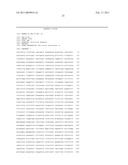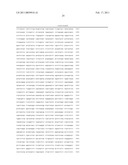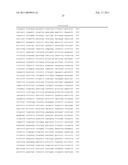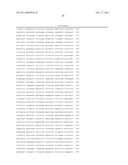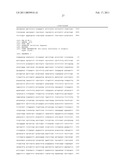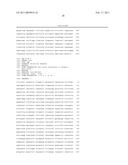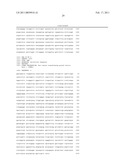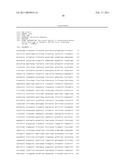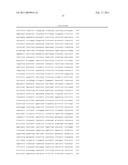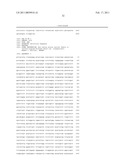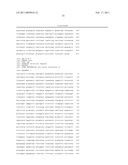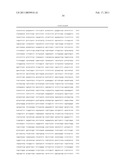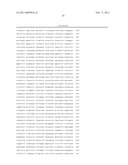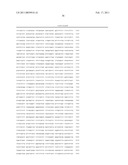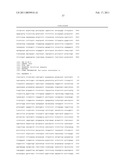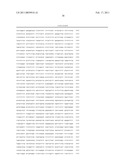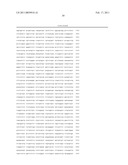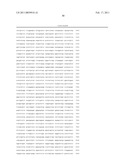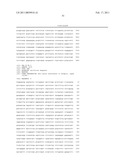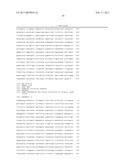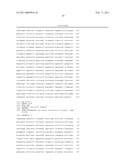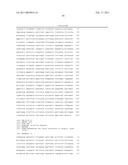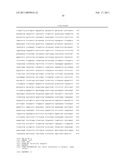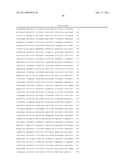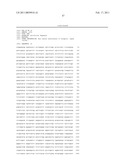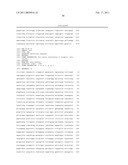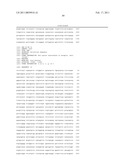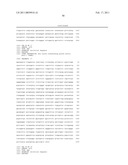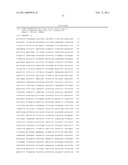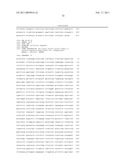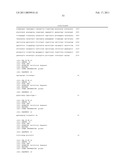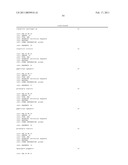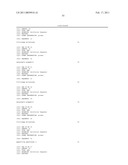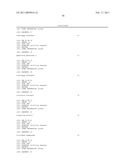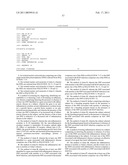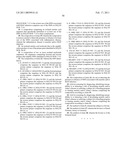Patent application title: Single Nucleotide Polymorphisms (SNPs) in Genes Associated with Inflammatory Diseases
Inventors:
Chris P. Verschoor (Hamilton, CA)
Niel A. Karrow (Belwood, CA)
IPC8 Class: AA61K317088FI
USPC Class:
514 44 R
Class name:
Publication date: 2011-02-17
Patent application number: 20110039918
Claims:
1. An isolated nucleic acid molecule comprising one of the single
nucleotide polymorphisms (SNPs) selected from SEQ ID NOS: 7-19.
2. The isolated nucleic acid molecule of claim 1, wherein the SNPs are selected from SEQ ID NOS: 10, 11, 13 and 14.
3. The isolated nucleic acid molecule of claim 1, wherein the SNPs are selected from SEQ ID NOS: 9, 10 and 12.
4. The isolated nucleic acid molecule of claim 1, wherein the SNP is SEQ ID NO: 12.
5. A method of screening for, diagnosing, identifying susceptibility to or detecting a risk of developing an inflammatory disease comprising detecting the presence or absence of at least one SNP identified in a gene associated with inflammatory disease in a subject, wherein the gene is an anti-inflammatory cytokine, an anti-inflammatory cytokine receptor, a growth factor, a growth factor receptor or an anti-bacterial promoting protein, and wherein the presence of the at least one SNP is indicative of an increased risk of inflammatory disease in the subject, and the absence of the at least one SNP is indicative of a decreased risk of inflammatory disease in the subject.
6. The method of claim 5, wherein the anti-inflammatory cytokine is IL-10 (interleukin 10); the anti-inflammatory cytokine receptor is interleukin 10 receptor subunit alpha (IL-10Rα) or interleukin 10 receptor subunit beta β (IL-10Rβ); the growth factor is transforming growth factor beta class I (TGF-.beta.I); and the anti-bacterial promoting protein is natural resistance-associated macrophage protein 1 (NRAMP1).
7. The method of claim 5, wherein the at least one SNP identified in a gene associated with inflammatory disease comprises one of the SNPs in SEQ ID NOS: 7-19.
8. The method of claim 5, wherein the inflammatory disease is mastitis or Johne's disease.
9. The method of claim 8, wherein the at least one SNP identified in a gene associated with inflammatory disease is a SNP associated with mastitis or is a SNP associated with MAP infection, and wherein the SNP associated with mastitis comprises one of the SNPs in SEQ ID NOS: 7-17 or the SNP associated with MAP infection comprises one of the SNPs in SEQ ID NOS: 7-19.
10. The method of claim 9, wherein the SNP associated with mastitis or the SNP associated with MAP infection comprises one of the SNPs in SEQ ID NOS: 10, 11, 13 and 14.
11. The method of claim 9, wherein the SNP associated with mastitis or the SNP associated with MAP infection comprises one of the SNPs in SEQ ID NOS: 9, 10 and 12.
12. The method of claim 11, wherein the SNP associated with mastitis is the SNP in SEQ ID NO: 12.
13. The method of claim 9, further comprising selecting a subject for a breeding program based on the presence or absence of the SNP associated with mastitis or selecting a subject for a breeding program based on the presence or absence of the SNP associated with MAP infection.
14. The method of claim 13, wherein the subject selected for the breeding program based on the presence or absence of the SNP associated with mastitis comprises an AGC SNP haplotype.
15. The method of claim 13, wherein the subject selected for the breeding program based on the presence or absence of the SNP associated with MAP infection comprises an AAT SNP haplotype.
16. A method of treating inflammatory disease in a subject comprising (a) detecting the presence or absence of at least one of the SNPs associated with inflammatory disease; and (b) administering to the subject, if at least one of the SNPs associated with inflammatory disease is present, an effective amount of an agent that treats inflammatory disease.
17. The method of claim 16, wherein the inflammatory disease is mastitis or Johne's disease, and the at least one of the SNPs associated with inflammatory disease comprises a SNP associated with mastitis or a SNP associated with MAP infection.
18. The method of claim 17, wherein the at least one of the SNPs associated with mastitis comprises one of the SNPs in SEQ ID NOS: 7-17 or the at least one of the SNPs associated with MAP infection comprises one of the SNPs in SEQ ID NOS: 7-19.
19. A composition comprising an isolated nucleic acid sequence that specifically hybridizes to at least one of the SNPs in SEQ ID NOS: 7-19 or their complements.
20. The composition of claim 19, wherein the composition is used as a probe to detect the presence or absence of at least one of the SNPs associated with inflammatory disease, wherein the inflammatory disease is mastitis and/or MAP infection.
21. An isolated nucleic acid molecule that is the amplification product of one of the primer pairs identified in SEQ ID NOS: 20-45.
22. A composition of two or more isolated nucleotide sequences, the sequences comprising forward and reverse primers that amplify SNPs identified in SEQ ID NOS: 7-19.
23. The composition of claim 22, wherein the SNP identified is:a. IL-10 969T>C (SEQ ID NO: 7) and the forward primer comprises the sequence in SEQ ID NO:20 and the reverse primer comprises the sequence in SEQ ID NO:21; orb. IL-10 1220A>C (SEQ ID NO: 8) and the forward primer comprises the sequence in SEQ ID NO:22 and the reverse primer comprises the sequence in SEQ ID NO:23; orc. IL-10Rα 1047C>A (SEQ ID NO: 9) and the forward primer comprises the sequence in SEQ ID NO:24 and the reverse primer comprises the sequence in SEQ ID NO:25; ord. IL-10Rα 1398G>A (SEQ ID NO: 10) and the forward primer comprises the sequence in SEQ ID NO:26 and the reverse primer comprises the sequence in SEQ ID NO:27; ore. IL-10Rα 1512C>T (SEQ ID NO: 11) and the forward primer comprises the sequence in SEQ ID NO:28 and the reverse primer comprises the sequence in SEQ ID NO:29; orf. IL-10Rα 1599C>T (SEQ ID NO: 12) and the forward primer comprises the sequence in SEQ ID NO:30 and the reverse primer comprises the sequence in SEQ ID NO:31; org. IL-10Rα 1683T>C (SEQ ID NO: 13) and the forward primer comprises the sequence in SEQ ID NO:32 and the reverse primer comprises the sequence in SEQ ID NO:33; orh. IL-10Rα 1716A>G (SEQ ID NO: 14) and the forward primer comprises the sequence in SEQ ID NO: 34 and the reverse primer comprises the sequence in SEQ ID NO: 35; ori. IL-10Rβ 542C>T (SEQ ID NO: 15) and the forward primer comprises the sequence in SEQ ID NO: 36 and the reverse primer comprises the sequence in SEQ ID NO: 37; orj. IL-10Rβ 608A>G (SEQ ID NO: 16) and the forward primer comprises the sequence in SEQ ID NO: 38 and the reverse primer comprises the sequence in SEQ ID NO: 39; ork. TGF-.beta.I 701C>T (SEQ ID NO: 17) and the forward primer comprises the sequence in SEQ ID NO: 40 and the reverse primer comprises the sequence in SEQ ID NO: 41; orl. NRAMP1 723C>T (SEQ ID NO: 18) and the forward primer comprises the sequence in SEQ ID NO: 42 and the reverse primer comprises the sequence in SEQ ID NO: 43; orm. NRAMP1 1139C>G (SEQ ID NO: 19) and the forward primer comprises the sequence in SEQ ID NO: 44 and the reverse primer comprises the sequence in SEQ ID NO: 45.
24. The composition of claim 22, for use in detecting the presence or absence of SNPs associated with mastitis and/or MAP infection.
25. A kit for screening for, diagnosing, identifying susceptibility to or detecting a risk of developing mastitis and/or Johne's disease or selecting a subject for a breeding program or treating mastitis and/or Johne's disease comprising the composition according to claim 19.
26. A kit for screening for, diagnosing, identifying susceptibility to or detecting a risk of developing mastitis and/or Johne's disease or selecting a subject for a breeding program or treating mastitis and/or Johne's disease comprising the composition according to claim 22.
27. The method of claim 5, wherein the subject is a bovine.
28. The method of claim 27, wherein the bovine is of breed Holstein, Jersey or Guernsey.
29. The method of claim 28, wherein the bovine is of the Holstein breed.
Description:
[0001]This disclosure claims the benefit under 35 USC §119(e) of U.S.
provisional application Ser. No. 61/232,965 filed Aug. 11, 2009, which is
incorporated herein by reference in its entirety.
INCORPORATION OF SEQUENCE LISTING
[0002]A computer readable form of the Sequence Listing "6530-405_Sequence_Listing.txt" (86,870 bytes), submitted via EFS-WEB and created on Aug. 10, 2010, is herein incorporated by reference.
FIELD OF THE DISCLOSURE
[0003]The present disclosure relates to the identification of single nucleotide polymorphisms (SNPs) in genes associated with inflammatory diseases, compositions, and methods for screening for, detecting, diagnosing or identifying susceptibility to or detecting a risk of developing inflammatory diseases.
BACKGROUND OF THE DISCLOSURE
[0004]Two prominent infectious inflammatory diseases occurring in bovines, and prevalent in dairy cattle, are mastitis and Johne's disease.
[0005]It is generally known that bovine mastitis is an inflammatory disease of the mammary gland most often caused by infection with contagious and/or environmental pathogenic bacteria such as Escherichia coli, Staphylococcus aureus, Streptococcus agalactiae and Streptococcus dysgalactiae. Generally, mastitis is manifested as a clinical as well as subclinical disease, and in cases of chronic infection, animals may remain asymptomatic throughout their entire life and potentially infect others within the herd (Oviedo-Boyso et al. 2007).
[0006]Not only is mastitis the most prevalent disease affecting dairy cattle, it is also the most costly for the dairy industry, with economic losses attributed to decreased milk production and quality, increased labor due to treatment and herd management strategies, and premature culling of highly susceptible animals (Halasa et al. 2007). In the United Kingdom alone, mastitis is estimated to cost up to 287 euros per cow per year, and approximately 9 million euros to the dairy industry as a whole (Hillerton et al. 1992; Kossaibati and Esslemont 1997).
[0007]It is known that the etiology of mastitis is complex, involving many causal strains of bacteria, as well as a wide variety of host factors that contribute to disease susceptibility. These factors include parity, stage of lactation, nutritional state, and host genetics (Oviedo-Boyso et al. 2007; Pyorala 2002). Given the complexity of this disease's etiology, and even though multiple management strategies have been adopted to control its rate of incidence, there is currently no effective means to screen for, identify and eventually eradicate mastitis from the dairy industry.
[0008]As mentioned above, another inflammatory disease occurring prominently in ruminants is Johne's disease, a chronic inflammatory bowel disease caused by an infection with Mycobacterium avium paratuberculosis (MAP). Incidentally, Johne's disease parallels Crohn's disease in humans in many respects. Since MAP is a slow-growing intracellular pathogen, infected cattle typically remain asymptomatic for 2 to 10 years making it difficult to control Johne's disease in dairy herds (McKenna et al., 2006). During this asymptomatic period, the pathogen can be horizontally transmitted to other herd members via contaminated feces, and vertically transmitted to calves via contaminated milk and colostrum (McKenna et al., 2006).
[0009]The presence of MAP in milk also poses a zoonotic risk to humans (Waddell et al. 2008). This may be particularly relevant for individuals that are genetically predisposed to inflammatory bowel disease (IBD), since MAP has been implicated as one of several potential pathogens associated with Crohn's disease (Glasser et al., 2008). A meta-analysis of studies examining the presence of MAP in patients with Crohn's disease or ulcerative colitis for example, showed that there was a greater likelihood of detecting MAP in diseased versus healthy individuals (Feller et al., 2007). Additionally, clinical studies have also shown that anti-mycobacterial treatment of some patients with Crohn's disease can lead to pathological remission (Chamberlin et al., 2007).
[0010]Variability in the susceptibility of cattle to MAP infection is evident. In a typical commercial dairy herd where there is a consistent prevalence of MAP infection for example, it is common to find animals that remain healthy, even after several years of exposure. Additionally, there is evidence that susceptibility to MAP infection, and the development of clinical symptoms associated with Johne's disease is inherited; heritability estimates in dairy cattle have been estimated to range from 0.010 to 0.183, depending on the criteria used to diagnose MAP infection or Johne's disease (Koetz et al., 2000; Gonda et al., 2006; Mortensen et al., 2004).
SUMMARY OF THE DISCLOSURE
[0011]The present disclosure addresses the need to limit the incidence of inflammatory diseases such as bovine mastitis and Johne's disease, which would be useful for the dairy cattle industry potentially improving the overall health of herds. Accordingly, there is a need in the art for the identification of genes involved in inflammatory diseases, and particularly the identification of single nucleotide polymorphisms (SNPs) in these genes for use in screening for, diagnosing, identifying susceptibility to or detecting a risk of developing mastitis and/or Mycobacterium avium paratuberculosis (MAP) infection and Johne's disease. Furthermore, there is a need for selection of sires and dams with enhanced genetic resistance to mastitis and Johne's disease in cattle breeding in order to improve the overall health of cattle, and to reduce the risk of human exposure to mastitis and/or Johne's disease.
[0012]The present disclosure discloses the identification of single nucleotide polymorphisms (SNPs) in genes associated with inflammatory diseases and uses thereof. In one embodiment, the inflammatory disease is mastitis. In another embodiment, the inflammatory disease is Johne's disease. In a further embodiment, the gene associated with inflammatory disease is a gene encoding an anti-inflammatory cytokine and/or a receptor thereof, a growth factor and/or receptor thereof and/or an anti-bacterial promoting protein.
[0013]The SNPs identified by the inventors in genes associated with inflammatory disease are described in Tables 1 and 5, and include: (a) IL-10 969T>C (NCBI dbSNP ssID: ss104807640, Build 130; SEQ ID NO: 7); (b) IL-10 1220A>C (NCBI dbSNP ssID: ss104807641, Build 130; SEQ ID NO: 8); (c) IL-10Rα 1047C>A (NCBI dbSNP ssID: ss104807642, Build 130; SEQ ID NO: 9); (d) IL-10Rα 1398G>A (NCBI dbSNP ssID: ss104807643, Build 130; SEQ ID NO: 10); (e) IL-10Rα 1512C>T (NCBI dbSNP ssID: ss104807644, Build 130; SEQ ID NO: 11); (f) IL-10Rα 1599C>T (NCBI dbSNP ssID: ss104807645, Build 130; SEQ ID NO: 12); (g) IL-10Rα 1683T>C (NCBI dbSNP ssID: ss104807646, Build 130; SEQ ID NO: 13); (h) IL-10Rα 1716A>G (NCBI dbSNP ssID: ss104807647, Build 130; SEQ ID NO: 14); (i) IL-10Rβ 542C>T (NCBI dbSNP ssID: ss104807648, Build 130; SEQ ID NO: 15); (j) IL-10Rβ 608A>G (NCBI dbSNP ssID: ss104807649, Build 130; SEQ ID NO: 16); (k) TGF-βI 701C>T (NCBI dbSNP ssID: ss104807650, Build 130; SEQ ID NO: 17); (l) NRAMP1 723C>T (NCBI dbSNP ssID: ss104807654, Build 130; SEQ ID NO: 18); and (m) NRAMP1 1139C>G, NCBI dbSNP ssID: ss104807655, Build 130; SEQ ID NO: 19). Accordingly, one embodiment of the present disclosure is an isolated nucleic acid molecule comprising one of the SNPs in SEQ ID NOS: 7-19. The present inventors have also identified SNP haplotypes in various SNPs identified in the IL-10Rα gene.
[0014]The present inventors have determined the association of the identified SNPs and/or SNP haplotypes in genes related to inflammatory diseases in bovines, including for example, in mastitis and Johne's disease.
[0015]Accordingly, another aspect of the present disclosure provides a method of screening for, diagnosing, identifying susceptibility to or detecting a risk of developing an inflammatory disease comprising detecting the presence or absence of at least one SNP identified in a gene associated with inflammatory disease in a subject, wherein the presence of the at least one SNP is indicative of an increased risk of inflammatory disease in the subject, and the absence of the at least one SNP is indicative of a decreased risk of inflammatory disease in the subject. In one embodiment, the inflammatory disease is mastitis. In another embodiment, the inflammatory disease is Johne's disease. In one embodiment, the at least one of the SNPs associated with inflammatory disease includes SNPs associated with mastitis and/or SNPs associated with MAP infection.
[0016]In another embodiment, the method of screening for, diagnosing, identifying susceptibility to or detecting a risk of developing an inflammatory disease comprising detecting the presence or absence of at least one SNP identified in a gene associated with inflammatory disease in a subject, further comprises selecting a subject for a breeding program comprising, based on the presence or absence of the SNP associated with an inflammatory disease, such as mastitis and/or Johne's disease.
[0017]Another aspect of the present disclosure provides a method of treating inflammatory disease in a subject including (a) detecting the presence or absence of at least one of the SNPs associated with inflammatory disease; and (b) administering to the subject, if at least one of the SNPs associated with inflammatory disease is present, an effective amount of an agent that treats inflammatory disease. In one embodiment, the inflammatory disease is mastitis. In another embodiment, the inflammatory disease is Johne's disease.
[0018]The present disclosure also provides compositions including nucleic acid probes that may be used to detect the presence or absence of at least one of the SNPs associated with inflammatory disease. The present disclosure also provides nucleotide sequences comprising forward and reverse primers that amplify SNPs identified in genes associated with inflammatory disease.
[0019]The present disclosure also includes kits containing the nucleic acid probes or primers described herein and instructions for use.
[0020]Other features and advantages of the present disclosure will become apparent from the following detailed description. It should be understood, however, that the detailed description and the specific examples while indicating preferred embodiments of the disclosure are given by way of illustration only, since various changes and modifications within the spirit and scope of the disclosure will become apparent to those skilled in the art from this detailed description.
DETAILED DESCRIPTION OF THE DISCLOSURE
I. Single Nucleotide Polymorphisms
[0021]The present inventors have investigated genes involved in inflammatory diseases, such as mastitis and Johne's disease (caused by an infection with Mycobacterium avium paratuberculosis), in order to identify single nucleotide polymorphisms (SNPs) in genes associated with inflammatory diseases. In particular, the present inventors investigated and selected six genes, including genes encoding anti-inflammatory cytokines and receptors thereof, growth factors and receptors thereof and an anti-bacterial promoting protein for identification of SNPs, namely, IL-10 [interleukin 10; NCBI-GeneID: 281246; SEQ ID NO: 1], IL-10Rα [interleukin 10 receptor subunit alpha; NCBI-GeneID: 513478; SEQ ID NO: 2]; IL-10Rβ [interleukin 10 receptor subunit beta; NCBI-GeneID: 767864; SEQ ID NO: 3], TGF-βI [transforming growth factor beta class I; NCBI-GeneID: 282089; SEQ ID NO: 4], TGF-βR type I [transforming growth factor beta type I receptor; NCBI-GeneID: 282382; TGF-βR type II [transforming growth factor beta type II receptor; NCBI-GeneID: 535376; SEQ ID NO: 5]; and NRAMP1 [natural resistance-associated macrophage protein 1; NCBI-GeneID: 282470; SEQ ID NO: 6].
[0022]As used herein, the term "SNP" means a single nucleotide polymorphism which is a single nucleotide position in a nucleotide sequence for which two or more alternative alleles are present in a given population.
[0023]The term "allele" means any one of a series of two or more different gene sequences that occupy the same position or locus on a chromosome.
[0024]The present inventors have identified thirteen SNPs in the IL-10, IL-10Rα, IL-10Rβ, TGF-βI and NRAMP1 genes. In particular, two SNPs were identified in IL-10; six were identified in IL-10Rα; two were identified in IL-10Rβ; one was identified in TGF-β1 and two were identified in NRAMP1 as set out immediately below and in Tables 1 and 5: [0025](a) the presence of a C nucleotide at position 969 in the 5' region of the IL-10 gene rather than a T nucleotide at position 969 as in SEQ ID NO: 1 (SNP IL-10 969T>C; NCBI dbSNP ssID: ss104807640, Build 130; SEQ ID NO: 7); [0026](b) the presence of a C nucleotide at position 1220 in the 5' region of the IL-10 gene rather than an A nucleotide at position 1220 as in SEQ ID NO: 1 (SNP IL-10 1220A>C; NCBI dbSNP ssID: ss104807641, Build 130; SEQ ID NO:8); [0027](c) the presence of an A nucleotide at position 1047 in the coding region of the IL-10Rα gene rather than a C nucleotide at position 1047 as in SEQ ID NO: 2 (SNP IL-10Rα 1047C>A; NCBI dbSNP ssID: ss104807642, Build 130; SEQ ID NO: 9); [0028](d) the presence of an A nucleotide at position 1398 in the coding region of the IL-10Rα gene rather than a G nucleotide at position 1398 as in SEQ ID NO: 2 (SNP IL-10Rα 1398G>A; NCBI dbSNP ssID: ss104807643, Build 130; SEQ ID NO: 10); [0029](e) the presence of a T nucleotide at position 1512 in the coding region of the IL-10Rα gene rather than a C nucleotide at position 1512 as in SEQ ID NO: 2 (SNP IL-10Rα 1512C>T; NCBI dbSNP ssID: ss104807644, Build 130; SEQ ID NO: 11); [0030](f) the presence of a T nucleotide at position 1599 in the coding region of the IL-10Rα gene rather than a C nucleotide at position 1599 as in SEQ ID NO: 2 (SNP IL-10Rα 1599C>T; NCBI dbSNP ssID: ss104807645, Build 130; SEQ ID NO: 12); [0031](g) the presence of a C nucleotide at position 1683 in the coding region of the IL-10Rα gene rather than a T nucleotide at position 1683 as in SEQ ID NO: 2 (SNP IL-10Rα 1683T>C; NCBI dbSNP ssID: ss104807646, Build 130; SEQ ID NO: 13); [0032](h) the presence of a G nucleotide at position 1716 in the coding region of the IL-10Rα gene rather than an A nucleotide at position 1716 as in SEQ ID NO: 2 (SNP IL-10Rα 1716A>G, NCBI dbSNP ssID: ss104807647, Build 130; SEQ ID NO: 14); [0033](i) the presence of a T nucleotide at position 542 in the coding region of the IL-10Rβ gene rather than a C nucleotide at position 542 as in SEQ ID NO: 3 (SNP IL-10Rβ 542C>T, NCBI dbSNP ssID: ss104807648, Build 130; SEQ ID NO: 15); [0034](j) the presence of a G nucleotide at position 608 in the coding region of the IL-10Rβ gene rather than an A nucleotide at position 608 as in SEQ ID NO: 3 (SNP IL-10Rβ 608A>G, NCBI dbSNP ssID: ss104807649, Build 130; SEQ ID NO: 16); [0035](k) the presence of a T nucleotide at position 701 in the coding region of the TGF-βI gene rather than a C nucleotide at position 701 as in SEQ ID NO: 4 (SNP TGF-βI 701C>T, NCBI dbSNP ssID: ss104807650, Build 130; SEQ ID NO: 17); [0036](l) the presence of a T nucleotide at position 723 in the coding region of the NRAMP1 gene rather than a C nucleotide at position 723 as in SEQ ID NO: 6 (SNP NRAMP1 723C>T, NCBI dbSNP ssID: ss104807654, Build 130; SEQ ID NO: 18); and [0037](m) the presence of a G nucleotide at position 1139 in the coding region of the NRAMP1 gene rather than a C nucleotide at position 1139 as in SEQ ID NO: 6 (SNP NRAMP1 1139C>G, NCBI dbSNP ssID: ss104807655, Build 130; SEQ ID NO: 19),which are associated with inflammatory diseases including mastitis and/or Johne's disease (caused by Mycobacterium avium paratuberculosis (MAP) infection). The present inventors found that the SNPs identified in SEQ ID NOS: 10, 11, 13 and 14 (namely, SNP IL-10Rα 1398G>A, SNP IL-10Rα 1512C>T, SNP IL-10Rα 1683T>C, and SNP IL-10Rα 1716A>G, respectively) are completely linked. The present inventors also determined that the SNPs identified in SEQ ID NOS: 9, 10 and 12 (namely, SNP IL-10Rα 1047C>A, SNP IL-10Rα 1398G>A; and SNP IL-10Rα 1599C>T, respectively) are in linkage disequilibrium.
[0038]Other variants of the above-noted genes are contemplated by the present disclosure. Accordingly, in one embodiment, the nucleotides at positions 969 and 1220 in the IL-10 gene (SEQ ID NO: 1) may have nucleotides that differ from the SNPs identified in SEQ ID NOS: 7-8 and the wild-type sequence in SEQ ID NO: 1. In another embodiment, the nucleotides at positions 1047, 1398, 1512, 1599, 1683, and 1716 in IL-10Rα gene (SEQ ID NO: 2) may have nucleotides that differs from the SNPs identified in SEQ ID NOS: 9-14 and the wild-type sequence in SEQ ID NO: 2. In another embodiment, the nucleotides at positions 542 and 608 in the IL-10Rβ gene (SEQ ID NO: 3) may have nucleotides that differ from the SNPs identified in SEQ ID NOS: 15-16 and the wild-type sequence in SEQ ID NO: 3. In another embodiment, the nucleotide at position 701 in the TGF-β1 gene (SEQ ID NO: 4) may differ from the SNP identified in SEQ ID NO: 17 and the wild-type sequence in SEQ ID NO: 4. In a further embodiment, the nucleotides at positions 723 and 1139 of the NRAMP1 gene (SEQ ID NO: 6) may differ from the SNPs identified in SEQ ID NOS: 18-19 and the wild-type sequence in SEQ ID NO: 6.
[0039]Another embodiment of the present disclosure includes an isolated nucleic acid molecule comprising one of the SNPs identified in SEQ ID NOS: 7-19. In another embodiment, the isolated nucleic acid molecule comprises one of the SNPs identified in SEQ ID NOS: 10, 11, 13 and 14. In a further embodiment, the isolated nucleic acid molecule comprises one of the SNPs identified in SEQ ID NOS: 9, 10 and 12. In another embodiment, the isolated nucleic acid molecule comprises the SNP identified in SEQ ID NO: 12.
[0040]The term "isolated nucleic acid molecule" refers to a nucleic acid substantially free of cellular material or culture medium, for example, when produced by recombinant DNA techniques, or chemical precursors, or other chemicals when chemically synthesized. An "isolated nucleic acid" is also substantially free of sequences which naturally flank the nucleic acid (i.e. sequences located at the 5' and 3' ends of the nucleic acid) from which the nucleic acid is derived. The term "nucleic acid" is intended to include DNA and RNA and can be either double stranded or single stranded.
A. Haplotypes in Mastitis
[0041]Referring to Table 4, the present inventors identified and determined that various haplotypes, namely, AAT, AGT and CAT, in three of the SNPs in the IL-10Rα gene, namely, SNP IL-10Rα 1047C>A; SNP IL-10Rα 1398G>A; and SNP IL-10Rα 1599C>T showed different effects on mastitis as compared to the most frequent haplotype, AGC. In particular, the AAT haplotype in three of the SNPs in the IL-10Rα gene, namely, SNP IL-10Rα 1047C>A; SNP IL-10Rα 1398G>A; and SNP IL-10Rα 1599C>T ("AAT SNP haplotype") showed a significant effect as compared to the most frequent haplotype, AGC ("AGC SNP haplotype"). In addition, the present inventors found that SNP IL-10Rα 1398G>A is completely linked to at least three SNPs, namely, SNP IL-10Rα 1512C>T; SNP IL-10Rα 1683T>C; and SNP IL-10Rα 1716A>G. Therefore, the various haplotypes identified by the inventors, namely, AAT, AGT and CAT, also comprise these at least three SNPs.
[0042]Accordingly, in one embodiment the AGC SNP haplotype of the IL-10Rα gene associated with mastitis comprises: (a) the presence of an A nucleotide at position 1047 in the coding region of the IL-10Rα gene rather than a C nucleotide at position 1047 as in SEQ ID NO: 2; (b) the presence of G nucleotide at position 1398 as in SEQ ID NO: 2; and (c) the presence of a C nucleotide at position 1599 as in SEQ ID NO: 2.
[0043]In another embodiment, the AAT SNP haplotype of the IL-10Rα gene associated with mastitis comprises: (a) the presence of an A nucleotide at position 1047 in the coding region of the IL-10Rα gene rather than a C nucleotide at position 1047 as in SEQ ID NO: 2; (b) the presence of an A nucleotide at position 1398 in the coding region of the IL-10Rα gene rather than a G nucleotide at position 1398 as in SEQ ID NO: 2; and (c) the presence of a T nucleotide at position 1599 in the coding region of the IL-10Rα gene rather than a C nucleotide at position 1599 as in SEQ ID NO: 2.
B. Haplotypes in MAP infection
[0044]Referring to Table 7, the present inventors also identified and determined that various haplotypes, namely, AAT, CAC and AAC, in three of the SNPs in the IL-10Rα gene, namely, SNP IL-10Rα 1047C>A; SNP IL-10Rα 1398G>A; and SNP IL-10Rα 1599C>T showed different effects on MAP infection as compared to the most frequent haplotype in the positive cohort, AGC. In particular, the AAT haplotype in three of the SNPs in the IL-10Rα gene, namely, SNP IL-10Rα 1047C>A; SNP IL-10Rα 1398G>A; and SNP IL-10Rα 1599C>T ("AAT SNP haplotype") showed a significant effect in the negative cohort as compared to the most frequent haplotype, AGC ("AGC SNP haplotype"). In addition, the inventors found that SNP IL-10Rα 1398G>A is completely linked to at least three SNPs, namely, SNP IL-10Rα 1512C>T; SNP IL-10Rα 1683T>C; and SNP IL-10Rα 1716 A>G. Therefore, the various haplotypes identified by the inventors, namely, AAT, CAC and AAC, also comprise these at least three SNPs.
[0045]Accordingly, in one embodiment the AGC SNP haplotype of the IL-10Rα gene associated with MAP infection in the positive cohort comprises: (a) the presence of an A nucleotide at position 1047 in the coding region of the IL-10Rα gene rather than a C nucleotide at position 1047 as in SEQ ID NO: 2; (b) the presence of G nucleotide at position 1398 as in SEQ ID NO: 2; and (c) the presence of a C nucleotide at position 1599 as in SEQ ID NO: 2.
[0046]In another embodiment, the AAT SNP haplotype of the IL-10Rα gene associated with MAP infection in the negative cohort comprises: (a) the presence of an A nucleotide at position 1047 in the coding region of the IL-10Rα gene rather than a C nucleotide at position 1047 as in SEQ ID NO: 2; (b) the presence of an A nucleotide at position 1398 in the coding region of the IL-10Rα gene rather than a G nucleotide at position 1398 as in SEQ ID NO: 2; and (c) the presence of a T nucleotide at position 1599 in the coding region of the IL-10Rα gene rather than a C nucleotide at position 1599 as in SEQ ID NO: 2.
II. Methods and Uses of the Disclosure
A. Methods and Uses for Genetic Analysis
[0047]The present inventors have determined the association of identified individual SNPs and/or SNP haplotypes described herein in genes related to inflammatory diseases in bovines, including for example, mastitis and Johne's disease.
[0048]Accordingly, in one embodiment, the present disclosure includes methods and uses of the SNPs identified in SEQ ID NOS: 7-19 in or for genetic analysis. In one embodiment, genetic analysis includes linkage analysis or association analysis. In a further embodiment, association analysis includes analyzing association with inflammatory diseases. In another embodiment, association analysis includes analyzing association with mastitis in cattle. In another embodiment, association analysis includes analyzing association with MAP infection and/or Johne's disease in cattle.
B. Methods and Uses For Inflammatory Diseases
[0049]As noted above, the present inventors have determined the association of identified individual SNPs and/or SNP haplotypes described herein in genes related to inflammatory diseases in bovines.
[0050]Accordingly, one embodiment of the present disclosure is a method of screening for, diagnosing, identifying susceptibility to or detecting a risk of developing an inflammatory disease comprising detecting the presence or absence of at least one SNP identified in a gene associated with inflammatory disease in a subject, wherein the presence of the at least one SNP is indicative of an increased risk of inflammatory disease in the subject, and the absence of the at least one SNP is indicative of a decreased risk of inflammatory disease in the subject.
[0051]In another embodiment, the genes associated with inflammatory disease include genes that encode an anti-inflammatory cytokine, an anti-inflammatory cytokine receptor, a growth factor, a growth factor receptor and/or an anti-bacterial promoting protein. In another embodiment, the anti-inflammatory cytokine is IL-10 (interleukin 10). In another embodiment, the anti-inflammatory cytokine receptor is IL-10Rα (interleukin 10 receptor subunit alpha) and/or IL-10Rβ (interleukin 10 receptor subunit beta β). In another embodiment, the growth factor is TGF-βI (transforming growth factor beta class I). In another embodiment, the growth factor receptor is TGF-βR type I (transforming growth factor beta type I receptor) and/or TGF-βR type II (transforming growth factor beta type II receptor). In a further embodiment, the anti-bacterial promoting protein is NRAMP1 (natural resistance-associated macrophage protein 1).
[0052]In another embodiment, at least one SNP identified in a gene associated with inflammatory disease comprises: [0053](a) the presence of a C nucleotide at position 969 in the 5' region of the IL-10 gene rather than a T nucleotide at position 969 as in SEQ ID NO: 1 (SNP IL-10 969T>C; NCBI dbSNP ssID: ss104807640, Build 130; SEQ ID NO: 7); [0054](b) the presence of a C nucleotide at position 1220 in the 5' region of the IL-10 gene rather than an A nucleotide at position 1220 as in SEQ ID NO: 1 (SNP IL-10 1220A>C; NCBI dbSNP ssID: ss104807641, Build 130; SEQ ID NO:8); [0055](c) the presence of an A nucleotide at position 1047 in the coding region of the IL-10Rα gene rather than a C nucleotide at position 1047 as in SEQ ID NO: 2 (SNP IL-10Rα 1047C>A; NCBI dbSNP ssID: ss104807642, Build 130; SEQ ID NO: 9); [0056](d) the presence of an A nucleotide at position 1398 in the coding region of the IL-10Rα gene rather than a G nucleotide at position 1398 as in SEQ ID NO: 2 (SNP IL-10Rα 1398G>A; NCBI dbSNP ssID: ss104807643, Build 130; SEQ ID NO: 10); [0057](e) the presence of a T nucleotide at position 1512 in the coding region of the IL-10Rα gene rather than a C nucleotide at position 1512 as in SEQ ID NO: 2 (SNP IL-10Rα 1512C>T; NCBI dbSNP ssID: ss104807644, Build 130; SEQ ID NO: 11); [0058](f) the presence of a T nucleotide at position 1599 in the coding region of the IL-10Rα gene rather than a C nucleotide at position 1599 as in SEQ ID NO: 2 (SNP IL-10Rα 1599C>T; NCBI dbSNP ssID: ss104807645, Build 130; SEQ ID NO: 12); [0059](g) the presence of a C nucleotide at position 1683 in the coding region of the IL-10Rα gene rather than a T nucleotide at position 1683 as in SEQ ID NO: 2 (SNP IL-10Rα 1683T>C; NCBI dbSNP ssID: ss104807646, Build 130; SEQ ID NO: 13); [0060](h) the presence of a G nucleotide at position 1716 in the coding region of the IL-10Rα gene rather than an A nucleotide at position 1716 as in SEQ ID NO: 2 (SNP IL-10Rα 1716A>G, NCBI dbSNP ssID: ss104807647, Build 130; SEQ ID NO: 14); [0061](i) the presence of a T nucleotide at position 542 in the coding region of the IL-10Rβ gene rather than a C nucleotide at position 542 as in SEQ ID NO: 3 (SNP IL-10Rβ 542C>T, NCBI dbSNP ssID: ss104807648, Build 130; SEQ ID NO: 15); [0062](j) the presence of a G nucleotide at position 608 in the coding region of the IL-10Rβ gene rather than an A nucleotide at position 608 as in SEQ ID NO: 3 (SNP IL-10Rβ 608A>G, NCBI dbSNP ssID: ss104807649, Build 130; SEQ ID NO: 16); [0063](k) the presence of a T nucleotide at position 701 in the coding region of the TGF-βI gene rather than a C nucleotide at position 701 as in SEQ ID NO: 4 (SNP TGF-βI 701C>T, NCBI dbSNP ssID: ss104807650, Build 130; SEQ ID NO: 17); [0064](l) the presence of a T nucleotide at position 723 in the coding region of the NRAMP1 gene rather than a C nucleotide at position 723 as in SEQ ID NO: 6 (SNP NRAMP1 723C>T, NCBI dbSNP ssID: ss104807654, Build 130; SEQ ID NO: 18); and [0065](m) the presence of a G nucleotide at position 1139 in the coding region of the NRAMP1 gene rather than a C nucleotide at position 1139 as in SEQ ID NO: 6 (SNP NRAMP1 1139C>G, NCBI dbSNP ssID: ss104807655, Build 130; SEQ ID NO: 19).C. Methods of Screening for, Diagnosing, Identifying Susceptibility to or Detecting a Risk of Developing Mastitis, and Selecting for a Breeding Program
[0066]In one embodiment of the methods and uses for inflammatory disease, the inflammatory disease is mastitis. Accordingly, in another embodiment, the at least one SNP identified in a gene associated with inflammatory disease is a SNP associated with mastitis. In another embodiment, the SNP associated with mastitis comprises one of the SNPs in SEQ ID NOS: 7-17.
[0067]The present inventors have associated the identified individual SNPs and/or SNP haplotypes to mastitis. In particular, the present inventors have determined the association of the identified individual SNPs and/or SNP haplotypes to mastitis using estimated breeding values (EBV) for somatic cell scores (SCS) in cattle.
[0068]Accordingly, one embodiment of the present disclosure is a method of screening for, diagnosing, identifying susceptibility to or detecting a risk of developing mastitis comprising detecting the presence or absence of at least one of the SNPs associated with mastitis, such as the SNPs described in SEQ ID NOS: 7-17, in a subject; wherein detecting the presence of at least one of the SNPs associated with mastitis is indicative of an increased risk of mastitis in the subject, and the absence of at least one of the SNPs associated with mastitis is indicative of a decreased risk of mastitis in the subject. The increased risk is relative to a subject having an absence of at least one of the SNPs associated with mastitis. The present disclosure also provides use of a composition of the disclosure for screening for, diagnosing, identifying susceptibility to or detecting a risk of developing mastitis, and selecting a subject having an absence of at least one SNP associated with mastitis for a breeding program.
[0069]The term "mastitis" refers to an inflammatory disease of the mammary gland caused by infection with contagious and/or environmental pathogenic bacteria, including without limitation, Escherichia coli, Staphylococcus aureus, Streptococcus agalactiae and Streptococcus dysgalactiae. Symptomatic indications of mastitis infection include, for example, decreased milk production and milk quality, which may be assessed by clinical inspection and/or determining somatic cell count (SCC). Somatic cell score (SCS) is a measure of the average number of somatic cells in milk and is also used to assess milk production and/or milk quality.
[0070]The phrase "screening for, diagnosing, identifying susceptibility to or detecting a risk of developing mastitis" refers to a method or process of determining if a subject has an increased risk of or predisposition to or increased susceptibility to mastitis (i.e. by detecting the presence of at least one of the SNPs associated with mastitis), or if a subject does not have an increased risk of mastitis. The increased risk or increased susceptibility to mastitis is measured relative to a subject having an absence of the SNPs associated with mastitis as described herein. For example, SNPs may be associated with mastitis using estimated breeding values (EBV) for somatic cell scores (SCS) in cattle. In one embodiment, SNPs are associated with deregressed EBVs for SCS.
[0071]The term "subject" as used herein refers to any member of the animal kingdom, including any lactating mammal, for example a human, dog, cat, horse, cow, bovine, ruminant, bull, pig, sheep, mouse or rat. In one embodiment, the subject is a ruminant animal, such as a bovine (cow or bull). In a further embodiment, the bovine breed may be Holstein, Jersey or Guernsey. In another embodiment, the bovine breed is Holstein. In another embodiment, the bovine breed is Jersey. In a further embodiment, the bovine breed is Guernsey.
[0072]In one embodiment, the at least one SNP associated with mastitis comprises at least one of the SNPs in SEQ ID NOS: 7-17.
[0073]In another embodiment, the at least one SNP associated with mastitis comprises at least one of the SNPs in SEQ ID NOS: 10, 11, 13 and 14.
[0074]In another embodiment, the at least one SNP associated with mastitis comprises at least one of the SNPs in SEQ ID NOS: 9, 10 and 12.
[0075]In a further embodiment, the at least one SNP associated with mastitis comprises the SNP in SEQ ID NO: 12.
[0076]Another embodiment in the method of screening for, diagnosing, identifying susceptibility to or detecting a risk of developing mastitis comprising detecting the presence or absence of at least one of the SNPs associated with mastitis in a subject, further comprises selecting a subject for a breeding program based on the presence or absence of the SNP associated with mastitis. In one embodiment, a subject having an absence of the SNP associated with mastitis is selected for the breeding program. In another embodiment, the breeding program leads to subjects with reduced incidence of mastitis and enhanced genetic resistance to mastitis.
[0077]As used herein, "subjects with reduced incidence of mastitis" include for example subjects exhibiting a reduction in the clinical indications of mastitis, including asymptomatic and symptomatic indications. For example, a reduction in symptomatic indications of mastitis infection includes a reduction in decreased milk production and milk quality. Decreased milk production and milk quality may be assessed by somatic cell count (SCC) and somatic cell score (SCS). For example, decreased values of SCC and SCS correspond with a reduction of mastitis.
[0078]The term "subjects with enhanced genetic resistance to mastitis" refers to an increase in the number of subjects in a population of subjects having an absence of at least one of the SNPs associated with mastitis. In another embodiment, subjects with reduced incidence of mastitis and enhanced genetic resistance to mastitis result in improved health of subjects. As used herein "improved health of subjects" refers to subjects not exhibiting clinical indications of mastitis and/or subjects having an absence of at least one of the SNPs associated with mastitis.
[0079]The present inventors identified and determined that various haplotypes, namely, AAT, AGT and CAT, in three of the SNPs in the IL-10Rα gene, namely, SNP IL-10Rα 1047C>A; SNP IL-10Rα 1398G>A; and SNP IL-10Rα 1599C>T showed different effects on mastitis as compared to the most frequent haplotype, AGC. The present inventors showed that AAT haplotype had a significant effect on increasing SCS as compared to the most common haplotype AGC. As noted above, the inventors found that SNP IL-10Rα 1398G>A is completely linked to at least three SNPs, namely, SNP IL-10Rα 1512C>T; SNP IL-10Rα 1683T>C; and SNP IL-10Rα 1716 A>G. Therefore, the various haplotypes identified by the inventors, namely, AAT, AGT and CAT, also comprise these at least three SNPs.
[0080]Accordingly, in one embodiment, a subject having the AGC SNP haplotype is selected for the breeding program. In another embodiment, a subject having the AAT SNP haplotype is not selected for the breeding program.
[0081]As noted above, the present inventors found that the SNPs identified in SEQ ID NOS: 10, 11, 13 and 14 are completely linked; and found that the SEQ ID NOS: 9, 10 and 12 are in linkage disequilibrium. The inventors further identified various haplotypes associated with mastitis using the SNPs in SEQ ID NOS: 9, 10 and 12.
[0082]Accordingly, another embodiment of the present disclosure is a method of using linkage disequilibrium to identify alleles or haplotypes associated with mastitis that are present in a subject, for example, by using the techniques described herein to detect SNPs, which have been applied to identify the SNP alleles and haplotypes associated with mastitis described herein. In another embodiment, the present disclosure includes selecting a subject for the breeding program comprising using SNPs that are in linkage disequilibrium and thus are genetically linked to the SNPs associated with mastitis described herein.
[0083]Without wishing to be bound by a particular theory, the identified SNPs described herein may alter the gene expression of the IL-10, IL-10Rα, IL-10Rβ, TGF-βI genes and/or the amount of IL-10, IL-10Rα, IL-10Rβ, TGF-βI protein. The risk alleles in IL-10Rβ or IL-10Rβ may affect gene function (i.e. reduced mRNA expression and/or protein) by altering the mRNA secondary structure, the stability of mRNA or RNA splicing. Thus the present disclosure also includes a method of screening for, diagnosing, identifying susceptibility to or detecting a risk of developing mastitis by measuring the mRNA expression or protein of the IL-10Rβ or IL-10Rβ gene, wherein an altered amount compared to control levels is indicative of an increased risk of mastitis.
[0084]The methods of the disclosure including screening for, diagnosing, identifying susceptibility to or detecting a risk of developing mastitis, and for selecting a subject having an absence of at least one SNP associated with mastitis for a breeding program can be used in addition to or in combination with other methods.
D. Methods of Screening for, Diagnosing, Identifying Susceptibility to or Detecting a Risk of Developing Johne's Disease, and Selecting for a Breeding Program
[0085]In one embodiment of the methods and uses for inflammatory disease, the inflammatory disease is Johne's disease. Accordingly, in another embodiment, the at least one SNP identified in a gene associated with inflammatory disease is a SNP associated with MAP infection. In another embodiment, the SNP associated with MAP infection comprises one of the SNPs in SEQ ID NOS: 7-19.
[0086]The present inventors have associated the identified individual SNPs and/or SNP haplotypes to Johne's disease. In particular, the present inventors have determined the association of the identified SNPs and/or SNP haplotypes to Johne's disease using an antibody response to Mycobacterium avium paratuberculosis (MAP) infection.
[0087]Accordingly, one embodiment of the present disclosure is a method of screening for, diagnosing, identifying susceptibility to or detecting a risk of developing Johne's disease comprising determining the presence or absence of at least one of the SNPs associated with MAP infection, such as the SNPs described in SEQ ID NOS: 7-19, in a subject; wherein detecting the presence of at least one of the SNPs associated with MAP infection is indicative of an increased risk of Johne's disease in the subject, and the absence of at least one of the SNPs associated with MAP infection is indicative of a decreased risk of Johne's disease in the subject. The increased risk is relative to a subject having an absence of at least one of the SNPs associated with MAP infection. The present disclosure also provides use of a composition of the disclosure for screening for, diagnosing, identifying susceptibility to or detecting a risk of developing Johne's disease, and selecting a subject having an absence of at least one SNP associated with MAP infection for a breeding program.
[0088]The term "Johne's disease" refers to an inflammatory disease, and in particular refers to a chronic inflammatory bowel disease which is caused by an infection with Mycobacterium avium paratuberculosis (MAP), which is also described herein as "MAP infection". MAP infection may be assessed by detecting MAP-specific antibodies and/or by detecting MAP bacteria. MAP bacteria may be detected using molecular diagnostics including for example, analyzing fecal culture or performing any other suitable molecular diagnostics test such as PCR. Symptomatic indications for MAP infection include without limitation chronic wasting, diarrhea and/or intestinal lesion.
[0089]The phrase "screening for, diagnosing, identifying susceptibility to or detecting a risk of developing Johne's disease" refers to a method or process of determining if a subject has an increased risk of or predisposition to or increased susceptibility to Johne's disease (i.e. by detecting the presence of at least one of the SNPs associated with MAP infection), or if a subject does not have an increased risk of Johne's disease. The increased risk or increased susceptibility to Johne's disease is measured relative to a subject having an absence of the SNPs associated with MAP infection as described herein. For example, MAP infection may be determined by identifying the presence of MAP-specific antibodies.
[0090]In one embodiment, the at least one SNP associated with MAP infection comprises one of the SNPs in SEQ ID NOS: 7-19.
[0091]In another embodiment, the at least one SNP associated with MAP infection comprises one of the SNPs in SEQ ID NOS: 10, 11, 13 and 14.
[0092]In a further embodiment, the at least one SNP associated with MAP infection comprises the SNP in SEQ ID NOS: 9, 10 and 12.
[0093]Another embodiment in the method of screening for, diagnosing, identifying susceptibility to or detecting a risk of developing Johne's disease comprising detecting the presence or absence of at least one of the SNPs associated with MAP infection in a subject, further comprises selecting a subject for a breeding program based on the presence or absence of the SNP associated with MAP infection. In one embodiment, a subject having an absence of the SNP associated with MAP infection is selected for the breeding program. In another embodiment, the breeding program leads to subjects with reduced incidence of MAP infection and/or Johne's disease and enhanced genetic resistance to MAP infection and/or Johne's disease.
[0094]As used herein, "subjects with reduced incidence of MAP infection and/or Johne's disease" include for example subjects exhibiting a reduction in the clinical indications of MAP infection, including asymptomatic and symptomatic indications. For example, a reduction in indications of MAP infection includes without limitation a reduction in the presence of MAP-specific antibodies, wasting, diarrhea and/or intestinal lesions.
[0095]The term "subjects with enhanced genetic resistance to Johne's disease" refers to an increase in the number of subjects in a population of subjects having an absence of at least one of the SNPs associated with MAP infection. In another embodiment, subjects with reduced incidence of Johne's disease and enhanced genetic resistance to Johne's disease result in improved health of subjects. As used herein "improved health of subjects" refers to subjects not exhibiting clinical indications of Johne's disease and/or subjects having an absence of at least one of the SNPs associated with MAP infection.
[0096]In another embodiment, reduced incidence of Johne's disease and enhanced genetic resistance to Johne's disease leads to a decrease in the risk of human exposure to MAP infection.
[0097]The present inventors also identified and determined that various haplotypes, namely, AAT, CAC and AAC, in three of the SNPs in the IL-10Rα gene, namely, SNP IL-10Rα 1047C>A; SNP IL-10Rα 1398G>A; and SNP IL-10Rα 1599C>T showed different effects on MAP infection as compared to the most frequent haplotype in the positive cohort, AGC. As noted above, the present inventors found that SNP IL-10Rα 1398G>A is completely linked to at least three SNPs, namely, SNP IL-10Rα 1512C>T; SNP IL-10Rα 1683T>C; and SNP IL-10Rα 1716 A>G. Therefore, the various haplotypes identified by the inventors, namely, AAT, CAC and AAC, also comprise these at least three SNPs.
[0098]The present inventors found that haplotype AGC was more commonly found in the positive cohort and was thus associated with MAP infection. In contrast haplotype AAT was more commonly found in the negative cohort. Accordingly, in one embodiment, a subject having the AAT SNP haplotype is selected for the breeding program. In another embodiment, a subject having the AGC SNP haplotype is not selected for the breeding program.
[0099]As noted above, the present inventors found that the SNPs identified in SEQ ID NOS: 10, 11, 13 and 14 are completely linked; and also found that the SEQ ID NOS: 9, 10 and 12 are in linkage disequilibrium. The inventors further identified various haplotypes associated with MAP infection using the SNPs in SEQ ID NOS: 9, 10 and 12.
[0100]Accordingly, another embodiment of the present disclosure is a method of using linkage disequilibrium to identify alleles or haplotypes associated with MAP infection that are present in a subject, for example, by using techniques described herein to detect SNPs, which have been applied to identify the SNP alleles and haplotypes associated with MAP infection described herein. In another embodiment, the present disclosure includes selecting a subject for the breeding program comprising using SNPs that are in linkage disequilibrium and thus are genetically linked to the SNPs associated with MAP infection described herein.
[0101]Without wishing to be bound by a particular theory, the SNPs described herein may alter the gene expression of the IL-10, IL-10Rα, IL-10Rβ, TGF-βI genes and/or the amount of IL-10, IL-10Rα, IL-10Rβ, TGF-βI protein. The risk alleles in IL-10Rβ or IL-10Rβ may affect gene function (i.e. reduced mRNA expression and/or protein) by altering the mRNA secondary structure, mRNA folding, the stability of mRNA or RNA splicing. Thus the present disclosure also includes a method of screening for, diagnosing, identifying susceptibility to or detecting a risk of developing Johne's disease by measuring the mRNA expression or protein of the IL-10Rβ or IL-10Rβ gene, wherein an altered amount compared to control levels is indicative of an increased risk of Johne's disease.
[0102]The methods of the disclosure including screening for, diagnosing, identifying susceptibility to or detecting a risk of developing Johne's disease, and for selecting a subject having an absence of at least one SNP associated with MAP infection for a breeding program can be used in addition to or in combination with other methods.
E. Methods of Detecting SNPs
[0103]The methods described in the present disclosure, including for example, screening for, diagnosing, identifying susceptibility or detecting a risk of developing inflammatory diseases, including mastitis and/or Johne's disease and map infection, include detecting the presence or absence of the respective associated SNPs identified and described herein.
[0104]A person skilled in the art will appreciate that a number of methods can be used to measure or detect the presence of the SNPs identified in the present disclosure. For example a variety of techniques are known in the art for detecting a SNP within a sample, including genotyping, microarrays, direct sequencing, restriction mapping, Restriction Fragment Length Polymorphism, Southern Blots, SSCP, dHPLC, single nucleotide primer extension, allele-specific hybridization, allele-specific primer extension, oligonucleotide ligation assay, and invasive signal amplification, Matrix-assisted laser desorption/ionization time-of-flight (MALDI-TOF) mass spectrometry, and Fluorescence polarization (FP). Such methods optionally employ the isolated nucleic acid molecules of the disclosure.
[0105]Accordingly, in one embodiment, the SNPs are detected by genotyping. Methods of genotyping are well known in the art. In one method, primers flanking the SNP are selected and used to amplify the region comprising the SNP. The amplified region is then sequenced using DNA sequencing techniques known in the art and analyzed for the presence of the SNP alleles.
[0106]In another embodiment, the method of detecting a SNP comprises using a probe. For example, an amplified region comprising the SNP is hybridized using a composition comprising a probe specific for the SNP allele under stringent hybridization conditions. For example, isolated nucleic acids that bind to SNP alleles at high stringency may be used as probes to determine the presence of the allele. Nucleic acids may be labeled with a detectable marker. The marker or label is typically capable of producing, either directly or indirectly, a detectable signal. For example, the label may be radio-opaque or a radioisotope, such as 3H, 14C, 32P, 35S, 123I, 125I, 131I; a fluorescent (fluorophore) or chemiluminescent (chromophore) compound, such as fluorescein isothiocyanate, rhodamine or luciferin; an enzyme, such as alkaline phosphatase, beta-galactosidase or horseradish peroxidase; an imaging agent; or a metal ion. In one embodiment of the present disclosure, an isolated nucleic acid sequence specifically hybridizes to at least one of the SNPs in SEQ ID NOS: 7-19.
[0107]The term "probe" refers to a nucleic acid sequence that will hybridize to a nucleic acid target sequence. In one example, the probe hybridizes to a sequence comprising a specific SNP allele or its complement under stringent conditions, but will not to the corresponding alternative allele or its complement. The length of probe depends on the hybridization conditions and the sequences of the probe and nucleic acid target sequence. In one embodiment, the probe is 8-100, 8-200 or 8-500 nucleotides in length, such as 1-7, 8-10, 11-15, 16-20, 21-25, 26-50, 51-75, 76-100, 101-150 or 151-200 nucleotides in length or at least 200, 250, 400, 500 or more nucleotides in length. In other embodiments, 10, 15, 20 or 25 nucleotides provide a lower end for the aforementioned nucleotide ranges.
[0108]The term "hybridize" refers to the sequence specific non-covalent binding interaction with a complementary nucleic acid. By "high stringency conditions" it is meant that conditions are selected which promote selective hybridization between two complementary nucleic acid molecules in solution. Hybridization may occur to all or a portion of a nucleic acid sequence molecule. The hybridizing portion is typically at least 15-20, 21-25, 26-30, 31-40, 41-50 or 50 or more nucleotides in length. Those skilled in the art will recognize that the stability of a nucleic acid duplex, or hybrids, is determined by the Tm, which in sodium containing buffers is a function of the sodium ion concentration and temperature (Tm=81.5° C.-16.6(Log 10 [Na+])+0.41(% (G+C)-600/l), or similar equation). Accordingly, the parameters in the wash conditions that determine hybrid stability are sodium ion concentration and temperature. In order to identify molecules that are similar, but not identical, to a known nucleic acid molecule a 1% mismatch may be assumed to result in about a 1° C. decrease in Tm, for example if nucleic acid molecules are sought that have a >95% identity, the final wash temperature will be reduced by about 5° C. Based on these considerations those skilled in the art will be able to readily select appropriate hybridization conditions. In preferred embodiments, stringent hybridization conditions are selected. By way of example the following conditions may be employed to achieve stringent hybridization: hybridization at 5× sodium chloride/sodium citrate (SSC)/5×Denhardt's solution/1.0% SDS at Tm-5° C. for 15 minutes based on the above equation, followed by a wash of 0.2×SSC/0.1% SDS at 60° C. It is understood, however, that equivalent stringencies may be achieved using alternative buffers, salts and temperatures. Additional guidance regarding hybridization conditions may be found in: Current Protocols in Molecular Biology, John Wiley & Sons, N.Y., 1989, 6.3.1-6.3.6 and in: Sambrook et al., Molecular Cloning, a Laboratory Manual, Cold Spring Harbor Laboratory Press, 1989, Vol. 3.
[0109]In another embodiment, SNPs may be detected using a primer extension assay. Briefly, an interrogation primer is hybridized to the sequence nucleotides immediately upstream of the SNP nucleotide. A DNA polymerase then extends the hybridized interrogation primer by adding a base that is complementary to the SNP. The primer sequence containing the incorporated base is then detected using methods known in the art. In one embodiment, the added base is a fluorescently labeled nucleotide. In another embodiment, the added base is a hapten-labelled nucleotide recognized by antibodies.
[0110]In a further embodiment, SNPs may be detected using restriction enzymes. For example, amplified products can be digested with a restriction enzyme that specifically recognizes sequence comprising one of the SNP alleles, but does not recognize the other allele. PCR may be used to amplify DNA comprising a SNP, and amplified PCR products are subjected to restriction enzyme digestion under suitable conditions and restriction products are assessed. If for example a specific SNP allele corresponds to a sequence digested by the restriction enzyme, digestion is indicative of detecting that particular SNP allele. Restriction products may be assayed electrophoretically as is common is the art.
[0111]SNP alleles may also be detected by a variety of other methods known in the art. For example, PCR and RT-PCR and primers flanking the SNP can be employed to amplify sequences and transcripts respectively in a sample comprising DNA (for PCR) or RNA (for RT-PCR). The amplified products are optionally sequenced to determine which of the SNP alleles is present in the sample.
[0112]Accordingly, the disclosure provides in one aspect, methods and nucleic acid molecules useful for detecting SNPs. In one embodiment, SNPs are detected by obtaining genomic DNA and primers flanking the SNP are used to amplify the region comprising the mutation. Sequencing is optionally employed to determine which SNP allele is present in the sample. Alternatively, for a sample comprising RNA, the RNA is reverse transcribed, primers flanking the SNP are used to amplify the region comprising the SNP, and sequencing is employed to determine which SNP allele is present. SNPs may also be detected using a composition comprising a probe specific for the mutated sequence.
[0113]Alternatively SNP alleles are optionally detected by a variety of other techniques known in the art including microarrays, hybridization assays, PCR based assays, molecular beacons, Dynamic allele-specific hybridization (DASH) and/or combinations of these.
[0114]Since it is known that linkage disequilibrium is exhibited in subject populations, for example in cattle populations, SNP alleles or SNP haplotypes that are not identified hereinabove may be determined by techniques known in the art, as applied to the SNP alleles and/or SNP haplotypes identified and described herein.
F. Methods of Treating Inflammatory Diseases & Uses of an Agent to Treat Inflammatory Diseases
[0115]In another embodiment, the present disclosure provides a method of treating inflammatory disease in a subject comprising (a) detecting the presence or absence of at least one of the SNPs associated with inflammatory disease; and (b) administering to the subject, if at least one of the SNPs associated with disease is present, an effective amount of an agent that treats inflammatory disease.
[0116]The present disclosure also provides for use of an agent for treating inflammatory disease. Accordingly, another aspect of the present disclosure includes use of an agent for treating inflammatory disease in a subject, the subject comprising at least one of the SNPs associated with inflammatory disease, wherein the presence of the at least one SNP associated with inflammatory disease has been detected in the subject.
[0117]In one embodiment, inflammatory disease is mastitis or Johne's disease. In another embodiment, the at least one of the SNPs associated with inflammatory disease comprises a SNP associated with mastitis and/or a SNP associated with MAP infection. In another embodiment, the SNP associated with mastitis comprises one of the SNPs in SEQ ID NOS: 7-17. In another embodiment, the SNP associated with MAP infection comprises one of the SNPs in SEQ ID NOS: 7-19. In a further embodiment, the method treats mastitis wherein an effective amount of an agent that treats mastitis is administered. In another embodiment, the method treats Johne's disease wherein an effective amount of an agent that treats Johne's disease is administered.
[0118]The phrase "treats mastitis" refers to inhibiting mastitis, preventing mastitis, decreasing the severity of mastitis or improving signs and symptoms related to having mastitis. The phrase "treats Johne's disease" refers to inhibiting Johne's disease, preventing Johne's disease, decreasing the severity of Johne's disease or improving signs and symptoms related to having Johne's disease by inhibiting MAP infection, preventing MAP infection, decreasing the severity of MAP infection, or improving signs and symptoms related to having MAP infection.
[0119]The term "effective amount" means a quantity sufficient to, when administered to the subject, achieve a desired result, for example an amount effective to inhibit, decrease the severity of, or improve signs and clinical indications related to inflammatory disease, including mastitis and/or Johne's disease, in a subject. Effective amounts of therapeutic may vary according to factors such as the disease state, age, sex, weight of the animal. Dosage or treatment regime may be adjusted to provide the optimum therapeutic response.
[0120]The term "agent that treats mastitis" refers to any agent that inhibits mastitis, prevents mastitis, decreases the severity of mastitis or improves signs and symptoms related to having mastitis. Agents suitable for treating mastitis would be known to those skilled in the art.
[0121]The term "agent that treats Johne's disease" refers to any agent that inhibits MAP infection, prevents MAP infection, decreases the severity of MAP infection, or improves signs and symptoms related to having MAP infection. Agents suitable for treating Johne's disease would be known to those skilled in the art.
[0122]A "treatment" regime of a subject with an effective amount may consist of a single administration, or alternatively comprise a series of applications. The length of the treatment period depends on a variety of factors, such as the severity of the disease, the age of the subject, the concentration and the activity of the agent, or a combination thereof. It will also be appreciated that the effective dosage of the compound used for the treatment or prevention may increase or decrease over the course of a particular treatment or prevention regime. Changes in dosage may result and become apparent by standard diagnostic assays known in the art. The compounds of the present disclosure may be administered before, during or after exposure to inflammatory diseases, including for example, mastitis and/or Johne's disease.
[0123]As used herein, and as well understood in the art, "treatment" is an approach for obtaining beneficial or desired results, including clinical results. Beneficial or desired clinical results can include, but are not limited to, alleviation or amelioration of one or more symptoms or conditions, diminishment of extent of disease, stabilized (i.e. not worsening) state of disease, preventing spread of disease, delay or slowing of disease progression, amelioration or palliation of the disease state, and remission (whether partial or total), whether detectable or undetectable. "Treatment" can also mean prolonging survival as compared to expected survival if not receiving treatment.
[0124]The methods and uses of treating inflammatory disease of the disclosure can be used in addition to or in combination with other options for treatment.
III. Compositions
[0125]The present disclosure provides compositions comprising isolated nucleic acid sequences and/or primer pairs that may be used to detect the presence or absence of the SNPs identified and disclosed herein. Methods of detecting SNPs are described elsewhere in the disclosure and may be used in addition to or in combination with the compositions discloses herein.
[0126]Accordingly, one aspect of the disclosure is a composition comprising an isolated nucleic acid sequence that specifically hybridizes to at least one of SEQ ID NOS: 7-19 or their complements. The composition is useful as a probe to detect the presence or absence of at least one of the specific SNPs and/or SNP haplotypes associated with mastitis and/or MAP infection, for example, the SNPs identified SEQ ID NOS: 7-19. In another embodiment, the composition comprises at least two isolated nucleic acid sequences that specifically hybridize to SEQ ID NOS: 7-19 or their complements.
[0127]The phrase "specifically hybridizes to at least one of SEQ ID NOS: 7-19 or their complements" means that under the same conditions, the isolated nucleic acid sequences in SEQ ID NOS: 7-19 will not hybridize to their corresponding wild-type sequence.
[0128]The present inventors have identified primers or primer pairs suitable for detecting the identified SNPs described herein, which are shown in Tables 1 and 5 (SEQ ID NOS: 20-45). Accordingly, one embodiment of the present disclosure includes an isolated nucleic acid molecule that is the amplification product of one of the primer pairs identified in SEQ ID NOS: 20-45.
[0129]Another embodiment of the present disclosure includes a composition of two or more isolated nucleotide sequences, wherein the sequences comprise forward and reverse primers that amplify the SNPs identified in SEQ ID NOS: 7-19.
[0130]The term "primer" or "primers" as used herein refers to a nucleic acid sequence, whether occurring naturally as in a purified restriction digest or produced synthetically, which is capable of acting as a point of synthesis of when placed under conditions in which synthesis of a primer extension product, which is complementary to a nucleic acid strand is induced (e.g. in the presence of nucleotides and an inducing agent such as DNA polymerase and at a suitable temperature and pH). The primer must be sufficiently long to prime the synthesis of the desired extension product in the presence of the inducing agent. The exact length of the primer will depend upon factors, including temperature, sequences of the primer and the methods used. A primer typically contains 15-25 or more nucleotides, although it can contain less, such as 8-14 nucleotides. The factors involved in determining the appropriate primer and/or length of primer are readily known to one of ordinary skill in the art.
[0131]In another embodiment, the disclosure provides a composition of two or more isolated nucleic acid sequences that are specific primers able to amplify a sequence containing: SEQ ID NO: 7 and/or SEQ ID NO: 8 in the IL-10 gene; and/or SEQ ID NO: 9 and/or SEQ ID NO: 10 and/or SEQ ID NO: 11 and/or SEQ ID NO:12 and/or SEQ ID NO:13 and/or SEQ ID NO: 14 in the IL-10Rα gene; and/or SEQ ID NO: 15 and/or SEQ ID NO: 16 in the IL-10Rβ gene; and/or SEQ ID NO: 17 in the TGF-βI gene; and/or SEQ ID NO: 18 and/or SEQ ID NO: 19 in the NRAMP1 gene.
[0132]In one embodiment, primers for amplifying the SNP IL-10 969T>C; NCBI dbSNP ssID: ss104807640 location comprise a SNP Forward primer 5'-AGCCAGCAGCTCTCAAAGTC-3' (SEQ ID NO:20) and a SNP Reverse primer 5'-GTGTTCAGTGTGGTCCTGGAT-3' (SEQ ID NO:21).
[0133]In one embodiment, primers for amplifying the SNP IL-10 1220A>C; NCBI dbSNP ssID: ss104807641 location comprise a SNP Forward primer 5'-GGTAAAGCAGTCCTGAATCCAA-3' (SEQ ID NO:22) and a SNP Reverse primer 5'-TCCTTCATGGGCCCTATTT-3' (SEQ ID NO:23).
[0134]In one embodiment, primers for amplifying the SNP IL-10Rα 1047C>A; NCBI dbSNP ssID: ss104807642 location comprise a SNP Forward primer 5'-TCGTGTTTATTGCTCTGGTTGT-3' (SEQ ID NO:24) and a SNP Reverse primer 5'-CCTGCTTCCTTCCCTCCT-3' (SEQ ID NO:25).
[0135]In one embodiment, primers for amplifying the SNP IL-10Rα 1398G>A; NCBI dbSNP ssID: ss104807643 location comprise a SNP Forward primer 5'-GGGTTCCTGCTGGTGACTC-3' (SEQ ID NO:26) and a SNP Reverse primer 5'-GCCAATGCCACTGTCCTC-3' (SEQ ID NO:27).
[0136]In one embodiment, primers for amplifying the SNP IL-10Rα 1512C>T; NCBI dbSNP ssID: ss104807644 location comprise a SNP Forward primer 5'-GGGTTCCTGCTGGTGACTC-3' (SEQ ID NO:28) and a SNP Reverse primer 5'-GCCAATGCCACTGTCCTC-3' (SEQ ID NO:29).
[0137]In one embodiment, primers for amplifying the SNP IL-10Rα 1599C>T; NCBI dbSNP ssID: ss104807645 location comprise a SNP Forward primer 5'-AGTGCAGACAGCGGGATCT-3' (SEQ ID NO:30) and a SNP Reverse primer 5'-TTCTTCAGGGGTCTGCAAAG-3' (SEQ ID NO:31).
[0138]In one embodiment, primers for amplifying the SNP IL-10Rα 1683T>C; NCBI dbSNP ssID: ss104807646 location comprise a SNP Forward primer 5'-AGTGCAGACAGCGGGATCT-3' (SEQ ID NO:32) and a SNP Reverse primer 5'-TTCTTCAGGGGTCTGCAAAG-3' (SEQ ID NO:33).
[0139]In one embodiment, primers for amplifying the SNP IL-10Rα 1716A>G, NCBI dbSNP ssID: ss104807647 location comprise a SNP Forward primer 5'-AGTGCAGACAGCGGGATCT-3' (SEQ ID NO:34) and a SNP Reverse primer 5'-TTCTTCAGGGGTCTGCAAAG-3' (SEQ ID NO:35).
[0140]In one embodiment, primers for amplifying the SNP IL-10Rβ 542C>T, NCBI dbSNP ssID: ss104807648 location comprise a SNP Forward primer 5'-GGGAATTCAGGGAATAAAGCA-3' (SEQ ID NO:36) and a SNP Reverse primer 5'-CTGTTTGGGGAATGCAGATT-3' (SEQ ID NO:37).
[0141]In one embodiment, primers for amplifying the SNP IL-10Rβ 608A>G, NCBI dbSNP ssID: ss104807649 location comprise a SNP Forward primer 5'-GGGAATTCAGGGAATAAAGCA-3' (SEQ ID NO:38) and a SNP Reverse primer 5'-CTGTTTGGGGAATGCAGATT-3' (SEQ ID NO:39).
[0142]In one embodiment, primers for amplifying the SNP TGF-βI 701C>T, NCBI dbSNP ssID: ss104807650 location comprise a SNP Forward primer 5'-CCCTTGCCAAACACTGACA-3' (SEQ ID NO:40) and a SNP Reverse primer 5'-CCTAGCCCAGGCCACTTT-3' (SEQ ID NO:41).
[0143]In one embodiment, primers for amplifying the SNP NRAMP1 723C>T, NCBI dbSNP ssID: ss104807654 location comprise a SNP Forward primer 5'-TCCTCTGGAGAAGGGAAAGG-3' (SEQ ID NO:42) and a SNP Reverse primer 5'-ATTCAGAGGCAGGAGTCGAG-3' (SEQ ID NO:43).
[0144]In one embodiment, primers for amplifying the SNP NRAMP1 1139C>G, NCBI dbSNP ssID: ss104807655 location comprise a SNP Forward primer 5'-ACATGTGTTGGCCAAGTGAA-3' (SEQ ID NO:44) and a SNP Reverse primer 5'-ACATCCGAGTCCTGAGTGGT-3' (SEQ ID NO:45).
[0145]The compositions described herein are useful to identify or detect the presence of or absence of the SNPs and/or SNP haplotypes associated with inflammatory diseases, including for example, mastitis and/or MAP infection.
IV. Kits
[0146]Another aspect of the present disclosure is a kit for screening for, diagnosing, identifying susceptibility to or detecting a risk of developing inflammatory disease, for selecting a subject having an absence of at least one of the SNPs associated with inflammatory disease for a breeding program; and for treating inflammatory disease. In one embodiment, the kit comprises a probe that specifically hybridizes to a SNP associated with inflammatory disease as disclosed herein or specific primers that amplify a region comprising a SNP associated with inflammatory disease as disclosed herein and/or instructions for use. The kit can also include ancillary agents. For example, the kits can include vessels for storing or transporting the probes and/or primers; a control; instruments for obtaining a sample; and/or buffers or stabilizers.
[0147]In one embodiment, the inflammatory disease is mastitis. In another embodiment, the at least one SNP identified in a gene associated with inflammatory disease is a SNP associated with mastitis. Accordingly, in one embodiment, the kit comprises a probe that specifically hybridizes to a SNP associated with mastitis as disclosed herein or specific primers that amplify a region comprising a SNP associated with mastitis as disclosed herein and/or instructions for use.
[0148]In another embodiment, the inflammatory disease is Johne's disease. In another embodiment, the at least one SNP identified in a gene associated with inflammatory disease is a SNP associated with MAP infection. Accordingly, in another embodiment, the kit comprises a probe that specifically hybridizes to a SNP associated with MAP infection as disclosed herein or specific primers that amplify a region comprising a SNP associated with MAP infection as disclosed herein and/or instructions for use. The kit can also include ancillary agents described above.
[0149]The above disclosure generally describes the present disclosure. A more complete understanding can be obtained by reference to the following specific examples. These examples are described solely for the purpose of illustration and are not intended to limit the scope of the disclosure. Changes in form and substitution of equivalents are contemplated as circumstances might suggest or render expedient. Although specific terms have been employed herein, such terms are intended in a descriptive sense and not for purposes of limitation.
[0150]The following non-limiting examples are illustrative of the present disclosure:
EXAMPLES
Example 1
Summary
[0151]Genetic variants in the form of SNPs in candidate anti-inflammatory genes that contribute to host susceptibility to mastitis were identified.
[0152]It is known that host genetics play a role in determining an animal's susceptibility to an intramammary infection (IMI). Evidence for this lies in the identification of quantitative trait loci (QTL) on nearly every bovine chromosome for either clinical mastitis or milk somatic cell score (SCS) (Rupp and Boichard 2003), and reported heritability estimates between 0.03 and 0.04 for clinical and subclinical mastitis (Bloemhof et al. 2008; Carlen et al. 2005), and between 0.08 and 0.13 for SCS (Holtsmark et al. 2008; Rupp and Boichard 1999). Milk SCS, a measure of the average number of somatic cells found in milk, is a heritable trait that is positively correlated with the incidence of clinical and subclinical mastitis (0.66<r<0.94) (de Haas et al. 2008). This indirect relationship between milk SCS and the incidence of mastitis has allowed the dairy industry to use estimated breeding values (EBVs) for SCS to select sires and dams with enhanced genetic resistance to mastitis for breeding programs. Since the large number of QTL associated with clinical mastitis and SCS suggests that the resistance to mastitis trait is polygenic in nature, the identification of SNPs that contribute to variation in these traits will require the interrogation of numerous genes, some of which are likely to be involved in regulating inflammation.
[0153]The host response to acute mastitis can generally be divided into two complementary phases: the pro-inflammatory phase associated with the onset of IMI, and the subsequent anti-inflammatory phase associated with its resolution. This innate host response may not only be sufficient to control infection, it also provides time for activation of the acquired immune system, which provides long-term protection to the host via the production of antigen-specific lymphocytes (Medzhitov and Janeway, Jr. 1997). From the host's perspective, rapid elicitation of the pro-inflammatory phase is beneficial, since it promotes the activation and recruitment of bactericidal phagocytic cells, such as neutrophils and macrophages into the mammary gland to control the spread of infection. However, if this phase is excessive or prolonged, it can contribute to mammary tissue damage as a result of over-exposure to the cytotoxic enzymes and reactive oxygen species released by these cells. The subsequent anti-inflammatory phase is therefore critical for protecting the host tissues from excessive inflammation, however, if it occurs prematurely or in excess, it also has the potential to compromise the host defense against IMI. Clearly, it is necessary for these two phases to be tightly regulated by a complex system of checks and balances in order to ensure that a chronic inflammatory or an infective state does not ensue (Brown et al. 2007).
[0154]A select group of pro- and anti-inflammatory cytokines and their receptors are likely involved in regulating the mammary inflammatory response during IMI; two such candidates are interleukin (IL-) 10 and transforming growth factor (TGF-) β1. These cytokines are known to have a prominent anti-inflammatory role at mucosal surfaces, partly through the action of regulatory T cells (CD4+CD25+) (Bingisser and Holt 2001; Lehner 2008; MacDermott 1996). During E. coli, S. aureus, or Mycoplasma bovis IMI, levels of IL-10 are increased in mammary gland tissue and in milk (Bannerman et al. 2004; Kauf et al. 2007; Zhu et al. 2008). Furthermore, rodent studies have demonstrated that the administration of exogenous IL-10 reduces the fever response in rats challenged with lipopolysaccharide (LPS) or heat-killed S. aureus (Cartmell et al. 2003). Higher levels of TGF-β1 have also been detected in the milk of dairy cattle following an E. coli or S. aureus IMI (Bannerman et al. 2006; Chockalingam et al. 2005).
A. Sample Population and Trait Records
[0155]The sample population consisted of 500 Holstein, 83 Jersey and 50 Guernsey bulls. Holstein bulls were selected across 25 sire families on the basis of extreme EBVs for SCS and protein yield. Each sire family consisted, on average, 20±4.5 sons (max=27, min=10). Jersey and Guernsey bulls were selected without pre-evaluation of EBVs and were distributed amongst 33 (max=8, min=1) and 30 (max=4, min=1) sire families, respectively. Pedigree data and EBVs for SCS were obtained from the Canadian Dairy Network (Guelph, Ontario, Canada) genetic evaluation database (April 2008). Somatic cell score is calculated as log2(SCC/100,000)+3; where SCC is the somatic cell count per milliliter of milk (Reents et al. 1995).
B. DNA Extraction and SNP Discovery
[0156]Genomic DNA was extracted from semen generously provided by the Semex Alliance (Guelph, Ontario, Canada) using a phenol-chloroform procedure (Winfrey et al. 1997) with slight modifications to accommodate the bench-top centrifuge and the rotor. Quality and quantity of DNA were monitored by ultraviolet spectrometry.
[0157]All SNPs were identified by sequencing PCR amplicons from each candidate gene using a DNA pool constructed with DNA from 40 Holstein bulls according to Pant et al. (Pant et al. 2007) and Sharma et al. (Sharma et al. 2006). Briefly, for each bull, genomic DNA was extracted from semen and adjusted to a concentration of 5 ng/μl after several rounds of quantification using the Quant-iT PicoGreen dsDNA reagent (Invitrogen, Carlsbad, Calif., USA) followed by dilution. The resultant DNA pool was amplified using the Repli-g Ultrafast mini kit (Qiagen, Santa Clara, Calif., USA) and used as a template for PCR amplification of the 5' untranslated region and coding exons of each candidate gene. The PCR products were sequenced in both 5' and 3' orientation using an ABI Prism 3730 DNA sequencer (Applied Biosystems, Foster City Calif., USA), and SNPs were identified by visual inspection of the electropherograms. Six genes were selected for SNP discovery, IL-10 [NCBI-GeneID: 281246; SEQ ID NO:1], IL-10R subunits a [NCBI-GeneID: 513478; SEQ ID NO:2] and 13 [NCBI-GeneID: 767864; SEQ ID NO:3], TGF-β class I [NCBI-GeneID: 282089; SEQ ID NO:4], and TGF-βR type I [NCBI-GeneID: 282382] and II [NCBI-GeneID: 535376; SEQ ID NO:5]. Sequences were compared against GLEAN models using the Apollo Genome Annotation and Curation Tool to confirm correct gene structure (Version 1.6.5) (Lewis et al. 2002). In the event of a disagreement between respective GLEAN and NCBI gene models, as was the case for IL-10Rα, the GLEAN model was chosen.
[0158]In total, eleven SNPs were identified: two in IL-10 (969T>C and 1220A>C); six in IL-10Rα (1047C>A, 1398G>A, 1512C>T, 1599C>T, 1683T>C, and 1716A>G); two in IL-10Rβ (542C>T, and 608A>G), and one in TGF-61 (701C>T). Primers for SNP discovery were designed using the software Primer3 (Rozen and Skaletsky 2000), and can be found in Table 1. All SNPs were submitted to NCBI dbSNP and will be released with Build 130 (Table 1). Table 1 also indicates whether the mutation is synonymous (Syn) or non-synonymous (Non) in addition to identifying the primer set, forward (F) or reverse (R).
C. Materials and Methods
C.1 Genotyping and Haplotype Reconstruction
[0159]Genotyping of SNPs was conducted using the iPLEX MassARRAY system (Sequenom inc., San Diego, Calif., USA). One of the eleven SNPs, IL-10 1220A>C, was not genotyped using this platform due to failed primer design. Two groups of SNPs, IL-10Rα 1398G>A, 1512C>T, 1683T>C and 1716A>G, and IL-10Rβ 542C>T and 608A>G appeared to be in complete linkage, since nearly all of the genotypes matched (Pearson's r2>98%). Thus, all but one SNP from each group was removed, resulting in six SNPs included in the analysis. For haplotype analysis, only the SNPs in IL-10Rα (1047C>A, 1398G>A, and 1599C>T) were included, since none of the other genes contained multiple SNPs and were located in different chromosomes. For both the SNP and haplotype association analyses, only the Holstein group was analyzed, since the Jersey and Guernsey groups did not contain a sufficient number of animals. Haplotypes were reconstructed using the software HAPPROB (Boettcher et al. 2004).
C.2 Statistical Analysis
[0160]Assessment of Hardy-Weinberg equilibrium (HWE) was performed using the package `hardyweinberg` (Graffelman and Camarena 2008) in R, version 2.6.2 (R Development Core Team 2008). Comparison of allele frequencies across breeds was performed using a Fisher's exact test in R. Tests for significance of pair-wise linkage disequilibrium (LD) were performed as described in Krawetz and Womble (Krawetz S A and Womble D D 2003):
χ AB , df = 1 2 = η × ( ρ AB - ρ A ρ B ) 2 ρ A ρ a ρ B ρ b ##EQU00001##
[0161]where: η=number of bulls genotyped; ρAB=frequency of haplotype AB; ρA,ρa=frequency of alleles A and a, respectively; ρB,ρb=frequency of alleles B and b, respectively.
[0162]Tests for association of SNPs with deregressed EBVs for SCS, using the software ASREML (Gilmour et al. 2006). Analyses were performed separately for SNPs located in different chromosomes. The model included linear regression on the number of alleles and the bull polygenic effect:
y i = μ + k = 1 s β k Gen k + Poly i + .di-elect cons. i ##EQU00002##
[0163]where: yi=deregressed SCS EBV for the i-th bull; μ=overall mean; β=linear regression coefficient (allele substitution effect) for the k-th SNP; Gen=genotype of the k-th SNP recoded as number of alleles (0, 1 and 2), where s is the number of SNPs on the particular chromosome considered; Polyi=random polygenic effect of the i-th bull; and εi=random residual effect.
[0164]All of the available pedigree information was used for modeling the covariance among polygenic effects throughout the additive relationship matrix. Haplotype analysis was performed using a similar model, only βkGenk is replaced by:
k = 1 h β k Hap k ##EQU00003##
[0165]where: βk=linear regression coefficient (haplotype effect) for the k-th haplotype; Hapk=the probability for the k-th haplotype, where h is the number of observed haplotypes (7). In both cases the analyses were weighted by the number of daughters of each bull.
[0166]Experimental-wise significance levels for all tests were determined by Bonferroni correction.
D. Results
[0167]Due to nearly matching genotypic frequencies (Pearson's r2>98%), four SNPs in IL-10Rα (1398G>A, 1512C>T, 1683T>C and 1716A>G), and both SNPs in IL-10Rβ (542C>T and 608A>G) were assumed to be completely linked.
[0168]Hence, all but one SNP from each of these genes was dropped from analysis in order to minimize redundancy. There were three instances in which a SNP, or group of linked SNPs, was not in HWE (comparison-wise p<0.05): the group of four linked SNPs in IL-10Rα in Holstein and Jersey, IL-10Rα 1047C>A in Jersey and the two linked SNPs in IL-10Rβ in Guernsey. After correcting for multiple testing using Bonferroni's procedure, only IL-10Rα 1047C>A in Jersey was statistically significant at an experimental-wise threshold of 10% (p<0.006).
[0169]Table 2 summarizes the genotype and allele frequencies of SNPs in candidate genes across three dairy breeds after records containing missing genotypes were removed. Data is presented as Genotype number (%), genotypic count (frequency); allele % and allelic frequency. Comparison of allele frequencies between breeds using Fisher's exact test revealed an anticipated trend in which the Holstein group differed significantly (experimental-wise p<0.01) from the Jersey and Guernsey group, and the Jersey and Guernsey group seldom differed. The only exceptions were for SNPs IL-10Rα 1398G>A and IL-10Rβ 542C>T, where no differences were identified, and for SNP TGF-βI 701C>T, where the Holstein and Guernsey group both differed from the Jersey group (Table 2).
[0170]Table 3 demonstrates the SNP effect on somatic cell score in Canadian Holstein bulls. The data is presented as: α±SE, allele substitution effect±standard error. One SNP, IL-10Rα 1599C>T, showed a significant association with deregressed EBVs for SCS, with an allele substitution effect of 0.347±0.141 for the `T` allele. This effect was retained at an experimental-wise threshold of 10% (p<0.017). The other SNPs in IL-10Rα, 1047C>A and 1398G>A, approached significance for SCS, displaying allele substitution effects of 0.255±0.142 and 0.254±0.140, respectively (Table 3).
[0171]Table 4 shows the haplotypes for SNPs 1047C>A, 1398G>A and 1599C>T in IL-10Rα, their frequency in Canadian Holstein bulls and contrasts against the most frequent haplotype (AGC) for somatic cell score. The data is presented as: β±SE, haplotype effect±standard error; Pval, comparison-wise p-value; +experimental-wise p<0.10. After haplotype reconstruction for the three SNPs in IL-10Rα (1047C>A, 1398G>A, 1599C>T), seven haplotypes were identified, AGC (40.8%), AAT (16.8%), AAC (16.0%), CAC (11.0%), AGT (7.4%), CGC (5.0%) and CAT (3.0%). Four haplotypes showed significantly different effects on SCS as compared to the most frequent haplotype (AGC): AAT (p=0.003), AGT (p=0.029), CGC (p=0.042) and CAT (p=0.025). Only haplotype AAT met an experimental-wise significance at 10% for SCS (Table 4).
E. Discussion
[0172]The present inventors sought to identify genetic variants in the form of SNPs in candidate anti-inflammatory genes that contribute to host susceptibility to mastitis due to IMI in dairy cows. The SNP IL-10Rα 1599C>T was found to have significant comparison-wise associations with deregressed EBVs for SCS and retained its significance at an experimental-wise significance of 10% (Table 3). When haplotypes were constructed for the IL-10Rα gene, a single haplotype, AAT, was found to be strongly associated with SCS and showed a significantly different effect compared to the most prominent haplotype, AGC (Table 4).
[0173]The associations observed for SNPs in IL-10Rα indicate that this gene influences SCS and the susceptibility to mastitis. This is supported by studies that have shown that IL-10 is induced after intramammary challenge with Gram-negative and -positive bacteria and during the course of clinical mastitis (Oviedo-Boyso et al. 2007), implicating it, as well as its receptor, in the pathogenesis of mastitis.
[0174]The IL-10 receptor complex is a heterotetramer composed of two of each subunit, IL-10Rα and IL-10Rβ. The IL-10Rα subunit is chiefly responsible for ligand-binding, whereas IL-10Rβ appears to mediate signal transduction (Moore et al. 2001). Unlike IL-10Rβ, which is constitutively expressed on most cells, inducible IL-10Rα appears to be the major determinant of cellular IL-10 responsiveness (Ding et al. 2001; Tamassia et al. 2008). Alignment of bovine IL-10Rα with its mouse orthologue reveals that all of the SNPs identified in the present study, with exception to 1047C>A, are most likely located in the receptor's cytoplasmic domain. The SNPs IL-10Rα 1398G>A, 1512C>T and 1599C>T, for example, align with a region within the cytoplasmic domain that defines cellular responsiveness to IL-10. Likewise, SNPs IL-10Rα 1683T>C and 1716A>G align with a region responsible for mediating signals that stimulate cellular proliferation (Ho et al. 1995). Gasche and colleagues (Gasche et al. 2003) found that a non-synonymous SNP in the cytoplasmic domain of human IL-10Rα rendered monocytes hyporesponsive to IL-10 after LPS challenge, and that this effect was likely due to a loss-of-function. The cytoplasmic domain of IL-10Rα is also known to be important for proper internalization, and receptors carrying mutant forms of this domain exhibit prolonged signaling (Wei et al. 2006).
[0175]Unlike the above study by Gasche and colleagues, the SNPs identified in IL-10Rα in this example were all synonymous mutations and are therefore traditionally viewed as being phenotypically silent since they do not alter the amino acid sequence of the subsequent protein. However, a number of recent studies have demonstrated that synonymous mutations may affect gene function by altering mRNA secondary structure, stability, splicing (Chamary and Hurst 2005; Salomons et al. 2007), and protein expression (Shah et al. 2008). Given this, further investigation into the potential impact of these SNPs on IL-10R expression is justified.
[0176]A multiple regression model was used for SNPs residing on the same chromosome, namely those in the IL-10Rα gene. The reason for this approach is due to the fact that SNPs in proximity to one another are likely also in linkage disequilibrium (LD), and in turn, probably have a degree of correlation between their genotypes. This poses a problem in association studies since highly correlated SNPs are likely to show similar effects, thus, making it difficult to discern which SNP is the causal variant. Under low to moderate LD the confounding effect of collinearity can be accounted for using a multiple regression approach, which will give a better estimate of the actual effect (Malo et al. 2008). However, this also leads to a loss of power, manifested by inflated standard error for each estimated regression coefficient, and thus, reducing the significance of the resultant associations (Slinker and Glantz 1985). The pair-wise LD (r2) between SNPs IL-10Rα 1047C>A and 1599C>T, and 1398G>A and 1599C>T, was 0.015 and 0.09, respectively, and significant at a comparison-wise threshold of p<0.01. This warrants the use of a multiple regression approach. The subsequent identification of a significant SNP effect for IL-10Rα 1599C>T further supports its characterization as a causal marker. Interestingly, a QTL for SCS has been reported on BTA15 approximately 3-5 Mb downstream of IL-10Rα (Ashwell et al. 2004).
[0177]In summary, the present example has shown associations between SCS and SNPs in the IL-10Rα gene. One SNP in particular, 1599C>T, showed an allele substitution effect of 0.347±0.141 and retained its significance at an experimental-wise threshold of 10%.
[0178]Another SNP in IL-10Rα, 1398G>A identified also plays a role in defining a cow's lactation persistency (LP) and average SCS.
[0179]Furthermore, a single haplotype in IL-10Rα, AAT, was shown to have a significant effect on increasing SCS, as compared to the most common haplotype. This would indicate that increasing the frequency of the AGC haplotype in a dairy herd while decreasing the frequency of AAT may have a beneficial effect of lowering average SCS. Therefore, the results presented here indicate that a selection program incorporating these markers could have a beneficial influence on the average SCS and productivity of a dairy herd by reducing susceptibility to mastitis.
Example 2
Summary
[0180]Genetic variants in the form of SNPs in candidate anti-inflammatory genes that contribute to host susceptibility to Mycobacterium avium paratuberculosis (MAP) infection were identified.
[0181]Since resistance to MAP infection is likely polygenic in nature, it is essential that multiple genes be investigated for their contribution to disease resistance. Therefore, the focus was to identify single nucleotide polymorphisms (SNPs) in several immune-related genes and investigate their association with MAP infection status in dairy cattle. Interleukin (IL)-10 and its receptor (subunits IL-10Rα and IL-10Rβ), transforming growth factor (TGF)-631 and its receptors (TGF-βR type I and II), and natural resistance-associated macrophage protein 1 (NRAMP1) were investigated based on their previous associations with various types of human IBD (Tamizifar et al., 2008; Tedde et al., 2008; Sechi et al., 2008 and Zaahl et al., 2006). IL-10 and TGF-β1 collectively act to control the host inflammatory response to microbial antigens; IL-10 primarily operates as a feedback inhibitor of T cell responses, and TGF-β1's major function is to maintain T cell tolerance to self and commensal antigens by influencing the differentiation and homeostasis of effector and regulatory T cells (Li et al., 2008). Natural resistance-associated macrophage protein 1, also known as solute carrier family 11 member 1 (SLC11A1), is an iron transporter that exhibits pleiotropic effects on the early innate macrophage response to intracellular bacteria (McDermit et al, 2006).
A. Cohort Population
[0182]Six commercial Holstein operations in Southwestern and Eastern Ontario were selected for sample collection based on a previous history of high prevalence MAP infection. Blood was collected between the months of July and September 2007 via the coccygeal (tail) vein from more than 400 dry and lactating cows ranging in age, breed, stage of lactation, infection status, and history of MAP screening. The protocol for collection was approved by the University of Guelph animal care committee. Current infection status was determined by identifying the presence of MAP-specific plasma antibodies using the commercially available HerdChek M. pt. Antibody ELISA Test Kit (IDEXX Laboratories, Westbrook, Me., USA) according to manufacturer's instructions. Infection-free animals making up the healthy (negative) control cohort (n=242) included animals that were older than 4.5 years of age and had tested negative for MAP infection in previous years (n=197), and those that were older than 5.5 years of age without previous screening (n=45). The mean age of this cohort was 6.4 years (range, 4.5 to 12.7 years). The infected (positive) cohort (n=204) was made up of animals that were considered to be infected based on the presence of MAP-specific plasma antibodies (n=16), and a second group of animals considered to be infected based on milk MAP-specific antibodies screening carried out by Canwest DHI (Guelph, ON, CAN) (n=188); these milk samples were generously provided between July 2006 and November 2007, and due to client anonymity, information such as age, pedigree and location was not available. Genomic DNA was extracted from the buffy coat of blood samples using the DNeasy blood and tissue kit (Qiagen, Santa Clara, Calif., USA), and from milk according to methods previously described (Murphy et al., 2002).
B. Single Nucleotide Polymorphism (SNP) Discovery
[0183]All SNPs were identified by sequencing PCR amplicons from each candidate gene using a DNA pool constructed with DNA from 40 Holstein bulls according to methods described in previous studie (Pant et al., 2007; Sharma et al. 2006). Briefly, for each bull, genomic DNA was extracted from semen and adjusted to a concentration of 5 ng/μl after several rounds of quantification using the Quant-iT PicoGreen dsDNA reagent (Invitrogen, Carlsbad, Calif., USA) followed by dilution. The resultant DNA pool was amplified using the Repli-g Ultrafast mini kit (Qiagen, Santa Clara, Calif., USA), and was then used as a template for PCR amplification of the 5' untranslated region and coding exons of each candidate gene. Primers were designed using. Primer3 (Rozen et al. 2000). PCR amplicons were sequenced in both 5' and 3' orientation using an ABI Prism 3730 DNA sequencer (Applied Biosystems, Foster City Calif., USA), and SNPs were identified by visual inspection of the electropherograms. Seven genes were selected for SNP discovery, IL-10 [NCBI-GeneID: 281246; SEQ ID NO:1], IL-10Rα [NCBI-GeneID: 513478; SEQ ID NO:2], IL-10Rβ [NCBI-GeneID: 767864; SEQ ID NO:3], TGF-β1 [NCBI-GeneID: 282089; SEQ ID NO:4], TGF-βR type I [NCBI-GeneID: 282382] and TGF-βR type II [NCBI-GeneID: 535376; SEQ ID NO:5] and NRAMP1 [NCBI-GeneID: 282470; SEQ ID NO:6]. Sequences were compared against GLEAN models using the Apollo Genome Annotation and Curation Tool to confirm correct gene structure (Version 1.6.5) (Lewis et al., 2002). In the event of a disagreement between respective GLEAN and NCBI gene models, as was the case for IL10Rα, the GLEAN model was chosen.
[0184]In total, thirteen SNPs were identified: two in IL-10 [969T>C (ss104807640) and 1220A>C (ss104807641)]; six in IL-10Rα [1047C>A (ss104807642), 1398G>A (ss104807643), 1512C>T (ss104807644), 1599C>T (ss104807645), 1683T>C (ss104807646), and 1716A>G (ss104807647)]; two in IL-10Rβ [542C>T (ss104807648), and 608A>G (ss104807649)], one in TGF-β1 [701C>T (ss104807650)], and two in NRAMP1 [723C>T (ss104807654) and 1139C>G (ss104807655)]. All SNPs were submitted to NCBI dbSNP (Build 130).
C. Materials and Methods
C.1. Genotyping and Haplotype Reconstruction
[0185]SNP genotyping was conducted using the iPLEX MassARRAY system (Sequenom inc., San Diego, Calif., USA). Table 5 shows the characteristics of SNPs discovered in MO, IL10Rα/β, TGF-β1, and NRAMP1 genes. Two of the thirteen SNPs, IL-10 1220A>C, and NRAMP1 723C>T, were not genotyped using this assay due to failed primer design or inadequate quality of results (Table 5). Two groups of SNPs, IL-10Rα 1398G>A, 1512C>T, 1683T>C and 1716A>G, and IL-10Rβ542C>T and 608A>G appeared to be completely linked due to nearly matching genotype records (Pearson's r2≧98%), thus all but one SNP from each group was removed from the analysis. For haplotype analysis, only the SNPs in IL-10Rα were included since no genes contained multiple unlinked SNPs, or reside on the same chromosome. The haplotypes were reconstructed in both cohorts using PHASE (version 2.1) (Stephens et al., 2003).
C.2 Statistical Analysis
[0186]SNP associations and Akaike's information criterion (AIC) were determined using a logistic regression model (PROC LOGISTIC) in SAS (version 9.1, SAS Institute Inc., NC, USA) as described in Zeng et al. (2005):
y i = + k = 1 s ( a k w k + d k v k ) + e i ##EQU00004##
[0187]where: yi=MAP infection status (1=infected, 0=healthy) for the i-th cow; μ=overall mean; s=number of SNPs on the particular chromosome considered; a=additive effect for the k-th SNP; w=genotype of the k-th SNP recoded as number of alleles (0, 1 and 2); d=dominance effect for the k-th SNP; v=genotype of the k-th SNP recoded as homozygote or heterozygote (0 and 1); and εi=random residual effect. Haplotype analysis was performed in SAS using a similar model, only
k = 1 s ( a k w k + d k v k ) ##EQU00005##
is replaced by
k = 1 h a ^ k Hap k ; ##EQU00006##
where: βk=linear regression coefficient (haplotype effect) for the k-th haplotype; Hapk=the probability for the k-th haplotype, where h is the number of observed haplotypes. Experimental-wise significance levels for all tests were determined by Bonferroni correction.
[0188]To assess multicollinearity, principal component analysis (PCA) was performed using PROC PRINCOMP in SAS, followed by calculation of the condition index (Belsley et al., 1991):
K = λ max λ min ##EQU00007##
[0189]where: λmax, λmin=the largest and smallest eigen value for the variables considered, respectively.
D. Results
[0190]Due to nearly matching genotypic frequencies (Pearson's r2≧98%) it was assumed that four SNPs in IL-10Rα (1398G>A, 1512C>T, 1683T>C and 1716A>G), and both SNPs in IL-10Rβ (542C>T and 608A>G) were linked. Hence, all but one SNP from each of these genes was dropped from analysis in order to minimize redundancy. Although not in complete linkage, the remaining SNPs in IL-10Rα (1047A>C, 1398G>A and 1599C>T) are relatively close to one another, and appear to be in significant linkage disequilibrium in Canadian Holstein bulls. As such, it was a concern that there would be a high degree of correlation (multi-co-linearity) between them in the present dataset, thereby inflating standard error of parameter estimates and thus, reducing the significance of resultant associations (Slinker et al., 1985). Principal component analysis (PCA), followed by calculation of the condition index, suggests that these three SNPs were in a state of strong multi-co-linearity (K>140), whereas the removal of any one SNP returned the condition index to an acceptable range (7.7<K<10.5) (Meloun et al., 2002). Model selection based AIC subsequently determined that IL-10Rα 1599C>T was the most appropriate SNP to remove from the multiple regression model.
[0191]Logistic regression analysis revealed that only the SNPs in IL-10Rα were associated to MAP infection.
[0192]Table 6 indicates the genotypic frequencies and associations of SNPs in IL10, IL10Rα/β, TGF-β1, and NRAMP1 genes with MAP infection status. The SNP IL-10Rα 1047A>C showed a moderate but non-significant additive effect on MAP infection status (OR, 1.77 (0.97-3.25), p=0.064), in which the `A` allele was more prominent in the positive cohort (Table 6). The group of linked SNPs, IL-10Rα 1398G>A, 1512C>T, 1683T>C and 1716A>G, were found to have a strong additive and dominance relationship with MAP infection status (OR, 1.92 (1.28-2.89), p<0.002, and 2.13 (1.35-3.38), p<0.002, respectively), which were retained at an experimental-wise significance of 5% (Table 6). The results suggest that the linked allele GCTA are in over-dominance over the ATCG allele, and more prominent in the positive cohort.
[0193]Haplotype reconstruction of the three unlinked SNPs in IL-10Rα (1047A>C, 1398G>A and 1599C>T) identified four combinations using PHASE. Table 7 shows the haplotype frequencies in the 3' coding region of IL10Rα gene and their association with MAP infection status. Haplotype AAC was found in less than 1% of the sample population, whereas haplotypes AGC, AAT and CAC represented 56%, 24% and 19% of the entire sample population, respectively. Individual tests for haplotype association with MAP infection revealed that haplotype AGC was more commonly found in the positive cohort (p=0.018) and haplotype AAT in the negative cohort (p=0.030) (Table 7). Haplotype contrasts against the most frequent haplotype, AGC, identified a significant effect for haplotype AAT (p=0.013) (Table 7), which was retained at an experimental-wise level of 5%.
E. Discussion
[0194]In the following cohort, two significant associations with MAP infection status were observed for the IL-10Rα gene. First, a strong association between the linked bovine SNPs IL-10Rα 1398G>A, 1512C>T, 1683T>C and 1716A>G and MAP infection status was detected. For these SNPs, the linked allele GCTA is over-dominant over the ATCG allele, and more prominent in the MAP positive cohort. Second, when haplotype analysis was performed on SNPs IL-10Rα 1047C>A, IL-10Rα 1398G>A and IL-10Rα 1599C>T, equally strong, inverse associations for the haplotypes AGC and AAT with MAP infection status were observed. Considering the strong individual relationship of IL-10Rα 1398G, 1512C, 1683T and 1716A, with MAP infection status, it is not unreasonable to assume that these linked SNPs are the primary contributor to these associations. Contrasts indicated a strong, significant effect in reducing the proportion of infected animals when replacing the most frequent haplotype AGC, with AAT. This would suggest that it may be possible to increase resistance to MAP at the population level by increasing the frequency of the AAT haplotype through selective breeding.
[0195]Interleukin-10 has emerged as an essential immunoregulatory cytokine during bacterial infections. In the context of Mycobacterium spp. for example, IL-10 helps to control excessive T helper 1 and CD8+ T cell responses that contribute to the immunopathology associated with infection; it also prevents the overproduction of IL-4, IL-5, and IL-13, which can lead to severe fibrosis during the T helper 2 response (Couper et al., 2008) This may be particularly relevant at mucosal surfaces, since human studies have implicated functional SNPs in the IL-10 gene as risk factors for IBD (Tedde et al., 2008) and tuberculosis (Ates et al., 2008). In cattle, IL-10 is up-regulated during subclinical and clinical MAP infections (Karcher et al., 2008 and Khalifeh, 2004), and its neutralization has been shown to promote the activation of MAP-infected bovine macrophages and subsequent killing of the organism (Weiss et al., 2005). Similar findings have also been demonstrated with human infection studies performed in vitro using Mycobacterium tuberculosis (Fietta et al., 2001; Al-Attyiah et al., 2008).
[0196]Although the present example found no association between variants in the bovine IL-10 gene and MAP infection, it did provide evidence that variants in the IL-10Rα gene, which encodes the ligand-binding subunit of the IL-10R and is a major determinant of IL-10 responsiveness (Ding et al., 2001; Tarnassia et al., 2008), contributes to susceptibility to MAP infection. The present inventors are unaware of previous studies indicating that variants in the IL-10R gene influence the susceptibility to mycobacterium infection. In support of this, associations have been reported between SNPs in the human IL-10Rα and β genes and the level of IL-10 expression in mucosal tissues (Simhan et al., 2008). Furthermore, based on alignment with the murine homologue, all of the SNPs identified within IL-10Rα, with exception to 1047C>A, appear to code for a region of the cytoplasmic domain that defines cellular responsiveness to IL-10 and mediates cellular proliferation (Ho et al., 1995). Traditionally, synonymous SNPs are viewed as "silent" and thus may not warrant functional validation, however, several studies addressing the role of codon usage bias, as well as mRNA folding, have reported otherwise (Duan et al., 2003; Charnary et al., 2005; Salomons et al., 2007).
[0197]In conclusion, several SNPs were identified in the bovine genes encoding IL-10, IL-10Rα, IL-10Rβ, TGF-β1, and NRAMP1. A strong association between a group of linked synonymous SNPs in the 3' coding region of IL-10Rα, 1398G>A, 1512C>T, 1683T>C and 1716A>G, and MAP infection status Canadian dairy cattle was established. Haplotype reconstruction of the SNPs in IL-10Rα also revealed a strong association with MAP infection status. These results provide evidence that variants in IL-10Rα contribute to susceptibility to MAP infection in dairy cattle.
[0198]While the present disclosure has been described with reference to what are presently considered to be the preferred examples, it is to be understood that the disclosure is not limited to the disclosed examples. To the contrary, the disclosure is intended to cover various modifications and equivalent arrangements included within the spirit and scope of the appended claims.
[0199]All publications, patents and patent applications are herein incorporated by reference in their entirety to the same extent as if each individual publication, patent or patent application was specifically and individually indicated to be incorporated by reference in its entirety.
TABLE-US-00001 TABLE 1 Characteristics of SNPs discovered in bovine IL-10 and IL-10Rα and β and TGF-β1. Gene SNP dbSNP ssID Region Mutation Primer set (5'-3') IL-10 969T > C ss104807640 5' F: AGCCAGCAGCTCTCAAAGTC (SEQ ID NO: 7) (SEQ ID NO: 20) R: GTGTTCAGTGTGGTCCTGGAT (SEQ ID NO: 21) 1220A > C ss104807641 5' F: GGTAAAGCAGTCCTGAATCCAA (SEQ ID NO: 8) (SEQ ID NO: 22) R: TCCTTCATGGGCCCTATTT (SEQ ID NO: 23) IL-10Rα 1047C > A ss104807642 Coding Syn F: TCGTGTTTATTGCTCTGGTTGT (SEQ ID NO: 9) (SEQ ID NO: 24) R: CCTGCTTCCTTCCCTCCT (SEQ ID NO: 25) 1398G > A ss104807643 Coding Syn F: GGGTTCCTGCTGGTGACTC (SEQ ID NO: 10) (SEQ ID NO: 26) R: GCCAATGCCACTGTCCTC (SEQ ID NO: 27) 1512C > T ss104807644 Coding Syn F: GGGTTCCTGCTGGTGACTC (SEQ ID NO: 11) (SEQ ID NO: 28) R: GCCAATGCCACTGTCCTC (SEQ ID NO: 29) 1599C > T ss104807645 Coding Syn F: AGTGCAGACAGCGGGATCT (SEQ ID NO: 12) (SEQ ID NO: 30) R: TTCTTCAGGGGTCTGCAAAG (SEQ ID NO: 31) 1683T > C ss104807646 Coding Syn F: AGTGCAGACAGCGGGATCT (SEQ ID NO: 13) (SEQ ID NO: 32) R: TTCTTCAGGGGTCTGCAAAG (SEQ ID NO: 33) 1716A > G ss104807647 Coding Syn F: AGTGCAGACAGCGGGATCT (SEQ ID NO: 14) (SEQ ID NO: 34) R: TTCTTCAGGGGTCTGCAAAG (SEQ ID NO: 35) IL-10Rβ 542C > T ss104807648 Coding Non F: GGGAATTCAGGGAATAAAGCA (SEQ ID NO: 15) (SEQ ID NO: 36) R: CTGTTTGGGGAATGCAGATT (SEQ ID NO: 37) 608A > G ss104807649 Coding Non F: GGGAATTCAGGGAATAAAGCA (SEQ ID NO: 16) (SEQ ID NO: 38) R: CTGTTTGGGGAATGCAGATT (SEQ ID NO: 39) TGF-β1 701C > T ss104807650 Coding Syn F: CCCTTGCCAAACACTGACA (SEQ ID NO: 17) (SEQ ID NO: 40) R: CCTAGCCCAGGCCACTTT (SEQ ID NO: 41)
TABLE-US-00002 TABLE 2 Genotype and allele frequencies of SNPs in candidate genes across three dairy breeds. Holstein (N = 484) Jersey (N = 80) Guernsey (N= 47) SNP Genotype Genotype # (%) Allele % Genotype # (%) Allele % Genotype # (%) Allele % IL-10 TT 336 (69) 83a 80 (100) 100b 47 (100) 100b 969T > C CT 136 (28) 0 (0) 0 (0) CC 12 (2) 17 0 (0) 0 0 (0) 0 IL-10Rα AA 314 (65) 81a 17 (21) 54b 15 (32) 57b 1047C > A CA 156 (32) 53 (66) 24 (51) CC 14 (3) 19 10 (13) 46 8 (17) 43 IL-10Rα AA 93 (19) 47 21 (26) 58 12 (26) 52 1398G > A AG 266 (55) 50 (63) 25 (53) GG 125 (26) 53 9 (11) 43 10 (21) 48 IL-10Rα CC 249 (51) 73a 80 (100) 100b 47 (100) 100b 1599C > T TC 205 (42) 0 (0) 0 (0) TT 30 (6) 27 0 (0) 0 0 (0) 0 IL-10Rβ CC 70 (14) 39 20 (25) 48 11 (23) 55 542C > T TC 233 (48) 37 (46) 30 (64) TT 181 (37) 61 23 (29) 52 6 (13) 45 TGFβ1 CC 205 (42) 65a 2 (3) 15b 25 (53) 73a 701C > T CT 217 (45) 20 (25) 19 (40) TT 62 (13) 35 58 (73) 85 3 (6) 27 Data is presented as Genotype number (%), genotypic count (frequency); allele % and allelic frequency. a, bdiffering superscripts indicate a statistically significant (experimental-wise p < 0.01) difference in allele frequencies between breeds for a particular SNP.
TABLE-US-00003 TABLE 3 SNP effect on somatic cell score in Canadian Holstein bulls. SNP α ± SE Pval IL-10 969T > C 0.011 ± 0.031 0.712 IL-10Rα 0.255 ± 0.142 0.075 1047C > A IL-10Rα 0.254 ± 0.140 0.072 1398G > A IL-10Rα 0.347 ± 0.141 0.015+ 1599C > T IL-10Rβ 0.029 ± 0.024 0.223 542C > T TGF-β1 -0.009 ± 0.023 0.707 701C > T Data is presented as: α ± SE, allele substitution effect ± standard error; Pval and comparison-wise p-value for the SNP effect. +experimental-wise p < 0.10
TABLE-US-00004 TABLE 4 Haplotypes for SNPs 1047C > A, 1398G > A and 1599C > T in IL-10Rα, their frequency in Canadian Holstein bulls and contrasts against the most frequent haplotype (AGC) for somatic cell score. IL-10Rα haplotype Fre- 1047C > A 1398G > A 1599C > T quency β ± SE Pval A G C 40.8% • • A A T 16.8% 0.101 ± 0.003+ 0.03 A A C 16.0% -0.237 ± 0.096 0.14 C A C 11.0% -0.022 ± 0.601 0.04 A G T 7.4% 0.341 ± 0.029 0.15 C G C 5.0% 0.324 ± 0.042 0.16 C A T 3.0% 0.349 ± 0.025 0.15 Data is presented as: β ± SE, haplotype effect ± standard error; Pval, comparison-wise p-value. +experimental-wise p < 0.10
TABLE-US-00005 TABLE 5 Characteristics of SNPs discovered in IL10, IL10Rα/β, TGF-β1, and NRAMP1 genes. Gene SNP dbSNP ssID Region Mutation Primer set (5'-3') IL-10 1220A > C ss104807641 5' F: GGTAAAGCAGTCCTGAATCCAA (SEQ ID NO: 8) (SEQ ID NO: 22) R: TCCTTCATGGGCCCTATTT (SEQ ID NO: 23) 969T > C ss104807640 5' F: AGCCAGCAGCTCTCAAAGTC (SEQ ID NO: 7) (SEQ ID NO: 20) R: GTGTTCAGTGTGGTCCTGGAT (SEQ ID NO: 21) IL10Rα 1047C > A ss104807642 Coding Syn F: TCGTGTTTATTGCTCTGGTTGT (SEQ ID NO: 9) (SEQ ID NO: 24) R: CCTGCTTCCTTCCCTCCT (SEQ ID NO: 25) 1398G >Aa ss104807643 Coding Syn F: GGGTTCCTGCTGGTGACTC (SEQ ID NO: 10) (SEQ ID NO: 26) R: GCCAATGCCACTGTCCTC (SEQ ID NO: 27) 1512C > Ta ss104807644 Coding Syn F: GGGTTCCTGCTGGTGACTC (SEQ ID NO: 11) (SEQ ID NO: 28) R: GCCAATGCCACTGTCCTC (SEQ ID NO: 29) 1599C > T ss104807645 Coding Syn F: AGTGCAGACAGCGGGATCT (SEQ ID NO: 12) (SEQ ID NO: 30) R: TTCTTCAGGGGTCTGCAAAG (SEQ ID NO: 31) 1683T > Ca ss104807646 Coding Syn F: AGTGCAGACAGCGGGATCT (SEQ ID NO: 13) (SEQ ID NO: 32) R: TTCTTCAGGGGTCTGCAAAG (SEQ ID NO: 33) 1716A > Ga ss104807647 Coding Syn F: AGTGCAGACAGCGGGATCT (SEQ ID NO: 14) (SEQ ID NO: 34) R: TTCTTCAGGGGTCTGCAAAG (SEQ ID NO: 35) IL10Rβ 542C > Tb ss104807648 Coding Non F: GGGAATTCAGGGAATAAAGCA (SEQ ID NO: 15) (SEQ ID NO: 36) R: CTGTTTGGGGAATGCAGATT (SEQ ID NO: 37) 608A > Gb ss104807649 Coding Non F: GGGAATTCAGGGAATAAAGCA (SEQ ID NO: 16) (SEQ ID NO: 38) R: CTGTTTGGGGAATGCAGATT (SEQ ID NO: 39) TGFβ 701C > T ss104807650 Coding Syn F: CCCTTGCCAAACACTGACA (SEQ ID NO: 17) (SEQ ID NO: 40) R: CCTAGCCCAGGCCACTTT (SEQ ID NO: 41) NRAMP1 723C > T ss104807654 Coding Non F: TCCTCTGGAGAAGGGAAAGG (SEQ ID NO: 18) (SEQ ID NO: 42) R: ATTCAGAGGCAGGAGTCGAG (SEQ ID NO: 43) 1139C > G ss104807655 Coding Non F: ACATGTGTTGGCCAAGTGAA (SEQ ID NO: 19) (SEQ ID NO: 44) R: ACATCCGAGTCCTGAGTGGT (SEQ ID NO: 45) NOTE. SNP, single nucleotide polymorphism; Syn/Non, synonymous, non-synonymous; F/R, forward/reverse primers; IL10, interleukin 10; IL10Rα, interleukin 10 receptor subunit alpha; IL10Rβ, interleukin 10 receptor subunit beta; NRAMP1, natural resistance-associated macrophage protein 1; a,b, SNPs with common superscripts are linked (r2 ≧ 98%).
TABLE-US-00006 TABLE 6 Genotypic frequencies and associations of SNPs in IL10, IL10Rα/β, TGF- β1, and NRAMP1 genes with MAP infection status. Negative Positive Gene SNP Genotype # (%) # (%) Effect ± SE OR (CI) IL10 969T > C N 208 178 a: -0.30 ± 0.28 0.74 (0.43-1.27) TT 163 (78.4) 136 (76.4) d: 0.57 ± 0.36 1.77 (0.87-3.61) CT 34 (16.3) 37 (20.8) CC 11 (5.3) 5 (2.8) IL10Rα 1047C > A N 238 193 a: 0.57 ± 0.31 1.77 (0.97-3.25) CC 10 (4.2) 7 (3.6) d: -0.46 ± 0.35 0.63 (0.32-1.25) CA 72 (30.3) 54 (28).sup. AA 156 (65.5) 132 (68.4) 1398G > A N 235 183 a: 0.65 ± 0.21** 1.92 (1.28-2.89) AA 56 (23.8) 18 (9.8) d: 0.76 ± 0.23** 2.13 (1.35-3.38) AG 111 (47.2) 109 (59.6) GG 68 (28.9) 56 (30.6) 1599C > T N 240 198 rm rm TT 18 (7.5) 5 (2.5) TC 93 (38.8) 75 (37.9) CC 129 (53.8) 118 (59.6) IL10Rβ 542C > T N 216 182 a: 0.21 ± 0.16 1.23 (0.90-1.68) CC 36 (16.7) 22 (12.1) d: 0.14 ± 0.21 1.15 (0.76-1.75) TC 103 (47.7) 89 (48.9) TT 77 (35.6) 71 (39).sup. TGFβ1 701C > T N 237 201 a: 0.09 ± 0.15 1.10 (0.82-1.47) CC 98 (41.4) 74 (36.8) d: 0.10 ± 0.20 1.10 (0.74-1.65) CT 106 (44.7) 97 (48.3) TT 33 (13.9) 30 (14.9) NRAMP1 1139C > G N 219 176 a: -0. 20 ± 0.36.sup. 0.82 (0.41-1.66) CC 142 (64.8) 106 (60.2) d: 0.43 ± 0.40 1.55 (0.71-3.37) CG 71 (32.4) 67 (38.1) GG 6 (2.7) 3 (1.7) NOTE. SNP, single nucleotide polymorphism; # (%), genotypic count (frequency); Effect ± SE, additive (a) or dominance effect (d) ± standard error; OR (95% CI), odds ratio (95% confidence interval); rm, removed to due strong multi-collinearity; IL10, interleukin 10; IL10Rα, interleukin 10 receptor subunit alpha; IL10Rβ, interleukin 10 receptor subunit beta; NRAMP1, natural resistance-associated macrophage protein 1; **Experimental-wise significance at 5% after logistic regression and Bonferroni's procedure for multiple testing correction.
TABLE-US-00007 TABLE 7 Haplotype frequencies in the 3' coding region of IL10Rα gene and their association with MAP infection status. Frequency IL10Rα haplotype Negative Positive 1047C > A 1398G > A 1599C > T (n = 235) (n = 180) β ± SE OR (95% CI) Contrast ± SE A G C 52.6% 60.6% .sup. 0.35 ± 0.15 * 1.42 (1.06-1.90) A A T 27.2% 20.8% .sup. -0.37 ± 0.17 * 0.69 (0.49-0.97) -0.45 ± 0.18 ** C A C 19.1% 17.8% -0.09 ± 0.18 0.92 (0.65-1.30) -0.23 ± 0.19 A A C 1.1% 0.8% -0.25 ± 0.74 0.78 (0.18-3.31) -0.47 ± 0.74 NOTE. IL10Rα, interleukin 10 receptor subunit alpha; OR, β ± SE, haplotype effect ± standard error; OR (95% CI), odds ratio (95% confidence interval); contrast ± SE, haplotype contrast ± standard error against the baseline, AGC. * Comparison-wise significance at 5% after logistic regression of haplotype counts against infection status. ** Experimental-wise significance at 5% after logistic regression and Bonferroni's procedure for multiple testing correction.
FULL CITATIONS FOR REFERENCES REFERRED TO IN THE SPECIFICATION
[0200]Al-Attiyah R, Mustafa A S. Characterization of human cellular immune responses to novel Mycobacterium tuberculosis antigens encoded by genomic regions absent in Mycobacterium bovis BCG. Infect Immun 2008 September; 76(9):4190-8. [0201]Ansari-Mahyari S, Berg P (2008) Combined use of phenotypic and genotypic information in sampling animals for genotyping in detection of quantitative trait loci. J. Anim Breed. Genet. 125, 100-109. [0202]Ashwell M S, Heyen D W, Sonstegard T S, Van Tassell C P, Da Y, VanRaden P M, Ron M, Weller J I, Lewin H A (2004) Detection of quantitative trait loci affecting milk production, health, and reproductive traits in Holstein cattle. J Dairy Sci. 87, 4111-4119. [0203]Ates O, Musellim B, Ongen G, Topal-Sarikaya A. Interleukin-10 and tumor necrosis factor-alpha gene polymorphisms in tuberculosis. J Clin Immunol, 2008 May; 28(3):232-236. [0204]Bannerman D D, Paape M J, Chockalingam A (2006) Staphylococcus aureus intramammary infection elicits increased production of transforming growth factor-alpha, beta1, and beta2. Vet Immunol Immunopathol. 112 (3-4), 309-315. [0205]Bannerman D D, Paape M J, Lee J W, Zhao X, Hope J C, Rainard P (2004) Escherichia coli and Staphylococcus aureus elicit differential innate immune responses following intramammary infection. Clin Diagn Lab Immunol. 11 (1-2), 182-189. [0206]Belsley D A. Conditioning Diagnostics: Collinearity and Weak Data in Regression. 1st ed. NY, USA: Wiley-Interscience, 1991, 396 pages. [0207]Bingisser R M, Holt P G (2001) Immunomodulating mechanisms in the lower respiratory tract: nitric oxide mediated interactions between alveolar macrophages, epithelial cells, and T-cells. Swiss Med. Wkly. 131 (13-14): 171-9. [0208]Bloemhof S, de Jong G, de Haas Y (2008) Genetic parameters for clinical mastitis in the first three lactations of Dutch Holstein cattle. Vet Microbiol. 34(1-2):165-71. [0209]Boettcher P J, Pagnacco G, Stella A (2004) A Monte Carlo approach for estimation of haplotype probabilities in half-sib families. J Dairy Sci. 87, 4303-4310. [0210]Brown K L, Cosseau C, Gardy J L, Hancock R E (2007) Complexities of targeting innate immunity to treat infection. Trends Immunol. 28, 260-266. [0211]Carlen E, Schneider Mdel P, Strandberg E (2005) Comparison between linear models and survival analysis for genetic evaluation of clinical mastitis in dairy cattle. J Dairy Sci. 88, 797-803. [0212]Cartmell T, Ball C, Bristow A F, Mitchell D, Poole S (2003) Endogenous interleukin-10 is required for the defervescence of fever evoked by local lipopolysaccharide-induced and Staphylococcus aureus-induced inflammation in rats. J Physiol. 549, 653-664. [0213]Chamary J V, Hurst L D. (2005) Evidence for selection on synonymous mutations affecting stability of mRNA secondary structure in mammals. Genome Biol; 6(9):R75. [0214]Couper K N, Blount D G, Riley E M. IL-10: the master regulator of immunity to infection. J Immunol 2008 May 1; 180(9):5771-7. [0215]Chamberlin W, Ghobrial G, Chehtane M, Naser S A. Successful treatment of a Crohn's disease patient infected with bacteremic Mycobacterium paratuberculosis. Am J Gastroenterol 2007 March; 102(3):689-91. [0216]Chockalingam A, Paape M J, Bannerman D D (2005) Increased milk levels of transforming growth factor-alpha, beta1, and beta2 during Escherichia coli-induced mastitis. J Dairy Sci. 88, 1986-1993. [0217]de Haas Y, Ouweltjes W, ten Napel J, Windig J J, de Jong G (2008) Alternative somatic cell count traits as mastitis indicators for genetic selection. J Dairy Sci. 91, 4860-4870. [0218]Ding Y, Qin L, Zamarin D, et al. Differential IL-10R1 expression plays a critical role in IL-10-mediated immune regulation. J Immunol 2001 Dec. 15; 167(12):6884-92. [0219]Ding Y, Qin L, Zamarin D, Kotenko S V, Pestka S, Moore K W, Bromberg J S (2001) Differential IL-10R1 expression plays a critical role in IL-10-mediated immune regulation. J Immunol. 167, 6884-6892. [0220]Duan J, Wainwright M S, Comeron J M, et al. Synonymous mutations in the human dopamine receptor D2 (DRD2) affect mRNA stability and synthesis of the receptor. Hum Mol Genet. 2003 Feb. 1; 12(3):205-16. [0221]Feller M, Huwiler K, Stephan R, et al. Mycobacterium avium subspecies paratuberculosis and Crohn's disease: a systematic review and meta-analysis. Lancet Infect Dis 2007 September; 7(9):607-13. [0222]Fietta A, Meloni F, Francioli C, et al. Virulence of Mycobacterium tuberculosis affects interleukin-8, monocyte chemoattractant protein-1 and interleukin-10 production by human mononuclear phagocytes. Int J Tissue React 2001; 23(4):113-25. [0223]Gasche C, Grundtner P, Zwirn P, Reinisch W, Shaw S H, Zdanov A, Sarma U, Williams L M, Foxwell B M, Gangl A (2003) Novel variants of the IL-10 receptor 1 affect inhibition of monocyte TNF-alpha production. J Immunol. 170, 5578-5582. [0224]Gilmour A R, Gogel B J, Cullis B R, Thompson R (2006) ASRemI User Guide Release 2.0. Hemel Hempstead, UK: VSN International Ltd. [0225]Glasser A L, Darfeuille-Michaud A. Abnormalities in the handling of intracellular bacteria in Crohn's disease: a link between infectious etiology and host genetic susceptibility. Arch Immunol Ther Exp (Warsz) 2008 July; 56(4):237-44. [0226]Goddard M E, Hayes B J (2007) Genomic selection. J Anim Breed Genet. 124 (6):323-30. [0227]Gonda M G, Chang Y M, Shook G E, Collins M T, Kirkpatrick B W. Genetic variation of Mycobacterium avium ssp. paratuberculosis infection in US Holsteins. J Dairy Sci 2006 May; 89(5):1804-12. [0228]Graffelman J, Camarena J M (2008) Graphical tests for Hardy-Weinberg equilibrium based on the ternary plot. Hum Hered. 65, 77-84. [0229]Halasa T, Huijps K, Osteras O, Hogeveen H (2007) Economic effects of bovine mastitis and mastitis management: a review. Vet Q. 29, 1721-1732. [0230]Hillerton J E, West J G, Shearn M F (1992) The cost of summer mastitis. Vet Rec. 131 (14), 315-317. [0231]Ho A S, Wei S H, Mui A L, Miyajima A, Moore K W. Functional regions of the mouse interleukin-10 receptor cytoplasmic domain. Mol Cell Biol 1995 September; 15(9):5043-53. [0232]Holtsmark M, Heringstad B, Madsen P, Odegard J (2008) Genetic relationship between culling, milk production, fertility, and health traits in Norwegian red cows. J Dairy Sci. 91, 4006-4012. [0233]Karcher E L, Beitz D C, Stabel J R. Modulation of cytokine gene expression and secretion during the periparturient period in dairy cows naturally infected with Mycobacterium avium subsp. paratuberculosis. Vet Immunol Immunopathol 2008 Jun. 15; 123(3-4):277-288. [0234]Kauf A C, Rosenbusch R F, Paape M J, Bannerman D D (2007) Innate immune response to intramammary Mycoplasma bovis infection. J Dairy Sci. 90, 3336-3348. [0235]Khalifeh M S, Stabel J R. Upregulation of transforming growth factor-beta and interleukin-10 in cows with clinical Johne's disease. Vet Immunol Immunopathol 2004 May; 99(1-2):39-46. [0236]Khatkar M S, Thomson P C, Tammen I, Raadsma H W (2004) Quantitative trait loci mapping in dairy cattle: review and meta-analysis. Genet. Sel Evol. 36, 163-190. [0237]Koets A P, Adugna G, Janss L L, et al. Genetic variation of susceptibility to Mycobacterium avium subsp. paratuberculosis infection in dairy cattle. J Dairy Sci 2000 November; 83(11):2702-8. [0238]Kossaibati M A, Esslemont R J (1997) The costs of production diseases in dairy herds in England. Vet J. 154, 41-51. [0239]Krawetz S A, Womble D D (2003) Introduction to Bioinformatics: A Theoretical and Practical Approach. Humana Press. [0240]Lehner T (2008) Special regulatory T cell review: The resurgence of the concept of contrasuppression in immunoregulation. Immunology. 123(1), 40-44. [0241]Lewis S E, Searle S M, Harris N, Gibson M, Lyer V, Richter J, Wiel C, Bayraktaroglir L, Birney E, Crosby M A, Kaminker J S, Matthews B B, Prochnik S E, Smithy C D, Tupy J L, Rubin G M, Misra S, Mungall C J, Clamp M E (2002) Apollo: a sequence annotation editor. Genome Biol. 3(12), reports0061. [0242]Lewis S E, Searle S M, Harris N, et al. Apollo: a sequence annotation editor. Genome Biol 2002; 3(12):RESEARCH0082. [0243]Li M O, Flavell R A. Contextual regulation of inflammation: a duet by transforming growth factor-beta and interleukin-10. Immunity 2008 April; 28(4):468-76. [0244]MacDermott R P (1996) Alterations of the mucosal immune system in inflammatory bowel disease. J Gastroenterol. 31(6), 907-916. [0245]Malo N, Libiger O, Schork N J (2008) Accommodating linkage disequilibrium in genetic-association analyses via ridge regression. Am J Hum Genet. 82(2), 375-385. [0246]McDermid J M, Prentice A M. Iron and infection: effects of host iron status and the iron-regulatory genes haptoglobin and NRAMP1 (SLC11A1) on host-pathogen interactions in tuberculosis and HIV. Clin Sci (Lond) 2006 May; 110(5):503-24. [0247]McKenna S L, Keefe G P, Tiwari A, VanLeeuwen J, Barkema H W. Johne's disease in Canada part II: disease impacts, risk factors, and control programs for dairy producers. Can Vet J 2006 November; 47(11):1089-99. [0248]Medzhitov R, Janeway C A, Jr. (1997) Innate immunity: impact on the adaptive immune response. Curr Opin Immunol. 9, 4-9. [0249]Meloun M, Militky J, Hill M, Brereton R G. Crucial problems in regression modelling and their solutions. Analyst 2002 April; 127(4):433-50. [0250]Moore K W, de Waal Malefyt R, Coffman R L, O'Garra A (2001) Interleukin-10 and the interleukin-10 receptor. Annu Rev Immunol. 19, 683-765. [0251]Mortensen H, Nielsen S S, Berg P. Genetic variation and heritability of the antibody response to Mycobacterium avium subspecies paratuberculosis in Danish Holstein cows. J Dairy Sci 2004 July; 87(7):2108-13. [0252]Murphy M A, Shariflou M R, Moran C. High quality genomic DNA extraction from large milk samples. J Dairy Res 2002 November; 69(4):645-9. [0253]Oviedo-Boyso J, Valdez-Alarcon J J, Cajero-Juarez M, Ochoa-Zarzosa A, Lopez-Meza J E, Bravo-Patino A, Baizabal-Aguirre V M (2007) Innate immune response of bovine mammary gland to pathogenic bacteria responsible for mastitis. J Infect. 54(4), 399-409. [0254]Pant S D, Schenkel F S, Leyva-Baca I, Sharma B S, Karrow N A. Identification of single nucleotide polymorphisms in bovine CARD15 and their associations with health and production traits in Canadian Holsteins. BMC Genomics 2007; 8,421. [0255]Pyorala S (2002) New strategies to prevent mastitis. Reprod Domest Anim. 37(4), 211-216. [0256]R Development Core Team (2008) R: A language and environment for statistical computing. Vienna, Austria: R Foundation for Statistical Computing. [0257]Reents R, Jamrozik J, Schaeffer L R, Dekkers J C (1995) Estimation of genetic parameters for test day records of somatic cell score. J. Dairy Sci. 78, 2847-2857. [0258]Roque S, Nobrega C, Appelberg R, Correia-Neves M. IL-10 underlies distinct susceptibility of BALB/c and C57BL/6 mice to Mycobacterium avium infection and influences efficacy of antibiotic therapy. J Immunol 2007 Jun. 15; 178(12):8028-35. [0259]Rozen S, Skaletsky H. Primer3 on the WWW for general users and for biologist programmers. Methods Mol Biol 2000; 132:365-86. [0260]Rupp R, Boichard D (1999) Genetic parameters for clinical mastitis, somatic cell score, production, udder type traits, and milking ease in first lactation Holsteins. J Dairy Sci. 82(10), 2198-2204. [0261]Rupp R, Boichard D (2003) Genetics of resistance to mastitis in dairy cattle. Vet Res. 34(5), 671-688. [0262]Salomons G S, Bok L A, Struys E A, Pope L L, Darmin P S, Mills P B, Clayton P T, Willemsen M A, Jakobs C (2007) An intriguing "silent" mutation and a founder effect in antiquitin (ALDH7A1). Ann Neurol. 62(4), 414-418. [0263]Salomons G S, Bok L A, Struys E A, et al. An intriguing "silent" mutation and a founder effect in antiquitin (ALDH7A1). Ann Neurol 2007 October; 62(4):414-8. [0264]Sechi L A, Rosu V, Pacifico A, Fadda G, Ahmed N, Zanetti S. Humoral immune responses of type 1 diabetes patients to Mycobacterium avium subsp. paratuberculosis lend support to the infectious trigger hypothesis. Clin Vaccine Immunol 2008 February; 15(2):320-6. [0265]Shah J H, Maguire D J, Munce T B, Cotterill A (2008) Alanine in HI: a silent mutation cries out! Adv Exp Med Biol. 614, 145-150. [0266]Sharma B S, Leyva I, Schenkel F, Karrow N A. Association of toll-like receptor 4 polymorphisms with somatic cell score and lactation persistency in Holstein bulls. J Dairy Sci 2006 September; 89(9):3626-35. [0267]Simhan H N, Ryckman K K, Williams S M, Krohn M A. Genetic regulation of cervical antiinflammatory cytokine concentrations during pregnancy. Am J Obstet Gynecol 2008 August; 199(2):163. [0268]Slinker B K, Glantz S A. Multiple regression for physiological data analysis: the problem of multicollinearity. Am J Physiol 1985; 249(1 Pt 2). [0269]Stephens M, Donnelly P. A comparison of bayesian methods for haplotype reconstruction from population genotype data. Am J Hum Genet. 2003 November; 73(5):1162-9. [0270]Tamassia N, Calzetti F, Menestrina N, et al. Circulating neutrophils of septic patients constitutively express IL-10R1 and are promptly responsive to IL-10. Int Immunol 2008 April; 20(4):535-41. [0271]Tamizifar B, Lankarani K B, Naeimi S, Rismankar Z M, Taghavi A, Ghaderi A. Promoter polymorphism of transforming growth factor-beta1 gene and ulcerative colitis. World J Gastroenterol 2008 Jan. 14; 14(2):243-7. [0272]Tedde A, Laura P A, Bagnoli S, et al. Interleukin-10 promoter polymorphisms influence susceptibility to ulcerative colitis in a gender-specific manner. Scand J Gastroenterol 2008; 43(6):712-8. [0273]Tuite A, Gros P (2006) The impact of genomics on the analysis of host resistance to infectious disease. Microbes. Infect. 8, 1647-1653. [0274]Waddell L A, Rajic A, Sargeant J, et al. The zoonotic potential of Mycobacterium avium spp. paratuberculosis: a systematic review. Can J Public Health 2008 March; 99(2):145-55. [0275]Wei S H, Ming-Lum A, Liu Y, Wallach D, Ong C J, Chung S W, Moore K W, Mui A L (2006) Proteasome-mediated proteolysis of the interleukin-10 receptor is important for signal downregulation. J Interferon Cytokine Res. 26(5), 281-290. [0276]Weiss D J, Evanson O A, de S C, Abrahamsen M S. A critical role of interleukin-10 in the response of bovine macrophages to infection by Mycobacterium avium subsp paratuberculosis. Am J Vet Res 2005 April; 66(4):721-6. [0277]Winfrey M, Rott M, Wortman A (1997) Unraveling DNA: Molecular Biology for the Laboratory. New Jersey, USA: Prentice Hall. [0278]Zaahl M G, Winter T A, Warnich L, Kotze M J. The -237C→T promoter polymorphism of the SLC11A1 gene is associated with a protective effect in relation to inflammatory bowel disease in the South African population. Int J Colorectal Dis 2006 July; 21(5):402-8. [0279]Zeng Z B, Wang T, Zou W. Modeling quantitative trait Loci and interpretation of models. Genetics 2005 March; 169(3):1711-25. [0280]Zhu Y, Magnusson U, Fossum C, Berg M (2008) Escherichia coli inoculation of porcine mammary glands affects local mRNA expression of Toll-like receptors and regulatory cytokines. Vet Immunol Immunopathol. 125(1-2), 182-189.
Sequence CWU
1
4518880DNAArtificial SequenceBos taurus interleukin 10 1ttgtctgcca
ctcaattgtg cagttggtct gaagagaatg gaaagcaaat tgtattgatt 60tgatcgaatg
aatcctggcc cattagaatg gaaaatattg gcttttattt tccaagcttt 120tctgaaaact
gagaaagccc aagtctagcc aaagagaaag cagggttttt aacaaactga 180agaaaagaga
gcaagagtga gagaagaatt aaaagtggaa atggaaagta gagtcaaaaa 240taagtctgca
gtagagtccc tcccaccacc cagcgccctg actgccccca gccctcgcag 300cctgatcccg
gggccccagc cccttggcga aggggattca cagtaacagg tagggcacgg 360tgaagcagcc
cccagactcc taggggttct gacttgaaac cacaggtgca catgtgaggc 420tctgccgctt
ccaggacaca catgatgctc agaggcgatg tcatgctgaa gaaccgcaca 480gactactggg
aaactctgcg tgaaggagac agcagtgaag caatgggcat ctcccttctt 540gctgcaggtc
aggggcctcc gtgtaggtcc tctactcctt cctcggaggc caggctttga 600tcaccctcct
cccgttcatc ctcacacaga catttttgtt aaatgtctca attaaggttc 660agctccttaa
gccagcagct ctcaaagtcc ggtccaagga cagtttgtat gaggactttt 720gtctgctaac
tgtatagttc tatgaggctg gattttctcc atatgcttcc acctcaaaaa 780cctatcacac
tgggttggct gtaggagcag atgtcagagt gtaagttttt ctgttaaacc 840aggtatgcaa
agagctttgc gacagtgtca gaacagtaca ctcctctcac tgaatgtgtt 900ctgacttaga
aaacagttat ttttcattaa aaatatgcta tttattttaa catgtagtgg 960gtttttattg
tttttcttta gaacgccata catggacttt taaaaaaatt tcttagtttt 1020tttttctacc
atgatcaata tcaatagaca taatctaaca aagtaaaagc tctttgaggt 1080cttcaatact
ttttaagaag gtaaagcagt cctgaatcca aatagtttga gaagagttga 1140ctaagggaat
ccaggaccac actgaacacg gtgacccact cccactccct gctctggaga 1200atggaccacc
tcgggctgga gtgtaaatga cacactcaca gtagaagtga tgcaggtcca 1260ggacggaggg
agcggccagc ttgtcccgtg ttagtgcggc cgtgcaccta agcacacatg 1320cagtggggtt
gaggatttag agttggggtc catcttacag atgaaggtcg gagcaggcaa 1380gctgaaggca
ggcatcagct ctcttaaata gggcccatga aggagactat gcttcaaggg 1440tgccagggca
ggagggtgag ccaaactatt cttttatgtc actgcagtca catcttaaag 1500acaatataca
gaagaaactc ctttctgttt gcaaatactc gagggcctga aatatttccc 1560taaaagaaaa
atatctaagc aactctcacc cccatctcca gctcctaagc ataagggcta 1620tgcgccctgc
acgtgcataa tagagttatc actgttttat ggaggaaatg cttattttca 1680cagacttctc
gcttctgctc atcactgctg ctcacatctt agacaactcc ccccggccat 1740tggtgctgac
catgaaaact cagtgatata acactcatgt cagtcaagga attaagtact 1800gatttgagaa
gaagaatgca aaaggaatcg agttctgatt tcgcctttgt tattaactac 1860ctctagtgcc
tgcttcccgg gtggcactgg tagtaaagaa cccggctgcc agtgcagaag 1920acataagagc
tccaagttcc atctgtgtgt tgggaagatc ccctggagga gggcatggca 1980acccactcca
gtattcttgc ctggagaatc ccgtggacag gggagcctgg tgggctacag 2040tccatggggt
cgcaaagagt tggacacgac tgaagcgact tagcatgcac gcatgcagtg 2100cctgggaaag
tcactttctt ttctaggcct cagtttgccc acctgtaaaa tgaagaacgt 2160ggattttgtt
gctgttgttg tttggtcact aagccctgtc cggctctttt gtgaccccat 2220ggaccatagc
ctgttaggct actttcaccc tctactttat gtgagatagt cgtcaaatgt 2280agccacttac
agccacaaag agttcaggag gcacacgctc cgtcatgctc catcatcgac 2340aatatttagt
gagagccttg gatgtgcctg gaattgtttt gagtacgagg caaacagcaa 2400taatcaaaaa
tagacatgca ccctgcccct gcggagggct gtccaatgga agagatagag 2460atcaagcagg
tgaccacgta gccatgcgag taattacaag ctggcatcag tactacagag 2520aaaaggagca
aggtgtcctg agacacaccc aggtggctca accttttcag gggaataagg 2580aaaaactcat
gtgacaaagt aagctctaag ctgagaactg aaggataaag agaagggaat 2640cccctctctt
taatctcttt ccatgcagaa aagggagact acatgcgcaa aggccctgta 2700gtagaataga
gagcacagat catttgaaaa aaaataaaag aggaaagccg gtaaggctgg 2760gatgcacaga
gaagtggaca gtgttggaag gtgaggcaga aggaacactc agggtcagag 2820gatgcagggg
gctgtaaaca gcattaagaa cacaggtcct tattttaccc aggaagggga 2880agtggcacgt
cattgaaggg tttaagcaag gggagagtca tgatcagagt ggtgttttga 2940aaataatccc
ttgggctaca aagaagaaaa cagtttggaa aacagatttt agaatatcaa 3000ccaggcactt
gtttggagcc caggagagat aagatgttag cttgaaccag acagtcgctg 3060ctgctgctga
tgcaaataga gagaagttag acgattagaa agatgtttgt gggggctttc 3120ctggtggtcc
aggggttaag aatccaatgc agggggtgtg ggtttgatcc ctggttggga 3180aactgagatc
tcacacacca cagggcaact aagcctgcat actgcaagga agaaccaggg 3240cagcttaagc
ttaagaagga aaaaaaaagg atgtttgtga agaaaattct gcaagacctt 3300gtaatagatt
ggacataggt tattaagaga gagagaggaa ccaacaagtt atttctaggc 3360gtccagcatg
tatgttatgt tagatggtgg tccccttcct gagtgagggc accatgtcac 3420tggatgaagc
tgagatgaag ctatgtattt agtctctgat aaaaatgggc cccatcatcc 3480tgggtcccag
cgtaaaacga aaatgttcta cagttgttaa gaatttcaag acagtgacaa 3540cagagcaaag
cacgggcccc tgagtgacca cacaagtcac gtgacttgct cagacacaag 3600caaagtttgg
ggtgtcagcc attcagggga atttgactaa actgaatcct accagaggga 3660cagcctggga
gctgaaggga tccgtctgtg cccccggctc aggaacccac tcgttactcc 3720aggtggtcat
gcagactgag cagagacagc tgtattctct gggtggcagg gtctccaaca 3780ccttgtgtcc
tggcccctgc agccaaattt ctcacgtgag aaattacaga acagggtgtc 3840cgtcccctaa
ggaaaatcca agttgcttga tttggcgcca tcgttgcaca aaggggaatt 3900ccacgttggc
tgtccaaaga tcagcccttc cgctgtggtt tgcagcgtct gccggcctag 3960gtcctcggaa
gggcacccac tccagtttgc ataaccctca ctagattcag ccaaggggcc 4020agccccaact
ggggctcctt ttaaagctct gacccacaag gtctttattc tgaagcacct 4080caaccacaag
gtcaaagtca caggcagaac cctgtcccct tgagccctcc cacccccacc 4140cccgcggcta
cacgtagagg gtgtgatgcc atagtctgcg ctctggacca ggcctgttgc 4200cgcacagccc
ctgaggaacc aacggttcag ggagccgagg ggggttattc aagggaatac 4260tagaaatttc
acactgggga aactgtggta cgttctagat gtcctgaaga agaagaaatg 4320aaactccgtt
atcagccttg aagtaatagc tgcaatgagc aagcaggagc caagccctga 4380ggggttcttt
gtggaggtcg tcagccccct ggttccaggt gggcaccctc gcacttgcct 4440gctttcatca
ctgacctgcc tgctactgtc gtggtgaccc tgttgacagg cacactggct 4500gaaccctgag
tccagcaagc caagattcca cagggcaggc ccacgtacct ccccatcttt 4560tttccacccc
tgggacagaa ttgttgcaag gcacagggca attctaccaa gaaggttgtc 4620cttttgctga
gcatgagggt ggccacgagg tgattccttg taagcccttg tacagtctag 4680actgcactct
ctaaaatcta tccacacttt gtctgcctag agtcctctgt agctaaagtc 4740gtgaaatgca
tcagtggaac attccagaaa aatcattagg gcctttggtc tctacatatg 4800tccctcatcc
ctggcatctt aaaataacac gtaggaaagc aagacggcag aaaaggccgg 4860ttctgttgac
atttgggtgc tgcgctagct ctggacaacc tgcctctgaa cttcttgtca 4920ctggagacca
aaaaataata tccctttcct tttaaagccc tggtgagtca ggctgtcttt 4980cctttgtagc
tgaatactga cattagggaa tattttggag cagggggaga agaaagaggc 5040atttcccctc
ccacacattc ctctgatttc ccagttagtc tgcacgggaa aagattcgct 5100taaattctat
ctcatgagcg cacatcagac atctgccgtg agtctagact ggagaggtga 5160ccgggctcag
gtcatttgct ctcaaggagc ccacaggcta acaagcggca cctgtgctgt 5220cttgagagcc
acaggccgaa tgtgtccaga ctgatgcacc gtccatccgc agggatctgc 5280tcactcctcc
cctgctcggg ctcttctctg ggctggaaag gccagcccag atcgaacata 5340cagacggctg
acatttattt atgtctcatc tatgtaaccc tgtgagtttg ggactttttg 5400cagtggattg
taatgacttt tcagatgaat gataccttca cggtcttgag acacaggtgt 5460catctttgtt
tactgtttgg tcaacatata agcaggggat cttaactttt cccaaaatgt 5520gcatacctct
tctcgtataa catcttgaca catcggttct atgagattta tggataggga 5580agatcttgtt
gtctccattt gttaattaag tgattgcatc aaggagattg cctaaatggt 5640ctctgaccat
tcagattgtg aaaattttga gaggagagag gacaacggtt tcaaatcagt 5700ggaggaagat
caacaattca acaaatgact tgaagtgatt ggctgctgct gctaagtcgc 5760ttcagtcatg
tccgactctg tgcgacccca tagatggcag cccaccaggc tctgcgaccc 5820ctgggattct
ccaggcaaga acactggagt gggttgccat ttccttctcc aatgcatgaa 5880agtgaaaagt
gaaagtgaag tcactcagtc gtgtctgacc ctcagcgacc ccatggactg 5940cagcccacca
ggctcctcca tccatgggat tttccaggca agagtactag agtggggtgc 6000cattgccttc
tccggaagta attggcaaca cgttccaaaa caaagaagcc agaagctaag 6060cctcagccta
cctgatgtgt tatagaagaa agatagaaat ggctctttcc tcctcctttc 6120acctgccatt
gcgtgcatgt gtgcgtgtcc atgtctgtgt gagtgtgtct ttaatatttg 6180aaattataag
aagaaagtgg aagacactca gcataccttc ctgagttgct gtccctgttt 6240ctctgagtgc
ttgcctgtgt ctagacctgc ccaggtccag gctcctccag ccccgttccg 6300ggctcacagg
atactctcct atgcccattc caacacagga aaaaggaagc tatgtgccta 6360gcacattcca
gaggccagac cctgtactca gcaccaggta tataggataa tgaaacagcg 6420ccaggtctca
gagagctcac actgtctagc agaggcagtg gggtacatgg atgatagcag 6480cggttgttgt
cgattgagta gcgtagaggg gcacagggca cggtggcaaa ctgggtaaga 6540ggcggtctgc
accacctggg tccagaagta gggcctctgg cctgagggat ctgccaggct 6600gagtctgcac
ccagaacacc catctcagag aaaggttagc cctgtggact aaagcaaaca 6660caacccagaa
aacccaggag ccaagaggtg aggggcaggg cagaagggat gcaaaaccca 6720gtccctgacc
ccttcgctgt gtttcctagt ggccaaagtc agaactctta gctaagccca 6780gtgtaaatat
ggcaggagca gcaattcctg agtcagttct acacctgtat aatattttaa 6840ttttattaaa
gcattagtca atgtataatg tgttaattta tgcttcagtt atacatatat 6900acatatatat
atattcttat tcattctctt ttccattatg ttttatcatt ggatatggaa 6960tatagtttca
tgcctatttc taaaacttct ttctcccttc atgagtcttg gatttctgcc 7020ttcacattcc
ccaaggggtg ggaagtgagg ctacagccca ctgctcctgc cccacgaggt 7080acagcgtggg
cctggaccct cttcctcctt cctgcccccg cccactcaca acagccccgg 7140tatatccacc
ctccttgtct ggtgcagtga gcttctttaa tggggaaggc tcagaaccca 7200gggccaccaa
tgctgatgca ggaaggcatg gaaataacag aaacactgga gacaccctac 7260gtctggatcc
acgagttacc tccccgatcc cctgcccatg tgaagcccaa aggccctcca 7320gcaggcagga
ggcaggtact gctgcaccct caggatggac agaaaacagg cagaggaggg 7380tcaagtgact
tgcccgggtt taaagcatga cggagcccag gcctcctggc ccctggatcg 7440gagttcttca
caggagaggc ggggagaagc ccctgcagaa ggagtcaagg cacagtctcc 7500accctttcct
tctagtggta aggcaacatt cctcactaca tctggcttac tccacccctg 7560cacacacacg
cgcgcacaca cacacacaca cgaatgtgca catccaaaga aagacaaata 7620acgtttcttt
ggaaggagaa gggtagggaa gaggggataa agaggcctca tatccagcct 7680ccatagaatc
tcaacttatt ttccttgtta cttctgcttc tttctcccca agtgtgagtc 7740tccagccaaa
gcagttcaca acccagaaga aacctaatgc ctctttaatc caaaatttcc 7800attctgcacc
ctggggccag tgtagagtag ggaatagttg gcctgaatgt caggcagacc 7860tcagtgcaga
ttctggctcc ctccctcggc gcccatgcac agggtacctg acacctctgt 7920gtctcggctg
gttcactgtg cagtggcggg gaggtcccgg tgactggcag gcacagcttc 7980cagtgagcat
ggactatgcc tcctaacacc ccctgaggat ggggcagcgg agggggttag 8040aggcatagat
ctgagagtct aaatgaaccc agggctaggg aaggaatctg gagcacaccc 8100catgcccctg
actgtcctct gggaagctgg ccactttgag gagtaatcct ggaacataaa 8160aaaaccagaa
ggcagctttg aggacattta gctcacatct ttgttttctt ctggggaaac 8220tgaggcctga
agagttgagg taacttccca acccagcaag aagaagccct gaatatcaac 8280gcaggttgag
gagttgatat tatttcttaa tcacattgta ttctggaatg gccaatttgc 8340cctcgtcact
gtgatctaga gacacgtgaa tggaacccac aactgtgggt ccctgcgtac 8400agagcagctg
ttcaccccag gaaatcaact ttttttttta attaagagaa gttgaacatt 8460atttttaaag
agagagagag gtagtttctc ctaaaaatag ccatatgcag aagttcattt 8520ttcacccatc
tcttttgctt acgatgcaat atttaaaaac ttttgagtaa gaggttcacc 8580aaatgcaaag
ctggagaggt ctagggaagg gaggggcaaa gaaacctttg ccaggaaatc 8640tgtgagtgac
actgtggctt tttgtgaatg ggaggcctca cacaatataa aagggggcac 8700agtaggtgaa
ggtctacaca acaggggctt gctcttgcaa aaccaaacca caagtccgac 8760tcaacgaaga
agacagagct ccgccatgcc cagcagctca gccctgctct gttgcctggt 8820cttcctggct
ggggtggcag ccagccgaga tgcgagcacc ctgtctgaca gcagctgtat
888022278DNAArtificial SequenceBos taurus interleukin 10 receptor,
alpha (IL10R_) 2atgggagcgg aagatgcacc atctggagac agtccttggt gccacctgtt
tccaaagaag 60gatttggcgc agctgctctt cctcatgatt cgcccacacc tgtctctccg
aattcccagt 120ccccctccca gcagaagtca agtcctgctt cagcacaaca acccctctca
cactcggcgg 180aatgctgggg cagtccgcgc aaccggcggc gggctcgacc tcctgacgca
acggcgtgcg 240ggcggggcgc ctcgaggccc cgcccttctg gcgtcagcct cgcggggcgt
gagcggactc 300gtcaggctga ggtttcagtc gcagccgagt agagccgctg ccggaggcga
gcttctcggc 360tccggctttg gccccggcac gggagaatgc ggtgcgccca ggatgctgtc
gcaccagata 420gtgaagctgg tggcgctcct cagcctgctc ctcggctctc gcgcgcacgg
taaggatctg 480gaactgccca gacctccatc tgcgtggttt gaagcagagt ttttccacca
cgtcctctac 540tggacaccca ttccaaatca gtctgaaagt acctattatg aagtggaact
cctgaggtat 600ggagtagagc ccacctcctg gaagtccatc cagaggtgta gccagatgct
gatgatgtcc 660tgtgatgtca ctatggagac cctggacctg tatcgcagca atggttaccg
ggccagagtc 720cgggcagtgg acggaagcca gcattccaac tggacctctc ctaacacccg
cttctccatg 780gatgaagtga ctctgacggt tgccagcgtg aagctcgagg tgcacaacag
taacatcgtt 840ggggccatcc agctccccag gcccgaggtg gcccctgaag gcgacacata
tgaaaacatc 900ttccacaatt tccgggagta ccagattgag gttcgcaagg caccaggaca
ctatgagtcc 960catggcaagg tcaaaaacga aagcttcaaa ctcccaatcc cgagaggggt
gggagagttc 1020tgcgtcaggg tgaaaccgtc tgtgggctcc cgagtaaaca aggaggtctg
gtccaaggag 1080gagtgcatcc tgctcacctc gcagtatttc acagtgacca acatcagcat
ctttctcacc 1140ttcgtcctgc tgctctatgg agccctggcc ttctgtctga ccttccagct
gtatgtgcgg 1200cgccggggga agctgcctgc tgtcctggtc ttcaagaagc ccagtccctt
caacctcatc 1260agccagtttt cccacccaga gacccaagat accgtccaca ccctggatga
ggaggccttc 1320cccaaggtga ctccggagct gaggaactca gacatgcacg gcagcaccga
cagtggcttc 1380ggcagtgcca agccgtcgct gcagaccgag gagccccagt tcctcctccc
tgcctccgac 1440ccccaggccg gggggactct ggaaaagggg atgccccagg agttggagaa
cagctgtggt 1500agtgcaggta gcagcaacag tgcagacagc gggatctgct tgccagatcc
ccgcctgtgt 1560cccggcacgg agcccagctg ggagccacag gtggggagcg acagccggga
ccgggaggac 1620agtggcattg gcctggtcca gaactctagg ggacagcctg aggatgctca
gggtggctca 1680gcttcaggcc atgtgagtcc cctgggacct gaggaacctg tggaagaaga
ctcagtggca 1740ggggccttcc agggctacct gaagcagacc cagtgcccag aggagaaggc
agcccaggca 1800ggcggcctgg aagaagagtc ttcctcaaca gaggaccttg acccccaatt
caggacgtgc 1860ctggatactg aggcgggctg gcctctacca gccctggcca agggctatgt
gcaacaggac 1920cccccagaaa tgattcttgc tcctttgcag acccctgaag aacagtggga
ccgaccaact 1980gaggactggt catttctggg cttgaccagc tgtggcgacc tcggcacatc
tgactggagc 2040tttgcccatg accttgcccc tctggattgt gtgccggccc cgggcggtct
cctgggcagt 2100tttgactcag acctggtcac cctgccactg atcaccagcc tgcagtcaaa
tgagtgaggc 2160aggctaaggg cttgcttttg atttcagctg cacgctgcct ggacccagag
gatccagggg 2220ccagaagtga agcacaatgc cagtctgagc actttgctgc aggcccagta
ggtgtcca 227831800DNAArtificial SequenceBos taurus interleukin 10
receptor, beta (IL10R_) 3ctcccccgct tgagcgccct cctgggtccc
ggcgcgacta tggcgcgcag cctcctgagc 60tggctgggcg gctgcctcct gatgtcagca
ttaggaatgg ttccacctcc tgaaaatgtc 120agaatgaatt cagttaattt caagaatatt
ctacgatggg agtcacctgc ttttcccaag 180gggaatctga cgttcacagc tcagtaccaa
agttacagga aattccaaga tacatgcacg 240agtattttgt tgacggaatg cgatttctca
agtctttcca agtatggtga ccacaccttg 300agagtcaggg ctgaatttgc tgatgagagt
tcagagtgga taaacatcac cttctgtcct 360gtggatgaca ccactatcgg acctcccaga
atgcaagtag aagcacttgc taattcttta 420catgtgcgtt tctttgcccc aagaatcgag
aatgaacctg aaccgtggac catgaggaac 480atttataact catggactta ccatgtgcga
tattggaaaa atggctctga tgaaaagttt 540tcaatttctg gtcagtatga cttcgagttc
ctccgaaatc ttgagtcaca gacaacttat 600tgtgttcaag ttcgagggtt tctttctgat
cggaacaaag ctggagaatg gagtgagcct 660gtctgcgagc aaacaaccat tgacgaaacc
accccgtcct ggatggtggc cagcgtcctg 720gcagcctccg tgtgcgccgc tctcctgcta
ctgctcggct gcttcttcct gctgcggtgt 780gtttacagga aggcaaggca cgccttcccc
ccgaggaatt ctcttccgca gcacctgaaa 840gagtttatga gccaccctca tcacagcact
cttctcttat tctccttccc actgtctgat 900gagaatgaag tctttgacaa actgagcgtc
atcacagaag tgtctgaaag ctgcaagctg 960aaccctgggg ccggctgcgg tctcacgacc
tgacgtgggc aggggtcctt ccagctgatg 1020tccaaggagg gagcacactc anccgggcgc
agtgaccccc tccttgtcct gtctcccccc 1080aagggcagtc agagcagcca gccagggcgg
gccgagaccg cctgagtaaa ccccagatgg 1140agagctcacg cagacgccgg ggcagcgtcc
acactgccaa ggagctggac tccaaatgct 1200cgtgtggcaa aaccttggga acttgccact
ttttagaggc cttaatgatt tgaaaaaaaa 1260gttggccact gtgatttccc tgatggtcca
tcccagtggt taaaagactc catgcttcca 1320atgcaggggg cacaggttcc atccttggtt
gaaaaactaa gatcccacat atcacatgat 1380gtggccaaaa aaaaaaaaaa caaaggttga
ggttggccac cagagatatg attctcaggt 1440atgattctcc tgtgtattca ctaatataaa
aaggctttag ggaattcccc agcaggtcca 1500gtggttagga ctccatgctt tcacagccga
gggccgaggt tcagtccctg gtcacggaac 1560tcagacctca caagccatgt ggcaaaaaaa
caaaaccacc aaaaaaaaaa gttttaaatg 1620gttagaaaca aaaatatata aaatgaggaa
gaaagaccaa ggcaccatgg aatctgagag 1680tgccgacatt ctgacgggag aaatggcgtc
gactcagaag tcgctatcac caagcactgt 1740acagagtgca gactctggat tctcagggac
acttggactg ggtttatttt tctatgcaga 180041475DNAArtificial SequenceBos
taurus transforming growth factor, beta 1 (TGFB1) 4ggacgagcca
tcaggaaccg caaacccgac tcccgcgaag acttgacccc agatttcgga 60cgcaccccct
tgcacggccc cccaactccc cagcctctct cctgagcccc cgcgcatccg 120aggacccttc
tccgggatcc gggatctctc tcagacttgc ctcagctttc ctattcaaga 180tcacccatct
ctagtaccag agctcaccca tctcggtttt ttttccgtgg gataccgaga 240acccacccat
cagagcctcc cctccagctc tgctccgttc tccctgaagg cctcaactct 300ccccgcaaac
agaccctcct accttttcct cgggagaccc ccacccaccc cagcccctgt 360aggggcgggg
cctccctctt cccaccccag cccagctcgc gctctcggct gtgccggggg 420gcgccgcctc
ccccatgccg ccctcggggc tgcggctgct gccgctgctg ctgccgctgc 480tgtggctgct
aatgctgacg cctggccggc cggtcgcacg gctgtccacc tgcaagacca 540tcgacatgga
gctggtgaag cggaatgccg aaacggagga gccagaggcg gactactacg 600ccaaggaggt
cacccgcgtg ctaatggtgg aatacggcaa caaaatctat gacaaaatga 660agtctagctc
gcacagcata tatatgttct tcaacacgtc cgagctccgg gaagcggtgc 720ccgaacctgt
gttgctctct cgggcagagc tgcgcctgct gaggctcaag ttaaaagtgg 780agcagcacgt
ggagctgtac cagaaatata gcaacaattc ctggcgctac ctcagcaacc 840ggctgctcgc
ccccagcgac tcaccggagt ggctgtcctt tgacgtcact ggagttgtgc 900ggcagtggct
gacccgcaga gaggaaatag agggctttcg cctcagtgcc cactgttcct 960gtgacagtaa
agataacacg cttcaagtgg acattaacgg gttcagttcc ggccgccggg 1020gtgacctcgc
caccattcac ggcatgaacc ggcccttcct gctcctcatg gccacccctc 1080tggagagggc
ccagcacctg cacagctccc gccaccgccg agccctggac accaactact 1140gcttcagctc
cacagaaaag aactgctgtg ttcgtcagct ctacattgac ttccggaagg 1200acctgggctg
gaagtggatt catgaaccca aggggtacca cgccaatttc tgcctggggc 1260cctgccctta
catctggagc ctggatacac agtacagcaa ggtcctggcc ctgtacaacc 1320agcacaaccc
gggcgcttcg gcggcgccgt gctgcgtgcc tcaggcgctg gagcccctgc 1380ccatcgtgta
ctacgtgggc cgcaagccca atgtggagca gttgtccaac atgatcgtgc 1440gctcctgcaa
gtgcagctga ggccccgtcc caccc
147554280DNAArtificial SequenceBos taurus similar to transforming growth
factor beta type II receptor, TGF beta R-II, transcript
variant 1 (TGFBR2) 5gcacgccggg cccgacgaca ctccgcgcgc gcacccgccg
gccgggccgg cctccagctc 60cgctcccctc ggccaccggg gccccccgcg cctcgcccgc
cgccaccctc cccgcggccc 120gccgcgccac atctggctgc accgctgctg ggcgcccggc
gcgggtccgg agggcgcgga 180ggcgcggcgt acgcgctcgg gccggtctat gaggagcggc
gggggctgcc atgggccggg 240ggctgctcgg gggcctgtgg ccgctgcacg tcgtcctgtg
gacgcgcatc gccagcacga 300tcccgccgca cgttcccaag tcggttaaca gcgatatgat
ggtcactgac cacaacggcg 360ccatcaagct gtcgcagctg tgtaagttct gcgacgtgcg
gtcgtccacc tgtgacaacc 420agaagtcctg ctggagcaac tgcagcatca cggccatctg
cgagaagccg gaggaggtct 480gcgtggctgt ctggaggaag aatgatgaga acatcacgct
ggagacagtc tgccatgacc 540ccaagattgc ctaccatgga tttgtcctgg acgatgctgc
ttcttcaaag tgtatcatga 600aggaaagaaa ggggtccgga gagactttct tcatgtgctc
ctgcagctcc gaagaatgca 660atgaccacat tatcttctcc gaagagtaca ccagcagtaa
ccccgacttg ctgctggtta 720tcttccaagt gacaggcgtc agcctcctgc caccgctggg
catcgccatc gcagtcatca 780tcactttcta ctgctaccgc atccaccggc agcagaagct
gagcccagcc tgggactcgg 840gcaagccgcg caagctgatg gagttcagtg agcacctggc
catcatcctg gaggacgacc 900gctccgacat cagctccacc tgcgccaaca acatcaacca
caacacggag ctgctgccca 960tcgagctgga caccctggtg ggcaaggggc gcttcgccga
ggtctacaag gccaagctga 1020agcagaacac gtctgagcag ttcgagaccg tggccgtcaa
gatcttcccc tacgaggagt 1080atgcctcctg gaagacggag aaggacatct tctcggacat
caacctcaag cacgagaaca 1140tcctgcagtt cctgacggcc gaggagcgca agacggagct
gggcaagcag tactggctca 1200tcactgcctt ccacgccaag ggcaacctgc aggagtacct
gacgcgccac gtcatcagct 1260gggaggacct gcgccggctg ggcggctcgc tggcccgcgg
catcgcgcac ctgcacagcg 1320accacaccct gtgcggccgg cccaagatgc ccatcgtgca
cagggacctc aagagctcca 1380acatcctggt caagggcgac ctcacctgct gcctctgcga
cttcgggctc tcactgcggc 1440tggaccccac cctgtcagtg gatgacctgg ccaacagtgg
gcaggtggga acggcgagat 1500acatggctcc agaggtcctc gagtccagga tgaatctgga
gaacgtggag tccttcaagc 1560agacggatgt ctactccatg gccctggtgc tctgggagat
gacgtctcgc tgcaacgcag 1620tgggagaagt gaaggactat gagcctccgt tcgggtctaa
ggtgcgggag catccctgtg 1680tggaaagcat gaaggacaac gtgctgagag atcgaggccg
accagagatt cccagctcct 1740ggctcaacca ccagggcatc cagacggtgt gcgagacgct
ggccgaatgc tgggaccatg 1800accccgaggc ccggctcacg gcgcagtgcg tggccgagcg
cttcagcgag ctggagcacc 1860tggacaggct ctccgggagg agcagctcgg aggagaagat
ccccgaagat ggctccctca 1920acactaccaa atagctcttc ccgcggccgg cccagcgcgg
ccgccctgtg gccaaagagc 1980agggtcagca gaaagctgcc cctgacgatg cttcctggaa
cccggggtgc tccctccccc 2040gagctgggag ggggtggcag gaagcagctt ctgcctttga
cgttgtcata ggataagctg 2100tgttagcact tcctcaggaa atgagattga tcttacaata
gccaataaca tttgcacttt 2160attaatgcct gtatataaat atgaaatagc tatgtttata
tatatctata tatgtctata 2220tatacacagc catacttgtg gaaagagatg aggacagaga
ccacacgtgc ccagacgtgg 2280gctggatggg cagcctcagc acttggcggc acgcgtgtgc
tgggctcggg gcacacgggg 2340agggggtctc tgcctttaga gagaggctcg ggtctaggag
cctgctgtgc cgcattgcac 2400ttgcttttgc aacgtagtaa ctccctgcac tgggtcctgt
cctggctgtg gagccaagtg 2460gagccgcact gtctggggac cagaccccaa ggtccccacg
tcccatcatc tctcctggac 2520tcggcactga gcgtcacacc cacgtttgtt ttgtgaacct
ctgtcctcag ctagctcaga 2580aagtctcatc gcgtcaacgt tttaagtccc atcttttacc
tccacaagct acagaaaaat 2640caggacatgt tttccctacc cgtgaaattg ccacaccttg
tactaatgag aaaatgttct 2700ttttaaaaaa atccccccct ccacctatgt tactgttccc
catttcctaa aagggcacag 2760atctcccttc caggctcttt atgttcagtt tttcatcacg
ctcggtttct gtcttccgct 2820tgccatgcat cactggtggg tctcaggctc cagggggact
tgagcacgtt ttggccacgt 2880ggacagtatt gaagcagcat tgtgctgcca cagtcaggac
tgtccaggca ctcggaacgt 2940gcatcttgct tggccagcac agtgtttaac aaaattgagc
cactttttaa atatctggag 3000attttgcaaa caaattttgg atccccgagt gagactagat
agctgatggc ttacagttct 3060cgctgtgcca cgtcattcac agatgatggt gtagacacac
ttagaaagct gctctcttcc 3120cctgtgaaca ttcgtgtttc cccctgttct caccctagtt
tgggaattaa accttctttc 3180cccagccaag gttccctgca agaaatgtgc attcacgcaa
tcattctctg gctatagagt 3240gtcgttttga ttcccttcct ggggttaaaa ttcgaagttg
gccttttttt tttttttgga 3300gtgacaggga ctgcctctgg atggtcccta ttaacccaaa
tctcttttgc ttgtatatta 3360aagagtgttc ccctttgcat tcaaaggggg agacctttac
tccaagaagt tgttgtcatg 3420gttaccagtc tcttagtcat acccaccttc ccaatgtttg
cagaatttga atgtgggatg 3480caggagtccc atctacagtt aggaaatatg tgtccatgtg
ggtaagaaca aagaatgagc 3540tttaatcctc cataagaaac ttggtaatcc acaaacaggt
gttaatgctg caaataacaa 3600gctcttttgt aaacatgatt tgaagcttat tttcagccaa
ataggtagga atattggaga 3660gggactggca atgatcagat cagctctgct tgggttttgg
aagccgcatc tcattggggt 3720tttagcagac acgctgaagt tgggattaag tggaattttt
aggaaccctt cttggttcaa 3780gtggactgag agagattagg cagtttggcc acaatgccat
ggaagtgccc agaagtcccg 3840tgcactttag ggctggtgat gctgtcccaa tagctgttgc
tcattgacct ctagtggtga 3900atttctagaa tactggtcca ttatgggaac tgccaagatt
caaaagagct ttatcacttc 3960tgggtcatca tcagcataaa ctggaatgta gatgatactg
tggcttgttt tatgtgtgtt 4020ttttccttat tcaagaaaaa gaccaaggaa taacattctg
tagttcctaa aaatactgac 4080ttttttcact acgtaaaggg aaagttgtat tcttttatgg
aacatttcag caatactcat 4140gtattaaaat aggaatgtga atgctgtata ctctttttat
atcaaatgtg tcaagcactt 4200attttcattc tatgcattgt ttgtctttta tataaataaa
atgtttattc gattgaataa 4260agcaaaagta ctcaggtcag
428062276DNAArtificial SequenceBos taurus solute
carrier family 11 (proton-coupled divalent metal ion
transporters), member 1 (SLC11A1)- NRAMP1 6gcttgccatg cccgtgaggg
gctgcccggc acgccagcca ctcgcacaga gagtgcccga 60gcctgcggtc ctcatgtcag
gtgacacggg ccccccaaag cagggaggga ccagatatgg 120ctccatctcc agcccaccca
gtccagagcc acagcaagca cctcccggag ggacctacct 180aagtgagaag atccccattc
cggatacaga atcgggtaca ttcagcctga ggaagctgtg 240ggccttcacg gggcctggat
tcctcatgag catcgcattc ctggacccag gaaacattga 300gtcggatctt caggctgggg
ctgtggctgg attcaaactg ctctgggtgc tgctgtgggc 360cacagtgttg ggcttgcttt
gccagcgact ggctgcccgg ctgggcgtgg tgacaggcaa 420ggacttgggc gaggtctgcc
atctctacta ccctaaggtg ccccgcattc tcctctggct 480gaccatcgag ctagccatcg
tgggctcaga catgcaggaa gtcattggca cagctattgc 540attcagtctg ctctccgccg
gacgaatccc actctggggt ggtgtcctca tcaccgtcgt 600ggacactttc ttcttcctct
tcctcgataa ctacgggttg cggaagctgg aagccttttt 660tggatttctt attaccataa
tggccttgac cttcggctat gagtacgtgg tggctcagcc 720tgctcaggga gcattgcttc
agggcctgtt cctgccctcg tgcccaggct gtggccagcc 780cgagctgctg caagccgtgg
gcatcattgg cgccatcatc atgccccaca acatctacct 840gcattcctcc ctggtcaagt
ctcgagaggt agaccggtcc cggcgggcgg acatccgaga 900ggccaacatg tacttcctga
ttgaagccac catcgccctg tctgtctcct tcctcatcaa 960cctgtttgtc atggctgtct
ttgggcaagc cttctacaag caaaccaacc aggctgcgtt 1020caacatctgt gccgacagca
gcctccacga ctacgcgccg atctttccca ggaacaacct 1080gaccgtggca gtggacattt
accaaggagg cgtgatcctg ggctgcctct ttggtcctcc 1140agccctgtac atctgggccg
tgggtctcct ggctgctggg cagagctcca ccatgaccgg 1200cacctacgcg ggacagtttg
tgatggaggg cttcctgaag ctgcggtggt cacgcttcgc 1260ccgagtcctg ctcactcgct
cctgcgccat cctgcccact gtgctcctgg ctgtcttcag 1320ggacttgcgg gacctgtcag
gcctcaacga cctgctcaat gtgctgcaga gcctgctgct 1380tcccttcgct gtgctgccca
tcctcacctt caccagcatg cccgccctga tgcaggagtt 1440tgccaatggc ctggtgagca
aagttatcac ttcctccatc atggtgctgg tctgcgccgt 1500caacctttac ttcgtgatca
gctacttgcc cagcctcccc caccctgcct acttcagcct 1560tgtagcactg ctggccgcag
cctacctggg cctcaccact tacctggtct ggacctgtct 1620catcacccag ggagccactc
ttctggccca cagttcccac caacgcttcc tgtatgggct 1680tcctgaagag gatcaggaga
aggggaggac ctcgggatga gctcccacca gggcctggcc 1740acgggtggaa tgagtgggca
cagtggcctg tcagacaagg gtgtgtgtgt gtgtgtgtgt 1800gtgtatgtgt gtgaaggcag
caagacagac agggagttct ggaagctggc caacgtgagt 1860tccagaggga cctgtgtgtg
tgtgacacac tggcctgcca gacaagggtg tgtgtgtgtg 1920tgtgtgtgtg tgtgcatgca
cagcaagacg gagagggagt tctggaaggc agccaacgtg 1980agttccatag ggacctgcta
tttcctagct cagatctcag tgttcttgac tataaaatgg 2040ggacacctac cttggagtgg
ttgtaaataa gacacttgaa cgcagagcct agcacttcag 2100atttaaaaac aaaagaatca
taattccaaa agttactgag cactatcaca ggagtgacct 2160gacagaccca cccagtctag
ggtgggaccc aggctccaaa ctgatttaaa ataagagtct 2220gaaaatgcta aataaatgct
gttgtgctta gtccccgaat ccatatgact agtaga 227678880DNAArtificial
SequenceBos taurus interleukin 10 7ttgtctgcca ctcaattgtg cagttggtct
gaagagaatg gaaagcaaat tgtattgatt 60tgatcgaatg aatcctggcc cattagaatg
gaaaatattg gcttttattt tccaagcttt 120tctgaaaact gagaaagccc aagtctagcc
aaagagaaag cagggttttt aacaaactga 180agaaaagaga gcaagagtga gagaagaatt
aaaagtggaa atggaaagta gagtcaaaaa 240taagtctgca gtagagtccc tcccaccacc
cagcgccctg actgccccca gccctcgcag 300cctgatcccg gggccccagc cccttggcga
aggggattca cagtaacagg tagggcacgg 360tgaagcagcc cccagactcc taggggttct
gacttgaaac cacaggtgca catgtgaggc 420tctgccgctt ccaggacaca catgatgctc
agaggcgatg tcatgctgaa gaaccgcaca 480gactactggg aaactctgcg tgaaggagac
agcagtgaag caatgggcat ctcccttctt 540gctgcaggtc aggggcctcc gtgtaggtcc
tctactcctt cctcggaggc caggctttga 600tcaccctcct cccgttcatc ctcacacaga
catttttgtt aaatgtctca attaaggttc 660agctccttaa gccagcagct ctcaaagtcc
ggtccaagga cagtttgtat gaggactttt 720gtctgctaac tgtatagttc tatgaggctg
gattttctcc atatgcttcc acctcaaaaa 780cctatcacac tgggttggct gtaggagcag
atgtcagagt gtaagttttt ctgttaaacc 840aggtatgcaa agagctttgc gacagtgtca
gaacagtaca ctcctctcac tgaatgtgtt 900ctgacttaga aaacagttat ttttcattaa
aaatatgcta tttattttaa catgtagtgg 960gtttttatcg tttttcttta gaacgccata
catggacttt taaaaaaatt tcttagtttt 1020tttttctacc atgatcaata tcaatagaca
taatctaaca aagtaaaagc tctttgaggt 1080cttcaatact ttttaagaag gtaaagcagt
cctgaatcca aatagtttga gaagagttga 1140ctaagggaat ccaggaccac actgaacacg
gtgacccact cccactccct gctctggaga 1200atggaccacc tcgggctgga gtgtaaatga
cacactcaca gtagaagtga tgcaggtcca 1260ggacggaggg agcggccagc ttgtcccgtg
ttagtgcggc cgtgcaccta agcacacatg 1320cagtggggtt gaggatttag agttggggtc
catcttacag atgaaggtcg gagcaggcaa 1380gctgaaggca ggcatcagct ctcttaaata
gggcccatga aggagactat gcttcaaggg 1440tgccagggca ggagggtgag ccaaactatt
cttttatgtc actgcagtca catcttaaag 1500acaatataca gaagaaactc ctttctgttt
gcaaatactc gagggcctga aatatttccc 1560taaaagaaaa atatctaagc aactctcacc
cccatctcca gctcctaagc ataagggcta 1620tgcgccctgc acgtgcataa tagagttatc
actgttttat ggaggaaatg cttattttca 1680cagacttctc gcttctgctc atcactgctg
ctcacatctt agacaactcc ccccggccat 1740tggtgctgac catgaaaact cagtgatata
acactcatgt cagtcaagga attaagtact 1800gatttgagaa gaagaatgca aaaggaatcg
agttctgatt tcgcctttgt tattaactac 1860ctctagtgcc tgcttcccgg gtggcactgg
tagtaaagaa cccggctgcc agtgcagaag 1920acataagagc tccaagttcc atctgtgtgt
tgggaagatc ccctggagga gggcatggca 1980acccactcca gtattcttgc ctggagaatc
ccgtggacag gggagcctgg tgggctacag 2040tccatggggt cgcaaagagt tggacacgac
tgaagcgact tagcatgcac gcatgcagtg 2100cctgggaaag tcactttctt ttctaggcct
cagtttgccc acctgtaaaa tgaagaacgt 2160ggattttgtt gctgttgttg tttggtcact
aagccctgtc cggctctttt gtgaccccat 2220ggaccatagc ctgttaggct actttcaccc
tctactttat gtgagatagt cgtcaaatgt 2280agccacttac agccacaaag agttcaggag
gcacacgctc cgtcatgctc catcatcgac 2340aatatttagt gagagccttg gatgtgcctg
gaattgtttt gagtacgagg caaacagcaa 2400taatcaaaaa tagacatgca ccctgcccct
gcggagggct gtccaatgga agagatagag 2460atcaagcagg tgaccacgta gccatgcgag
taattacaag ctggcatcag tactacagag 2520aaaaggagca aggtgtcctg agacacaccc
aggtggctca accttttcag gggaataagg 2580aaaaactcat gtgacaaagt aagctctaag
ctgagaactg aaggataaag agaagggaat 2640cccctctctt taatctcttt ccatgcagaa
aagggagact acatgcgcaa aggccctgta 2700gtagaataga gagcacagat catttgaaaa
aaaataaaag aggaaagccg gtaaggctgg 2760gatgcacaga gaagtggaca gtgttggaag
gtgaggcaga aggaacactc agggtcagag 2820gatgcagggg gctgtaaaca gcattaagaa
cacaggtcct tattttaccc aggaagggga 2880agtggcacgt cattgaaggg tttaagcaag
gggagagtca tgatcagagt ggtgttttga 2940aaataatccc ttgggctaca aagaagaaaa
cagtttggaa aacagatttt agaatatcaa 3000ccaggcactt gtttggagcc caggagagat
aagatgttag cttgaaccag acagtcgctg 3060ctgctgctga tgcaaataga gagaagttag
acgattagaa agatgtttgt gggggctttc 3120ctggtggtcc aggggttaag aatccaatgc
agggggtgtg ggtttgatcc ctggttggga 3180aactgagatc tcacacacca cagggcaact
aagcctgcat actgcaagga agaaccaggg 3240cagcttaagc ttaagaagga aaaaaaaagg
atgtttgtga agaaaattct gcaagacctt 3300gtaatagatt ggacataggt tattaagaga
gagagaggaa ccaacaagtt atttctaggc 3360gtccagcatg tatgttatgt tagatggtgg
tccccttcct gagtgagggc accatgtcac 3420tggatgaagc tgagatgaag ctatgtattt
agtctctgat aaaaatgggc cccatcatcc 3480tgggtcccag cgtaaaacga aaatgttcta
cagttgttaa gaatttcaag acagtgacaa 3540cagagcaaag cacgggcccc tgagtgacca
cacaagtcac gtgacttgct cagacacaag 3600caaagtttgg ggtgtcagcc attcagggga
atttgactaa actgaatcct accagaggga 3660cagcctggga gctgaaggga tccgtctgtg
cccccggctc aggaacccac tcgttactcc 3720aggtggtcat gcagactgag cagagacagc
tgtattctct gggtggcagg gtctccaaca 3780ccttgtgtcc tggcccctgc agccaaattt
ctcacgtgag aaattacaga acagggtgtc 3840cgtcccctaa ggaaaatcca agttgcttga
tttggcgcca tcgttgcaca aaggggaatt 3900ccacgttggc tgtccaaaga tcagcccttc
cgctgtggtt tgcagcgtct gccggcctag 3960gtcctcggaa gggcacccac tccagtttgc
ataaccctca ctagattcag ccaaggggcc 4020agccccaact ggggctcctt ttaaagctct
gacccacaag gtctttattc tgaagcacct 4080caaccacaag gtcaaagtca caggcagaac
cctgtcccct tgagccctcc cacccccacc 4140cccgcggcta cacgtagagg gtgtgatgcc
atagtctgcg ctctggacca ggcctgttgc 4200cgcacagccc ctgaggaacc aacggttcag
ggagccgagg ggggttattc aagggaatac 4260tagaaatttc acactgggga aactgtggta
cgttctagat gtcctgaaga agaagaaatg 4320aaactccgtt atcagccttg aagtaatagc
tgcaatgagc aagcaggagc caagccctga 4380ggggttcttt gtggaggtcg tcagccccct
ggttccaggt gggcaccctc gcacttgcct 4440gctttcatca ctgacctgcc tgctactgtc
gtggtgaccc tgttgacagg cacactggct 4500gaaccctgag tccagcaagc caagattcca
cagggcaggc ccacgtacct ccccatcttt 4560tttccacccc tgggacagaa ttgttgcaag
gcacagggca attctaccaa gaaggttgtc 4620cttttgctga gcatgagggt ggccacgagg
tgattccttg taagcccttg tacagtctag 4680actgcactct ctaaaatcta tccacacttt
gtctgcctag agtcctctgt agctaaagtc 4740gtgaaatgca tcagtggaac attccagaaa
aatcattagg gcctttggtc tctacatatg 4800tccctcatcc ctggcatctt aaaataacac
gtaggaaagc aagacggcag aaaaggccgg 4860ttctgttgac atttgggtgc tgcgctagct
ctggacaacc tgcctctgaa cttcttgtca 4920ctggagacca aaaaataata tccctttcct
tttaaagccc tggtgagtca ggctgtcttt 4980cctttgtagc tgaatactga cattagggaa
tattttggag cagggggaga agaaagaggc 5040atttcccctc ccacacattc ctctgatttc
ccagttagtc tgcacgggaa aagattcgct 5100taaattctat ctcatgagcg cacatcagac
atctgccgtg agtctagact ggagaggtga 5160ccgggctcag gtcatttgct ctcaaggagc
ccacaggcta acaagcggca cctgtgctgt 5220cttgagagcc acaggccgaa tgtgtccaga
ctgatgcacc gtccatccgc agggatctgc 5280tcactcctcc cctgctcggg ctcttctctg
ggctggaaag gccagcccag atcgaacata 5340cagacggctg acatttattt atgtctcatc
tatgtaaccc tgtgagtttg ggactttttg 5400cagtggattg taatgacttt tcagatgaat
gataccttca cggtcttgag acacaggtgt 5460catctttgtt tactgtttgg tcaacatata
agcaggggat cttaactttt cccaaaatgt 5520gcatacctct tctcgtataa catcttgaca
catcggttct atgagattta tggataggga 5580agatcttgtt gtctccattt gttaattaag
tgattgcatc aaggagattg cctaaatggt 5640ctctgaccat tcagattgtg aaaattttga
gaggagagag gacaacggtt tcaaatcagt 5700ggaggaagat caacaattca acaaatgact
tgaagtgatt ggctgctgct gctaagtcgc 5760ttcagtcatg tccgactctg tgcgacccca
tagatggcag cccaccaggc tctgcgaccc 5820ctgggattct ccaggcaaga acactggagt
gggttgccat ttccttctcc aatgcatgaa 5880agtgaaaagt gaaagtgaag tcactcagtc
gtgtctgacc ctcagcgacc ccatggactg 5940cagcccacca ggctcctcca tccatgggat
tttccaggca agagtactag agtggggtgc 6000cattgccttc tccggaagta attggcaaca
cgttccaaaa caaagaagcc agaagctaag 6060cctcagccta cctgatgtgt tatagaagaa
agatagaaat ggctctttcc tcctcctttc 6120acctgccatt gcgtgcatgt gtgcgtgtcc
atgtctgtgt gagtgtgtct ttaatatttg 6180aaattataag aagaaagtgg aagacactca
gcataccttc ctgagttgct gtccctgttt 6240ctctgagtgc ttgcctgtgt ctagacctgc
ccaggtccag gctcctccag ccccgttccg 6300ggctcacagg atactctcct atgcccattc
caacacagga aaaaggaagc tatgtgccta 6360gcacattcca gaggccagac cctgtactca
gcaccaggta tataggataa tgaaacagcg 6420ccaggtctca gagagctcac actgtctagc
agaggcagtg gggtacatgg atgatagcag 6480cggttgttgt cgattgagta gcgtagaggg
gcacagggca cggtggcaaa ctgggtaaga 6540ggcggtctgc accacctggg tccagaagta
gggcctctgg cctgagggat ctgccaggct 6600gagtctgcac ccagaacacc catctcagag
aaaggttagc cctgtggact aaagcaaaca 6660caacccagaa aacccaggag ccaagaggtg
aggggcaggg cagaagggat gcaaaaccca 6720gtccctgacc ccttcgctgt gtttcctagt
ggccaaagtc agaactctta gctaagccca 6780gtgtaaatat ggcaggagca gcaattcctg
agtcagttct acacctgtat aatattttaa 6840ttttattaaa gcattagtca atgtataatg
tgttaattta tgcttcagtt atacatatat 6900acatatatat atattcttat tcattctctt
ttccattatg ttttatcatt ggatatggaa 6960tatagtttca tgcctatttc taaaacttct
ttctcccttc atgagtcttg gatttctgcc 7020ttcacattcc ccaaggggtg ggaagtgagg
ctacagccca ctgctcctgc cccacgaggt 7080acagcgtggg cctggaccct cttcctcctt
cctgcccccg cccactcaca acagccccgg 7140tatatccacc ctccttgtct ggtgcagtga
gcttctttaa tggggaaggc tcagaaccca 7200gggccaccaa tgctgatgca ggaaggcatg
gaaataacag aaacactgga gacaccctac 7260gtctggatcc acgagttacc tccccgatcc
cctgcccatg tgaagcccaa aggccctcca 7320gcaggcagga ggcaggtact gctgcaccct
caggatggac agaaaacagg cagaggaggg 7380tcaagtgact tgcccgggtt taaagcatga
cggagcccag gcctcctggc ccctggatcg 7440gagttcttca caggagaggc ggggagaagc
ccctgcagaa ggagtcaagg cacagtctcc 7500accctttcct tctagtggta aggcaacatt
cctcactaca tctggcttac tccacccctg 7560cacacacacg cgcgcacaca cacacacaca
cgaatgtgca catccaaaga aagacaaata 7620acgtttcttt ggaaggagaa gggtagggaa
gaggggataa agaggcctca tatccagcct 7680ccatagaatc tcaacttatt ttccttgtta
cttctgcttc tttctcccca agtgtgagtc 7740tccagccaaa gcagttcaca acccagaaga
aacctaatgc ctctttaatc caaaatttcc 7800attctgcacc ctggggccag tgtagagtag
ggaatagttg gcctgaatgt caggcagacc 7860tcagtgcaga ttctggctcc ctccctcggc
gcccatgcac agggtacctg acacctctgt 7920gtctcggctg gttcactgtg cagtggcggg
gaggtcccgg tgactggcag gcacagcttc 7980cagtgagcat ggactatgcc tcctaacacc
ccctgaggat ggggcagcgg agggggttag 8040aggcatagat ctgagagtct aaatgaaccc
agggctaggg aaggaatctg gagcacaccc 8100catgcccctg actgtcctct gggaagctgg
ccactttgag gagtaatcct ggaacataaa 8160aaaaccagaa ggcagctttg aggacattta
gctcacatct ttgttttctt ctggggaaac 8220tgaggcctga agagttgagg taacttccca
acccagcaag aagaagccct gaatatcaac 8280gcaggttgag gagttgatat tatttcttaa
tcacattgta ttctggaatg gccaatttgc 8340cctcgtcact gtgatctaga gacacgtgaa
tggaacccac aactgtgggt ccctgcgtac 8400agagcagctg ttcaccccag gaaatcaact
ttttttttta attaagagaa gttgaacatt 8460atttttaaag agagagagag gtagtttctc
ctaaaaatag ccatatgcag aagttcattt 8520ttcacccatc tcttttgctt acgatgcaat
atttaaaaac ttttgagtaa gaggttcacc 8580aaatgcaaag ctggagaggt ctagggaagg
gaggggcaaa gaaacctttg ccaggaaatc 8640tgtgagtgac actgtggctt tttgtgaatg
ggaggcctca cacaatataa aagggggcac 8700agtaggtgaa ggtctacaca acaggggctt
gctcttgcaa aaccaaacca caagtccgac 8760tcaacgaaga agacagagct ccgccatgcc
cagcagctca gccctgctct gttgcctggt 8820cttcctggct ggggtggcag ccagccgaga
tgcgagcacc ctgtctgaca gcagctgtat 888088880DNAArtificial SequenceBos
taurus interleukin 10 8ttgtctgcca ctcaattgtg cagttggtct gaagagaatg
gaaagcaaat tgtattgatt 60tgatcgaatg aatcctggcc cattagaatg gaaaatattg
gcttttattt tccaagcttt 120tctgaaaact gagaaagccc aagtctagcc aaagagaaag
cagggttttt aacaaactga 180agaaaagaga gcaagagtga gagaagaatt aaaagtggaa
atggaaagta gagtcaaaaa 240taagtctgca gtagagtccc tcccaccacc cagcgccctg
actgccccca gccctcgcag 300cctgatcccg gggccccagc cccttggcga aggggattca
cagtaacagg tagggcacgg 360tgaagcagcc cccagactcc taggggttct gacttgaaac
cacaggtgca catgtgaggc 420tctgccgctt ccaggacaca catgatgctc agaggcgatg
tcatgctgaa gaaccgcaca 480gactactggg aaactctgcg tgaaggagac agcagtgaag
caatgggcat ctcccttctt 540gctgcaggtc aggggcctcc gtgtaggtcc tctactcctt
cctcggaggc caggctttga 600tcaccctcct cccgttcatc ctcacacaga catttttgtt
aaatgtctca attaaggttc 660agctccttaa gccagcagct ctcaaagtcc ggtccaagga
cagtttgtat gaggactttt 720gtctgctaac tgtatagttc tatgaggctg gattttctcc
atatgcttcc acctcaaaaa 780cctatcacac tgggttggct gtaggagcag atgtcagagt
gtaagttttt ctgttaaacc 840aggtatgcaa agagctttgc gacagtgtca gaacagtaca
ctcctctcac tgaatgtgtt 900ctgacttaga aaacagttat ttttcattaa aaatatgcta
tttattttaa catgtagtgg 960gtttttattg tttttcttta gaacgccata catggacttt
taaaaaaatt tcttagtttt 1020tttttctacc atgatcaata tcaatagaca taatctaaca
aagtaaaagc tctttgaggt 1080cttcaatact ttttaagaag gtaaagcagt cctgaatcca
aatagtttga gaagagttga 1140ctaagggaat ccaggaccac actgaacacg gtgacccact
cccactccct gctctggaga 1200atggaccacc tcgggctggc gtgtaaatga cacactcaca
gtagaagtga tgcaggtcca 1260ggacggaggg agcggccagc ttgtcccgtg ttagtgcggc
cgtgcaccta agcacacatg 1320cagtggggtt gaggatttag agttggggtc catcttacag
atgaaggtcg gagcaggcaa 1380gctgaaggca ggcatcagct ctcttaaata gggcccatga
aggagactat gcttcaaggg 1440tgccagggca ggagggtgag ccaaactatt cttttatgtc
actgcagtca catcttaaag 1500acaatataca gaagaaactc ctttctgttt gcaaatactc
gagggcctga aatatttccc 1560taaaagaaaa atatctaagc aactctcacc cccatctcca
gctcctaagc ataagggcta 1620tgcgccctgc acgtgcataa tagagttatc actgttttat
ggaggaaatg cttattttca 1680cagacttctc gcttctgctc atcactgctg ctcacatctt
agacaactcc ccccggccat 1740tggtgctgac catgaaaact cagtgatata acactcatgt
cagtcaagga attaagtact 1800gatttgagaa gaagaatgca aaaggaatcg agttctgatt
tcgcctttgt tattaactac 1860ctctagtgcc tgcttcccgg gtggcactgg tagtaaagaa
cccggctgcc agtgcagaag 1920acataagagc tccaagttcc atctgtgtgt tgggaagatc
ccctggagga gggcatggca 1980acccactcca gtattcttgc ctggagaatc ccgtggacag
gggagcctgg tgggctacag 2040tccatggggt cgcaaagagt tggacacgac tgaagcgact
tagcatgcac gcatgcagtg 2100cctgggaaag tcactttctt ttctaggcct cagtttgccc
acctgtaaaa tgaagaacgt 2160ggattttgtt gctgttgttg tttggtcact aagccctgtc
cggctctttt gtgaccccat 2220ggaccatagc ctgttaggct actttcaccc tctactttat
gtgagatagt cgtcaaatgt 2280agccacttac agccacaaag agttcaggag gcacacgctc
cgtcatgctc catcatcgac 2340aatatttagt gagagccttg gatgtgcctg gaattgtttt
gagtacgagg caaacagcaa 2400taatcaaaaa tagacatgca ccctgcccct gcggagggct
gtccaatgga agagatagag 2460atcaagcagg tgaccacgta gccatgcgag taattacaag
ctggcatcag tactacagag 2520aaaaggagca aggtgtcctg agacacaccc aggtggctca
accttttcag gggaataagg 2580aaaaactcat gtgacaaagt aagctctaag ctgagaactg
aaggataaag agaagggaat 2640cccctctctt taatctcttt ccatgcagaa aagggagact
acatgcgcaa aggccctgta 2700gtagaataga gagcacagat catttgaaaa aaaataaaag
aggaaagccg gtaaggctgg 2760gatgcacaga gaagtggaca gtgttggaag gtgaggcaga
aggaacactc agggtcagag 2820gatgcagggg gctgtaaaca gcattaagaa cacaggtcct
tattttaccc aggaagggga 2880agtggcacgt cattgaaggg tttaagcaag gggagagtca
tgatcagagt ggtgttttga 2940aaataatccc ttgggctaca aagaagaaaa cagtttggaa
aacagatttt agaatatcaa 3000ccaggcactt gtttggagcc caggagagat aagatgttag
cttgaaccag acagtcgctg 3060ctgctgctga tgcaaataga gagaagttag acgattagaa
agatgtttgt gggggctttc 3120ctggtggtcc aggggttaag aatccaatgc agggggtgtg
ggtttgatcc ctggttggga 3180aactgagatc tcacacacca cagggcaact aagcctgcat
actgcaagga agaaccaggg 3240cagcttaagc ttaagaagga aaaaaaaagg atgtttgtga
agaaaattct gcaagacctt 3300gtaatagatt ggacataggt tattaagaga gagagaggaa
ccaacaagtt atttctaggc 3360gtccagcatg tatgttatgt tagatggtgg tccccttcct
gagtgagggc accatgtcac 3420tggatgaagc tgagatgaag ctatgtattt agtctctgat
aaaaatgggc cccatcatcc 3480tgggtcccag cgtaaaacga aaatgttcta cagttgttaa
gaatttcaag acagtgacaa 3540cagagcaaag cacgggcccc tgagtgacca cacaagtcac
gtgacttgct cagacacaag 3600caaagtttgg ggtgtcagcc attcagggga atttgactaa
actgaatcct accagaggga 3660cagcctggga gctgaaggga tccgtctgtg cccccggctc
aggaacccac tcgttactcc 3720aggtggtcat gcagactgag cagagacagc tgtattctct
gggtggcagg gtctccaaca 3780ccttgtgtcc tggcccctgc agccaaattt ctcacgtgag
aaattacaga acagggtgtc 3840cgtcccctaa ggaaaatcca agttgcttga tttggcgcca
tcgttgcaca aaggggaatt 3900ccacgttggc tgtccaaaga tcagcccttc cgctgtggtt
tgcagcgtct gccggcctag 3960gtcctcggaa gggcacccac tccagtttgc ataaccctca
ctagattcag ccaaggggcc 4020agccccaact ggggctcctt ttaaagctct gacccacaag
gtctttattc tgaagcacct 4080caaccacaag gtcaaagtca caggcagaac cctgtcccct
tgagccctcc cacccccacc 4140cccgcggcta cacgtagagg gtgtgatgcc atagtctgcg
ctctggacca ggcctgttgc 4200cgcacagccc ctgaggaacc aacggttcag ggagccgagg
ggggttattc aagggaatac 4260tagaaatttc acactgggga aactgtggta cgttctagat
gtcctgaaga agaagaaatg 4320aaactccgtt atcagccttg aagtaatagc tgcaatgagc
aagcaggagc caagccctga 4380ggggttcttt gtggaggtcg tcagccccct ggttccaggt
gggcaccctc gcacttgcct 4440gctttcatca ctgacctgcc tgctactgtc gtggtgaccc
tgttgacagg cacactggct 4500gaaccctgag tccagcaagc caagattcca cagggcaggc
ccacgtacct ccccatcttt 4560tttccacccc tgggacagaa ttgttgcaag gcacagggca
attctaccaa gaaggttgtc 4620cttttgctga gcatgagggt ggccacgagg tgattccttg
taagcccttg tacagtctag 4680actgcactct ctaaaatcta tccacacttt gtctgcctag
agtcctctgt agctaaagtc 4740gtgaaatgca tcagtggaac attccagaaa aatcattagg
gcctttggtc tctacatatg 4800tccctcatcc ctggcatctt aaaataacac gtaggaaagc
aagacggcag aaaaggccgg 4860ttctgttgac atttgggtgc tgcgctagct ctggacaacc
tgcctctgaa cttcttgtca 4920ctggagacca aaaaataata tccctttcct tttaaagccc
tggtgagtca ggctgtcttt 4980cctttgtagc tgaatactga cattagggaa tattttggag
cagggggaga agaaagaggc 5040atttcccctc ccacacattc ctctgatttc ccagttagtc
tgcacgggaa aagattcgct 5100taaattctat ctcatgagcg cacatcagac atctgccgtg
agtctagact ggagaggtga 5160ccgggctcag gtcatttgct ctcaaggagc ccacaggcta
acaagcggca cctgtgctgt 5220cttgagagcc acaggccgaa tgtgtccaga ctgatgcacc
gtccatccgc agggatctgc 5280tcactcctcc cctgctcggg ctcttctctg ggctggaaag
gccagcccag atcgaacata 5340cagacggctg acatttattt atgtctcatc tatgtaaccc
tgtgagtttg ggactttttg 5400cagtggattg taatgacttt tcagatgaat gataccttca
cggtcttgag acacaggtgt 5460catctttgtt tactgtttgg tcaacatata agcaggggat
cttaactttt cccaaaatgt 5520gcatacctct tctcgtataa catcttgaca catcggttct
atgagattta tggataggga 5580agatcttgtt gtctccattt gttaattaag tgattgcatc
aaggagattg cctaaatggt 5640ctctgaccat tcagattgtg aaaattttga gaggagagag
gacaacggtt tcaaatcagt 5700ggaggaagat caacaattca acaaatgact tgaagtgatt
ggctgctgct gctaagtcgc 5760ttcagtcatg tccgactctg tgcgacccca tagatggcag
cccaccaggc tctgcgaccc 5820ctgggattct ccaggcaaga acactggagt gggttgccat
ttccttctcc aatgcatgaa 5880agtgaaaagt gaaagtgaag tcactcagtc gtgtctgacc
ctcagcgacc ccatggactg 5940cagcccacca ggctcctcca tccatgggat tttccaggca
agagtactag agtggggtgc 6000cattgccttc tccggaagta attggcaaca cgttccaaaa
caaagaagcc agaagctaag 6060cctcagccta cctgatgtgt tatagaagaa agatagaaat
ggctctttcc tcctcctttc 6120acctgccatt gcgtgcatgt gtgcgtgtcc atgtctgtgt
gagtgtgtct ttaatatttg 6180aaattataag aagaaagtgg aagacactca gcataccttc
ctgagttgct gtccctgttt 6240ctctgagtgc ttgcctgtgt ctagacctgc ccaggtccag
gctcctccag ccccgttccg 6300ggctcacagg atactctcct atgcccattc caacacagga
aaaaggaagc tatgtgccta 6360gcacattcca gaggccagac cctgtactca gcaccaggta
tataggataa tgaaacagcg 6420ccaggtctca gagagctcac actgtctagc agaggcagtg
gggtacatgg atgatagcag 6480cggttgttgt cgattgagta gcgtagaggg gcacagggca
cggtggcaaa ctgggtaaga 6540ggcggtctgc accacctggg tccagaagta gggcctctgg
cctgagggat ctgccaggct 6600gagtctgcac ccagaacacc catctcagag aaaggttagc
cctgtggact aaagcaaaca 6660caacccagaa aacccaggag ccaagaggtg aggggcaggg
cagaagggat gcaaaaccca 6720gtccctgacc ccttcgctgt gtttcctagt ggccaaagtc
agaactctta gctaagccca 6780gtgtaaatat ggcaggagca gcaattcctg agtcagttct
acacctgtat aatattttaa 6840ttttattaaa gcattagtca atgtataatg tgttaattta
tgcttcagtt atacatatat 6900acatatatat atattcttat tcattctctt ttccattatg
ttttatcatt ggatatggaa 6960tatagtttca tgcctatttc taaaacttct ttctcccttc
atgagtcttg gatttctgcc 7020ttcacattcc ccaaggggtg ggaagtgagg ctacagccca
ctgctcctgc cccacgaggt 7080acagcgtggg cctggaccct cttcctcctt cctgcccccg
cccactcaca acagccccgg 7140tatatccacc ctccttgtct ggtgcagtga gcttctttaa
tggggaaggc tcagaaccca 7200gggccaccaa tgctgatgca ggaaggcatg gaaataacag
aaacactgga gacaccctac 7260gtctggatcc acgagttacc tccccgatcc cctgcccatg
tgaagcccaa aggccctcca 7320gcaggcagga ggcaggtact gctgcaccct caggatggac
agaaaacagg cagaggaggg 7380tcaagtgact tgcccgggtt taaagcatga cggagcccag
gcctcctggc ccctggatcg 7440gagttcttca caggagaggc ggggagaagc ccctgcagaa
ggagtcaagg cacagtctcc 7500accctttcct tctagtggta aggcaacatt cctcactaca
tctggcttac tccacccctg 7560cacacacacg cgcgcacaca cacacacaca cgaatgtgca
catccaaaga aagacaaata 7620acgtttcttt ggaaggagaa gggtagggaa gaggggataa
agaggcctca tatccagcct 7680ccatagaatc tcaacttatt ttccttgtta cttctgcttc
tttctcccca agtgtgagtc 7740tccagccaaa gcagttcaca acccagaaga aacctaatgc
ctctttaatc caaaatttcc 7800attctgcacc ctggggccag tgtagagtag ggaatagttg
gcctgaatgt caggcagacc 7860tcagtgcaga ttctggctcc ctccctcggc gcccatgcac
agggtacctg acacctctgt 7920gtctcggctg gttcactgtg cagtggcggg gaggtcccgg
tgactggcag gcacagcttc 7980cagtgagcat ggactatgcc tcctaacacc ccctgaggat
ggggcagcgg agggggttag 8040aggcatagat ctgagagtct aaatgaaccc agggctaggg
aaggaatctg gagcacaccc 8100catgcccctg actgtcctct gggaagctgg ccactttgag
gagtaatcct ggaacataaa 8160aaaaccagaa ggcagctttg aggacattta gctcacatct
ttgttttctt ctggggaaac 8220tgaggcctga agagttgagg taacttccca acccagcaag
aagaagccct gaatatcaac 8280gcaggttgag gagttgatat tatttcttaa tcacattgta
ttctggaatg gccaatttgc 8340cctcgtcact gtgatctaga gacacgtgaa tggaacccac
aactgtgggt ccctgcgtac 8400agagcagctg ttcaccccag gaaatcaact ttttttttta
attaagagaa gttgaacatt 8460atttttaaag agagagagag gtagtttctc ctaaaaatag
ccatatgcag aagttcattt 8520ttcacccatc tcttttgctt acgatgcaat atttaaaaac
ttttgagtaa gaggttcacc 8580aaatgcaaag ctggagaggt ctagggaagg gaggggcaaa
gaaacctttg ccaggaaatc 8640tgtgagtgac actgtggctt tttgtgaatg ggaggcctca
cacaatataa aagggggcac 8700agtaggtgaa ggtctacaca acaggggctt gctcttgcaa
aaccaaacca caagtccgac 8760tcaacgaaga agacagagct ccgccatgcc cagcagctca
gccctgctct gttgcctggt 8820cttcctggct ggggtggcag ccagccgaga tgcgagcacc
ctgtctgaca gcagctgtat 888092278DNAArtificial SequenceBos taurus
interleukin 10 receptor, alpha (IL10R_) 9atgggagcgg aagatgcacc
atctggagac agtccttggt gccacctgtt tccaaagaag 60gatttggcgc agctgctctt
cctcatgatt cgcccacacc tgtctctccg aattcccagt 120ccccctccca gcagaagtca
agtcctgctt cagcacaaca acccctctca cactcggcgg 180aatgctgggg cagtccgcgc
aaccggcggc gggctcgacc tcctgacgca acggcgtgcg 240ggcggggcgc ctcgaggccc
cgcccttctg gcgtcagcct cgcggggcgt gagcggactc 300gtcaggctga ggtttcagtc
gcagccgagt agagccgctg ccggaggcga gcttctcggc 360tccggctttg gccccggcac
gggagaatgc ggtgcgccca ggatgctgtc gcaccagata 420gtgaagctgg tggcgctcct
cagcctgctc ctcggctctc gcgcgcacgg taaggatctg 480gaactgccca gacctccatc
tgcgtggttt gaagcagagt ttttccacca cgtcctctac 540tggacaccca ttccaaatca
gtctgaaagt acctattatg aagtggaact cctgaggtat 600ggagtagagc ccacctcctg
gaagtccatc cagaggtgta gccagatgct gatgatgtcc 660tgtgatgtca ctatggagac
cctggacctg tatcgcagca atggttaccg ggccagagtc 720cgggcagtgg acggaagcca
gcattccaac tggacctctc ctaacacccg cttctccatg 780gatgaagtga ctctgacggt
tgccagcgtg aagctcgagg tgcacaacag taacatcgtt 840ggggccatcc agctccccag
gcccgaggtg gcccctgaag gcgacacata tgaaaacatc 900ttccacaatt tccgggagta
ccagattgag gttcgcaagg caccaggaca ctatgagtcc 960catggcaagg tcaaaaacga
aagcttcaaa ctcccaatcc cgagaggggt gggagagttc 1020tgcgtcaggg tgaaaccgtc
tgtgggatcc cgagtaaaca aggaggtctg gtccaaggag 1080gagtgcatcc tgctcacctc
gcagtatttc acagtgacca acatcagcat ctttctcacc 1140ttcgtcctgc tgctctatgg
agccctggcc ttctgtctga ccttccagct gtatgtgcgg 1200cgccggggga agctgcctgc
tgtcctggtc ttcaagaagc ccagtccctt caacctcatc 1260agccagtttt cccacccaga
gacccaagat accgtccaca ccctggatga ggaggccttc 1320cccaaggtga ctccggagct
gaggaactca gacatgcacg gcagcaccga cagtggcttc 1380ggcagtgcca agccgtcgct
gcagaccgag gagccccagt tcctcctccc tgcctccgac 1440ccccaggccg gggggactct
ggaaaagggg atgccccagg agttggagaa cagctgtggt 1500agtgcaggta gcagcaacag
tgcagacagc gggatctgct tgccagatcc ccgcctgtgt 1560cccggcacgg agcccagctg
ggagccacag gtggggagcg acagccggga ccgggaggac 1620agtggcattg gcctggtcca
gaactctagg ggacagcctg aggatgctca gggtggctca 1680gcttcaggcc atgtgagtcc
cctgggacct gaggaacctg tggaagaaga ctcagtggca 1740ggggccttcc agggctacct
gaagcagacc cagtgcccag aggagaaggc agcccaggca 1800ggcggcctgg aagaagagtc
ttcctcaaca gaggaccttg acccccaatt caggacgtgc 1860ctggatactg aggcgggctg
gcctctacca gccctggcca agggctatgt gcaacaggac 1920cccccagaaa tgattcttgc
tcctttgcag acccctgaag aacagtggga ccgaccaact 1980gaggactggt catttctggg
cttgaccagc tgtggcgacc tcggcacatc tgactggagc 2040tttgcccatg accttgcccc
tctggattgt gtgccggccc cgggcggtct cctgggcagt 2100tttgactcag acctggtcac
cctgccactg atcaccagcc tgcagtcaaa tgagtgaggc 2160aggctaaggg cttgcttttg
atttcagctg cacgctgcct ggacccagag gatccagggg 2220ccagaagtga agcacaatgc
cagtctgagc actttgctgc aggcccagta ggtgtcca 2278102278DNAArtificial
SequenceBos taurus interleukin 10 receptor, alpha (IL10R_)
10atgggagcgg aagatgcacc atctggagac agtccttggt gccacctgtt tccaaagaag
60gatttggcgc agctgctctt cctcatgatt cgcccacacc tgtctctccg aattcccagt
120ccccctccca gcagaagtca agtcctgctt cagcacaaca acccctctca cactcggcgg
180aatgctgggg cagtccgcgc aaccggcggc gggctcgacc tcctgacgca acggcgtgcg
240ggcggggcgc ctcgaggccc cgcccttctg gcgtcagcct cgcggggcgt gagcggactc
300gtcaggctga ggtttcagtc gcagccgagt agagccgctg ccggaggcga gcttctcggc
360tccggctttg gccccggcac gggagaatgc ggtgcgccca ggatgctgtc gcaccagata
420gtgaagctgg tggcgctcct cagcctgctc ctcggctctc gcgcgcacgg taaggatctg
480gaactgccca gacctccatc tgcgtggttt gaagcagagt ttttccacca cgtcctctac
540tggacaccca ttccaaatca gtctgaaagt acctattatg aagtggaact cctgaggtat
600ggagtagagc ccacctcctg gaagtccatc cagaggtgta gccagatgct gatgatgtcc
660tgtgatgtca ctatggagac cctggacctg tatcgcagca atggttaccg ggccagagtc
720cgggcagtgg acggaagcca gcattccaac tggacctctc ctaacacccg cttctccatg
780gatgaagtga ctctgacggt tgccagcgtg aagctcgagg tgcacaacag taacatcgtt
840ggggccatcc agctccccag gcccgaggtg gcccctgaag gcgacacata tgaaaacatc
900ttccacaatt tccgggagta ccagattgag gttcgcaagg caccaggaca ctatgagtcc
960catggcaagg tcaaaaacga aagcttcaaa ctcccaatcc cgagaggggt gggagagttc
1020tgcgtcaggg tgaaaccgtc tgtgggctcc cgagtaaaca aggaggtctg gtccaaggag
1080gagtgcatcc tgctcacctc gcagtatttc acagtgacca acatcagcat ctttctcacc
1140ttcgtcctgc tgctctatgg agccctggcc ttctgtctga ccttccagct gtatgtgcgg
1200cgccggggga agctgcctgc tgtcctggtc ttcaagaagc ccagtccctt caacctcatc
1260agccagtttt cccacccaga gacccaagat accgtccaca ccctggatga ggaggccttc
1320cccaaggtga ctccggagct gaggaactca gacatgcacg gcagcaccga cagtggcttc
1380ggcagtgcca agccgtcact gcagaccgag gagccccagt tcctcctccc tgcctccgac
1440ccccaggccg gggggactct ggaaaagggg atgccccagg agttggagaa cagctgtggt
1500agtgcaggta gcagcaacag tgcagacagc gggatctgct tgccagatcc ccgcctgtgt
1560cccggcacgg agcccagctg ggagccacag gtggggagcg acagccggga ccgggaggac
1620agtggcattg gcctggtcca gaactctagg ggacagcctg aggatgctca gggtggctca
1680gcttcaggcc atgtgagtcc cctgggacct gaggaacctg tggaagaaga ctcagtggca
1740ggggccttcc agggctacct gaagcagacc cagtgcccag aggagaaggc agcccaggca
1800ggcggcctgg aagaagagtc ttcctcaaca gaggaccttg acccccaatt caggacgtgc
1860ctggatactg aggcgggctg gcctctacca gccctggcca agggctatgt gcaacaggac
1920cccccagaaa tgattcttgc tcctttgcag acccctgaag aacagtggga ccgaccaact
1980gaggactggt catttctggg cttgaccagc tgtggcgacc tcggcacatc tgactggagc
2040tttgcccatg accttgcccc tctggattgt gtgccggccc cgggcggtct cctgggcagt
2100tttgactcag acctggtcac cctgccactg atcaccagcc tgcagtcaaa tgagtgaggc
2160aggctaaggg cttgcttttg atttcagctg cacgctgcct ggacccagag gatccagggg
2220ccagaagtga agcacaatgc cagtctgagc actttgctgc aggcccagta ggtgtcca
2278112278DNAArtificial SequenceBos taurus interleukin 10 receptor, alpha
(IL10R_) 11atgggagcgg aagatgcacc atctggagac agtccttggt gccacctgtt
tccaaagaag 60gatttggcgc agctgctctt cctcatgatt cgcccacacc tgtctctccg
aattcccagt 120ccccctccca gcagaagtca agtcctgctt cagcacaaca acccctctca
cactcggcgg 180aatgctgggg cagtccgcgc aaccggcggc gggctcgacc tcctgacgca
acggcgtgcg 240ggcggggcgc ctcgaggccc cgcccttctg gcgtcagcct cgcggggcgt
gagcggactc 300gtcaggctga ggtttcagtc gcagccgagt agagccgctg ccggaggcga
gcttctcggc 360tccggctttg gccccggcac gggagaatgc ggtgcgccca ggatgctgtc
gcaccagata 420gtgaagctgg tggcgctcct cagcctgctc ctcggctctc gcgcgcacgg
taaggatctg 480gaactgccca gacctccatc tgcgtggttt gaagcagagt ttttccacca
cgtcctctac 540tggacaccca ttccaaatca gtctgaaagt acctattatg aagtggaact
cctgaggtat 600ggagtagagc ccacctcctg gaagtccatc cagaggtgta gccagatgct
gatgatgtcc 660tgtgatgtca ctatggagac cctggacctg tatcgcagca atggttaccg
ggccagagtc 720cgggcagtgg acggaagcca gcattccaac tggacctctc ctaacacccg
cttctccatg 780gatgaagtga ctctgacggt tgccagcgtg aagctcgagg tgcacaacag
taacatcgtt 840ggggccatcc agctccccag gcccgaggtg gcccctgaag gcgacacata
tgaaaacatc 900ttccacaatt tccgggagta ccagattgag gttcgcaagg caccaggaca
ctatgagtcc 960catggcaagg tcaaaaacga aagcttcaaa ctcccaatcc cgagaggggt
gggagagttc 1020tgcgtcaggg tgaaaccgtc tgtgggctcc cgagtaaaca aggaggtctg
gtccaaggag 1080gagtgcatcc tgctcacctc gcagtatttc acagtgacca acatcagcat
ctttctcacc 1140ttcgtcctgc tgctctatgg agccctggcc ttctgtctga ccttccagct
gtatgtgcgg 1200cgccggggga agctgcctgc tgtcctggtc ttcaagaagc ccagtccctt
caacctcatc 1260agccagtttt cccacccaga gacccaagat accgtccaca ccctggatga
ggaggccttc 1320cccaaggtga ctccggagct gaggaactca gacatgcacg gcagcaccga
cagtggcttc 1380ggcagtgcca agccgtcgct gcagaccgag gagccccagt tcctcctccc
tgcctccgac 1440ccccaggccg gggggactct ggaaaagggg atgccccagg agttggagaa
cagctgtggt 1500agtgcaggta gtagcaacag tgcagacagc gggatctgct tgccagatcc
ccgcctgtgt 1560cccggcacgg agcccagctg ggagccacag gtggggagcg acagccggga
ccgggaggac 1620agtggcattg gcctggtcca gaactctagg ggacagcctg aggatgctca
gggtggctca 1680gcttcaggcc atgtgagtcc cctgggacct gaggaacctg tggaagaaga
ctcagtggca 1740ggggccttcc agggctacct gaagcagacc cagtgcccag aggagaaggc
agcccaggca 1800ggcggcctgg aagaagagtc ttcctcaaca gaggaccttg acccccaatt
caggacgtgc 1860ctggatactg aggcgggctg gcctctacca gccctggcca agggctatgt
gcaacaggac 1920cccccagaaa tgattcttgc tcctttgcag acccctgaag aacagtggga
ccgaccaact 1980gaggactggt catttctggg cttgaccagc tgtggcgacc tcggcacatc
tgactggagc 2040tttgcccatg accttgcccc tctggattgt gtgccggccc cgggcggtct
cctgggcagt 2100tttgactcag acctggtcac cctgccactg atcaccagcc tgcagtcaaa
tgagtgaggc 2160aggctaaggg cttgcttttg atttcagctg cacgctgcct ggacccagag
gatccagggg 2220ccagaagtga agcacaatgc cagtctgagc actttgctgc aggcccagta
ggtgtcca 2278122278DNAArtificial SequenceBos taurus interleukin 10
receptor, alpha (IL10R_) 12atgggagcgg aagatgcacc atctggagac
agtccttggt gccacctgtt tccaaagaag 60gatttggcgc agctgctctt cctcatgatt
cgcccacacc tgtctctccg aattcccagt 120ccccctccca gcagaagtca agtcctgctt
cagcacaaca acccctctca cactcggcgg 180aatgctgggg cagtccgcgc aaccggcggc
gggctcgacc tcctgacgca acggcgtgcg 240ggcggggcgc ctcgaggccc cgcccttctg
gcgtcagcct cgcggggcgt gagcggactc 300gtcaggctga ggtttcagtc gcagccgagt
agagccgctg ccggaggcga gcttctcggc 360tccggctttg gccccggcac gggagaatgc
ggtgcgccca ggatgctgtc gcaccagata 420gtgaagctgg tggcgctcct cagcctgctc
ctcggctctc gcgcgcacgg taaggatctg 480gaactgccca gacctccatc tgcgtggttt
gaagcagagt ttttccacca cgtcctctac 540tggacaccca ttccaaatca gtctgaaagt
acctattatg aagtggaact cctgaggtat 600ggagtagagc ccacctcctg gaagtccatc
cagaggtgta gccagatgct gatgatgtcc 660tgtgatgtca ctatggagac cctggacctg
tatcgcagca atggttaccg ggccagagtc 720cgggcagtgg acggaagcca gcattccaac
tggacctctc ctaacacccg cttctccatg 780gatgaagtga ctctgacggt tgccagcgtg
aagctcgagg tgcacaacag taacatcgtt 840ggggccatcc agctccccag gcccgaggtg
gcccctgaag gcgacacata tgaaaacatc 900ttccacaatt tccgggagta ccagattgag
gttcgcaagg caccaggaca ctatgagtcc 960catggcaagg tcaaaaacga aagcttcaaa
ctcccaatcc cgagaggggt gggagagttc 1020tgcgtcaggg tgaaaccgtc tgtgggctcc
cgagtaaaca aggaggtctg gtccaaggag 1080gagtgcatcc tgctcacctc gcagtatttc
acagtgacca acatcagcat ctttctcacc 1140ttcgtcctgc tgctctatgg agccctggcc
ttctgtctga ccttccagct gtatgtgcgg 1200cgccggggga agctgcctgc tgtcctggtc
ttcaagaagc ccagtccctt caacctcatc 1260agccagtttt cccacccaga gacccaagat
accgtccaca ccctggatga ggaggccttc 1320cccaaggtga ctccggagct gaggaactca
gacatgcacg gcagcaccga cagtggcttc 1380ggcagtgcca agccgtcgct gcagaccgag
gagccccagt tcctcctccc tgcctccgac 1440ccccaggccg gggggactct ggaaaagggg
atgccccagg agttggagaa cagctgtggt 1500agtgcaggta gcagcaacag tgcagacagc
gggatctgct tgccagatcc ccgcctgtgt 1560cccggcacgg agcccagctg ggagccacag
gtggggagtg acagccggga ccgggaggac 1620agtggcattg gcctggtcca gaactctagg
ggacagcctg aggatgctca gggtggctca 1680gcttcaggcc atgtgagtcc cctgggacct
gaggaacctg tggaagaaga ctcagtggca 1740ggggccttcc agggctacct gaagcagacc
cagtgcccag aggagaaggc agcccaggca 1800ggcggcctgg aagaagagtc ttcctcaaca
gaggaccttg acccccaatt caggacgtgc 1860ctggatactg aggcgggctg gcctctacca
gccctggcca agggctatgt gcaacaggac 1920cccccagaaa tgattcttgc tcctttgcag
acccctgaag aacagtggga ccgaccaact 1980gaggactggt catttctggg cttgaccagc
tgtggcgacc tcggcacatc tgactggagc 2040tttgcccatg accttgcccc tctggattgt
gtgccggccc cgggcggtct cctgggcagt 2100tttgactcag acctggtcac cctgccactg
atcaccagcc tgcagtcaaa tgagtgaggc 2160aggctaaggg cttgcttttg atttcagctg
cacgctgcct ggacccagag gatccagggg 2220ccagaagtga agcacaatgc cagtctgagc
actttgctgc aggcccagta ggtgtcca 2278132278DNAArtificial SequenceBos
taurus interleukin 10 receptor, alpha (IL10R_) 13atgggagcgg
aagatgcacc atctggagac agtccttggt gccacctgtt tccaaagaag 60gatttggcgc
agctgctctt cctcatgatt cgcccacacc tgtctctccg aattcccagt 120ccccctccca
gcagaagtca agtcctgctt cagcacaaca acccctctca cactcggcgg 180aatgctgggg
cagtccgcgc aaccggcggc gggctcgacc tcctgacgca acggcgtgcg 240ggcggggcgc
ctcgaggccc cgcccttctg gcgtcagcct cgcggggcgt gagcggactc 300gtcaggctga
ggtttcagtc gcagccgagt agagccgctg ccggaggcga gcttctcggc 360tccggctttg
gccccggcac gggagaatgc ggtgcgccca ggatgctgtc gcaccagata 420gtgaagctgg
tggcgctcct cagcctgctc ctcggctctc gcgcgcacgg taaggatctg 480gaactgccca
gacctccatc tgcgtggttt gaagcagagt ttttccacca cgtcctctac 540tggacaccca
ttccaaatca gtctgaaagt acctattatg aagtggaact cctgaggtat 600ggagtagagc
ccacctcctg gaagtccatc cagaggtgta gccagatgct gatgatgtcc 660tgtgatgtca
ctatggagac cctggacctg tatcgcagca atggttaccg ggccagagtc 720cgggcagtgg
acggaagcca gcattccaac tggacctctc ctaacacccg cttctccatg 780gatgaagtga
ctctgacggt tgccagcgtg aagctcgagg tgcacaacag taacatcgtt 840ggggccatcc
agctccccag gcccgaggtg gcccctgaag gcgacacata tgaaaacatc 900ttccacaatt
tccgggagta ccagattgag gttcgcaagg caccaggaca ctatgagtcc 960catggcaagg
tcaaaaacga aagcttcaaa ctcccaatcc cgagaggggt gggagagttc 1020tgcgtcaggg
tgaaaccgtc tgtgggctcc cgagtaaaca aggaggtctg gtccaaggag 1080gagtgcatcc
tgctcacctc gcagtatttc acagtgacca acatcagcat ctttctcacc 1140ttcgtcctgc
tgctctatgg agccctggcc ttctgtctga ccttccagct gtatgtgcgg 1200cgccggggga
agctgcctgc tgtcctggtc ttcaagaagc ccagtccctt caacctcatc 1260agccagtttt
cccacccaga gacccaagat accgtccaca ccctggatga ggaggccttc 1320cccaaggtga
ctccggagct gaggaactca gacatgcacg gcagcaccga cagtggcttc 1380ggcagtgcca
agccgtcgct gcagaccgag gagccccagt tcctcctccc tgcctccgac 1440ccccaggccg
gggggactct ggaaaagggg atgccccagg agttggagaa cagctgtggt 1500agtgcaggta
gcagcaacag tgcagacagc gggatctgct tgccagatcc ccgcctgtgt 1560cccggcacgg
agcccagctg ggagccacag gtggggagcg acagccggga ccgggaggac 1620agtggcattg
gcctggtcca gaactctagg ggacagcctg aggatgctca gggtggctca 1680gcctcaggcc
atgtgagtcc cctgggacct gaggaacctg tggaagaaga ctcagtggca 1740ggggccttcc
agggctacct gaagcagacc cagtgcccag aggagaaggc agcccaggca 1800ggcggcctgg
aagaagagtc ttcctcaaca gaggaccttg acccccaatt caggacgtgc 1860ctggatactg
aggcgggctg gcctctacca gccctggcca agggctatgt gcaacaggac 1920cccccagaaa
tgattcttgc tcctttgcag acccctgaag aacagtggga ccgaccaact 1980gaggactggt
catttctggg cttgaccagc tgtggcgacc tcggcacatc tgactggagc 2040tttgcccatg
accttgcccc tctggattgt gtgccggccc cgggcggtct cctgggcagt 2100tttgactcag
acctggtcac cctgccactg atcaccagcc tgcagtcaaa tgagtgaggc 2160aggctaaggg
cttgcttttg atttcagctg cacgctgcct ggacccagag gatccagggg 2220ccagaagtga
agcacaatgc cagtctgagc actttgctgc aggcccagta ggtgtcca
2278142278DNAArtificial SequenceBos taurus interleukin 10 receptor, alpha
(IL10R_) 14atgggagcgg aagatgcacc atctggagac agtccttggt gccacctgtt
tccaaagaag 60gatttggcgc agctgctctt cctcatgatt cgcccacacc tgtctctccg
aattcccagt 120ccccctccca gcagaagtca agtcctgctt cagcacaaca acccctctca
cactcggcgg 180aatgctgggg cagtccgcgc aaccggcggc gggctcgacc tcctgacgca
acggcgtgcg 240ggcggggcgc ctcgaggccc cgcccttctg gcgtcagcct cgcggggcgt
gagcggactc 300gtcaggctga ggtttcagtc gcagccgagt agagccgctg ccggaggcga
gcttctcggc 360tccggctttg gccccggcac gggagaatgc ggtgcgccca ggatgctgtc
gcaccagata 420gtgaagctgg tggcgctcct cagcctgctc ctcggctctc gcgcgcacgg
taaggatctg 480gaactgccca gacctccatc tgcgtggttt gaagcagagt ttttccacca
cgtcctctac 540tggacaccca ttccaaatca gtctgaaagt acctattatg aagtggaact
cctgaggtat 600ggagtagagc ccacctcctg gaagtccatc cagaggtgta gccagatgct
gatgatgtcc 660tgtgatgtca ctatggagac cctggacctg tatcgcagca atggttaccg
ggccagagtc 720cgggcagtgg acggaagcca gcattccaac tggacctctc ctaacacccg
cttctccatg 780gatgaagtga ctctgacggt tgccagcgtg aagctcgagg tgcacaacag
taacatcgtt 840ggggccatcc agctccccag gcccgaggtg gcccctgaag gcgacacata
tgaaaacatc 900ttccacaatt tccgggagta ccagattgag gttcgcaagg caccaggaca
ctatgagtcc 960catggcaagg tcaaaaacga aagcttcaaa ctcccaatcc cgagaggggt
gggagagttc 1020tgcgtcaggg tgaaaccgtc tgtgggctcc cgagtaaaca aggaggtctg
gtccaaggag 1080gagtgcatcc tgctcacctc gcagtatttc acagtgacca acatcagcat
ctttctcacc 1140ttcgtcctgc tgctctatgg agccctggcc ttctgtctga ccttccagct
gtatgtgcgg 1200cgccggggga agctgcctgc tgtcctggtc ttcaagaagc ccagtccctt
caacctcatc 1260agccagtttt cccacccaga gacccaagat accgtccaca ccctggatga
ggaggccttc 1320cccaaggtga ctccggagct gaggaactca gacatgcacg gcagcaccga
cagtggcttc 1380ggcagtgcca agccgtcgct gcagaccgag gagccccagt tcctcctccc
tgcctccgac 1440ccccaggccg gggggactct ggaaaagggg atgccccagg agttggagaa
cagctgtggt 1500agtgcaggta gcagcaacag tgcagacagc gggatctgct tgccagatcc
ccgcctgtgt 1560cccggcacgg agcccagctg ggagccacag gtggggagcg acagccggga
ccgggaggac 1620agtggcattg gcctggtcca gaactctagg ggacagcctg aggatgctca
gggtggctca 1680gcttcaggcc atgtgagtcc cctgggacct gagggacctg tggaagaaga
ctcagtggca 1740ggggccttcc agggctacct gaagcagacc cagtgcccag aggagaaggc
agcccaggca 1800ggcggcctgg aagaagagtc ttcctcaaca gaggaccttg acccccaatt
caggacgtgc 1860ctggatactg aggcgggctg gcctctacca gccctggcca agggctatgt
gcaacaggac 1920cccccagaaa tgattcttgc tcctttgcag acccctgaag aacagtggga
ccgaccaact 1980gaggactggt catttctggg cttgaccagc tgtggcgacc tcggcacatc
tgactggagc 2040tttgcccatg accttgcccc tctggattgt gtgccggccc cgggcggtct
cctgggcagt 2100tttgactcag acctggtcac cctgccactg atcaccagcc tgcagtcaaa
tgagtgaggc 2160aggctaaggg cttgcttttg atttcagctg cacgctgcct ggacccagag
gatccagggg 2220ccagaagtga agcacaatgc cagtctgagc actttgctgc aggcccagta
ggtgtcca 2278151800DNAArtificial SequenceBos taurus interleukin 10
receptor, beta (IL10R_) 15ctcccccgct tgagcgccct cctgggtccc
ggcgcgacta tggcgcgcag cctcctgagc 60tggctgggcg gctgcctcct gatgtcagca
ttaggaatgg ttccacctcc tgaaaatgtc 120agaatgaatt cagttaattt caagaatatt
ctacgatggg agtcacctgc ttttcccaag 180gggaatctga cgttcacagc tcagtaccaa
agttacagga aattccaaga tacatgcacg 240agtattttgt tgacggaatg cgatttctca
agtctttcca agtatggtga ccacaccttg 300agagtcaggg ctgaatttgc tgatgagagt
tcagagtgga taaacatcac cttctgtcct 360gtggatgaca ccactatcgg acctcccaga
atgcaagtag aagcacttgc taattcttta 420catgtgcgtt tctttgcccc aagaatcgag
aatgaacctg aaccgtggac catgaggaac 480atttataact catggactta ccatgtgcga
tattggaaaa atggctctga tgaaaagttt 540ttaatttctg gtcagtatga cttcgagttc
ctccgaaatc ttgagtcaca gacaacttat 600tgtgttcaag ttcgagggtt tctttctgat
cggaacaaag ctggagaatg gagtgagcct 660gtctgcgagc aaacaaccat tgacgaaacc
accccgtcct ggatggtggc cagcgtcctg 720gcagcctccg tgtgcgccgc tctcctgcta
ctgctcggct gcttcttcct gctgcggtgt 780gtttacagga aggcaaggca cgccttcccc
ccgaggaatt ctcttccgca gcacctgaaa 840gagtttatga gccaccctca tcacagcact
cttctcttat tctccttccc actgtctgat 900gagaatgaag tctttgacaa actgagcgtc
atcacagaag tgtctgaaag ctgcaagctg 960aaccctgggg ccggctgcgg tctcacgacc
tgacgtgggc aggggtcctt ccagctgatg 1020tccaaggagg gagcacactc anccgggcgc
agtgaccccc tccttgtcct gtctcccccc 1080aagggcagtc agagcagcca gccagggcgg
gccgagaccg cctgagtaaa ccccagatgg 1140agagctcacg cagacgccgg ggcagcgtcc
acactgccaa ggagctggac tccaaatgct 1200cgtgtggcaa aaccttggga acttgccact
ttttagaggc cttaatgatt tgaaaaaaaa 1260gttggccact gtgatttccc tgatggtcca
tcccagtggt taaaagactc catgcttcca 1320atgcaggggg cacaggttcc atccttggtt
gaaaaactaa gatcccacat atcacatgat 1380gtggccaaaa aaaaaaaaaa caaaggttga
ggttggccac cagagatatg attctcaggt 1440atgattctcc tgtgtattca ctaatataaa
aaggctttag ggaattcccc agcaggtcca 1500gtggttagga ctccatgctt tcacagccga
gggccgaggt tcagtccctg gtcacggaac 1560tcagacctca caagccatgt ggcaaaaaaa
caaaaccacc aaaaaaaaaa gttttaaatg 1620gttagaaaca aaaatatata aaatgaggaa
gaaagaccaa ggcaccatgg aatctgagag 1680tgccgacatt ctgacgggag aaatggcgtc
gactcagaag tcgctatcac caagcactgt 1740acagagtgca gactctggat tctcagggac
acttggactg ggtttatttt tctatgcaga 1800161800DNAArtificial SequenceBos
taurus interleukin 10 receptor, beta (IL10R_) 16ctcccccgct
tgagcgccct cctgggtccc ggcgcgacta tggcgcgcag cctcctgagc 60tggctgggcg
gctgcctcct gatgtcagca ttaggaatgg ttccacctcc tgaaaatgtc 120agaatgaatt
cagttaattt caagaatatt ctacgatggg agtcacctgc ttttcccaag 180gggaatctga
cgttcacagc tcagtaccaa agttacagga aattccaaga tacatgcacg 240agtattttgt
tgacggaatg cgatttctca agtctttcca agtatggtga ccacaccttg 300agagtcaggg
ctgaatttgc tgatgagagt tcagagtgga taaacatcac cttctgtcct 360gtggatgaca
ccactatcgg acctcccaga atgcaagtag aagcacttgc taattcttta 420catgtgcgtt
tctttgcccc aagaatcgag aatgaacctg aaccgtggac catgaggaac 480atttataact
catggactta ccatgtgcga tattggaaaa atggctctga tgaaaagttt 540tcaatttctg
gtcagtatga cttcgagttc ctccgaaatc ttgagtcaca gacaacttat 600tgtgttcgag
ttcgagggtt tctttctgat cggaacaaag ctggagaatg gagtgagcct 660gtctgcgagc
aaacaaccat tgacgaaacc accccgtcct ggatggtggc cagcgtcctg 720gcagcctccg
tgtgcgccgc tctcctgcta ctgctcggct gcttcttcct gctgcggtgt 780gtttacagga
aggcaaggca cgccttcccc ccgaggaatt ctcttccgca gcacctgaaa 840gagtttatga
gccaccctca tcacagcact cttctcttat tctccttccc actgtctgat 900gagaatgaag
tctttgacaa actgagcgtc atcacagaag tgtctgaaag ctgcaagctg 960aaccctgggg
ccggctgcgg tctcacgacc tgacgtgggc aggggtcctt ccagctgatg 1020tccaaggagg
gagcacactc anccgggcgc agtgaccccc tccttgtcct gtctcccccc 1080aagggcagtc
agagcagcca gccagggcgg gccgagaccg cctgagtaaa ccccagatgg 1140agagctcacg
cagacgccgg ggcagcgtcc acactgccaa ggagctggac tccaaatgct 1200cgtgtggcaa
aaccttggga acttgccact ttttagaggc cttaatgatt tgaaaaaaaa 1260gttggccact
gtgatttccc tgatggtcca tcccagtggt taaaagactc catgcttcca 1320atgcaggggg
cacaggttcc atccttggtt gaaaaactaa gatcccacat atcacatgat 1380gtggccaaaa
aaaaaaaaaa caaaggttga ggttggccac cagagatatg attctcaggt 1440atgattctcc
tgtgtattca ctaatataaa aaggctttag ggaattcccc agcaggtcca 1500gtggttagga
ctccatgctt tcacagccga gggccgaggt tcagtccctg gtcacggaac 1560tcagacctca
caagccatgt ggcaaaaaaa caaaaccacc aaaaaaaaaa gttttaaatg 1620gttagaaaca
aaaatatata aaatgaggaa gaaagaccaa ggcaccatgg aatctgagag 1680tgccgacatt
ctgacgggag aaatggcgtc gactcagaag tcgctatcac caagcactgt 1740acagagtgca
gactctggat tctcagggac acttggactg ggtttatttt tctatgcaga
1800171475DNAArtificial SequenceBos taurus transforming growth factor,
beta 1 (TGFB1) 17ggacgagcca tcaggaaccg caaacccgac tcccgcgaag
acttgacccc agatttcgga 60cgcaccccct tgcacggccc cccaactccc cagcctctct
cctgagcccc cgcgcatccg 120aggacccttc tccgggatcc gggatctctc tcagacttgc
ctcagctttc ctattcaaga 180tcacccatct ctagtaccag agctcaccca tctcggtttt
ttttccgtgg gataccgaga 240acccacccat cagagcctcc cctccagctc tgctccgttc
tccctgaagg cctcaactct 300ccccgcaaac agaccctcct accttttcct cgggagaccc
ccacccaccc cagcccctgt 360aggggcgggg cctccctctt cccaccccag cccagctcgc
gctctcggct gtgccggggg 420gcgccgcctc ccccatgccg ccctcggggc tgcggctgct
gccgctgctg ctgccgctgc 480tgtggctgct aatgctgacg cctggccggc cggtcgcacg
gctgtccacc tgcaagacca 540tcgacatgga gctggtgaag cggaatgccg aaacggagga
gccagaggcg gactactacg 600ccaaggaggt cacccgcgtg ctaatggtgg aatacggcaa
caaaatctat gacaaaatga 660agtctagctc gcacagcata tatatgttct tcaacacgtc
tgagctccgg gaagcggtgc 720ccgaacctgt gttgctctct cgggcagagc tgcgcctgct
gaggctcaag ttaaaagtgg 780agcagcacgt ggagctgtac cagaaatata gcaacaattc
ctggcgctac ctcagcaacc 840ggctgctcgc ccccagcgac tcaccggagt ggctgtcctt
tgacgtcact ggagttgtgc 900ggcagtggct gacccgcaga gaggaaatag agggctttcg
cctcagtgcc cactgttcct 960gtgacagtaa agataacacg cttcaagtgg acattaacgg
gttcagttcc ggccgccggg 1020gtgacctcgc caccattcac ggcatgaacc ggcccttcct
gctcctcatg gccacccctc 1080tggagagggc ccagcacctg cacagctccc gccaccgccg
agccctggac accaactact 1140gcttcagctc cacagaaaag aactgctgtg ttcgtcagct
ctacattgac ttccggaagg 1200acctgggctg gaagtggatt catgaaccca aggggtacca
cgccaatttc tgcctggggc 1260cctgccctta catctggagc ctggatacac agtacagcaa
ggtcctggcc ctgtacaacc 1320agcacaaccc gggcgcttcg gcggcgccgt gctgcgtgcc
tcaggcgctg gagcccctgc 1380ccatcgtgta ctacgtgggc cgcaagccca atgtggagca
gttgtccaac atgatcgtgc 1440gctcctgcaa gtgcagctga ggccccgtcc caccc
1475182276DNAArtificial SequenceBos taurus solute
carrier family 11 (proton-coupled divalent metal ion transporters),
member 1 (SLC11A1)- NRAMP1 18gcttgccatg cccgtgaggg gctgcccggc
acgccagcca ctcgcacaga gagtgcccga 60gcctgcggtc ctcatgtcag gtgacacggg
ccccccaaag cagggaggga ccagatatgg 120ctccatctcc agcccaccca gtccagagcc
acagcaagca cctcccggag ggacctacct 180aagtgagaag atccccattc cggatacaga
atcgggtaca ttcagcctga ggaagctgtg 240ggccttcacg gggcctggat tcctcatgag
catcgcattc ctggacccag gaaacattga 300gtcggatctt caggctgggg ctgtggctgg
attcaaactg ctctgggtgc tgctgtgggc 360cacagtgttg ggcttgcttt gccagcgact
ggctgcccgg ctgggcgtgg tgacaggcaa 420ggacttgggc gaggtctgcc atctctacta
ccctaaggtg ccccgcattc tcctctggct 480gaccatcgag ctagccatcg tgggctcaga
catgcaggaa gtcattggca cagctattgc 540attcagtctg ctctccgccg gacgaatccc
actctggggt ggtgtcctca tcaccgtcgt 600ggacactttc ttcttcctct tcctcgataa
ctacgggttg cggaagctgg aagccttttt 660tggatttctt attaccataa tggccttgac
cttcggctat gagtacgtgg tggctcagcc 720tgttcaggga gcattgcttc agggcctgtt
cctgccctcg tgcccaggct gtggccagcc 780cgagctgctg caagccgtgg gcatcattgg
cgccatcatc atgccccaca acatctacct 840gcattcctcc ctggtcaagt ctcgagaggt
agaccggtcc cggcgggcgg acatccgaga 900ggccaacatg tacttcctga ttgaagccac
catcgccctg tctgtctcct tcctcatcaa 960cctgtttgtc atggctgtct ttgggcaagc
cttctacaag caaaccaacc aggctgcgtt 1020caacatctgt gccgacagca gcctccacga
ctacgcgccg atctttccca ggaacaacct 1080gaccgtggca gtggacattt accaaggagg
cgtgatcctg ggctgcctct ttggtcctcc 1140agccctgtac atctgggccg tgggtctcct
ggctgctggg cagagctcca ccatgaccgg 1200cacctacgcg ggacagtttg tgatggaggg
cttcctgaag ctgcggtggt cacgcttcgc 1260ccgagtcctg ctcactcgct cctgcgccat
cctgcccact gtgctcctgg ctgtcttcag 1320ggacttgcgg gacctgtcag gcctcaacga
cctgctcaat gtgctgcaga gcctgctgct 1380tcccttcgct gtgctgccca tcctcacctt
caccagcatg cccgccctga tgcaggagtt 1440tgccaatggc ctggtgagca aagttatcac
ttcctccatc atggtgctgg tctgcgccgt 1500caacctttac ttcgtgatca gctacttgcc
cagcctcccc caccctgcct acttcagcct 1560tgtagcactg ctggccgcag cctacctggg
cctcaccact tacctggtct ggacctgtct 1620catcacccag ggagccactc ttctggccca
cagttcccac caacgcttcc tgtatgggct 1680tcctgaagag gatcaggaga aggggaggac
ctcgggatga gctcccacca gggcctggcc 1740acgggtggaa tgagtgggca cagtggcctg
tcagacaagg gtgtgtgtgt gtgtgtgtgt 1800gtgtatgtgt gtgaaggcag caagacagac
agggagttct ggaagctggc caacgtgagt 1860tccagaggga cctgtgtgtg tgtgacacac
tggcctgcca gacaagggtg tgtgtgtgtg 1920tgtgtgtgtg tgtgcatgca cagcaagacg
gagagggagt tctggaaggc agccaacgtg 1980agttccatag ggacctgcta tttcctagct
cagatctcag tgttcttgac tataaaatgg 2040ggacacctac cttggagtgg ttgtaaataa
gacacttgaa cgcagagcct agcacttcag 2100atttaaaaac aaaagaatca taattccaaa
agttactgag cactatcaca ggagtgacct 2160gacagaccca cccagtctag ggtgggaccc
aggctccaaa ctgatttaaa ataagagtct 2220gaaaatgcta aataaatgct gttgtgctta
gtccccgaat ccatatgact agtaga 2276192276DNAArtificial SequenceBos
taurus solute carrier family 11 (proton-coupled divalent metal ion
transporters), member 1 (SLC11A1)- NRAMP1 19gcttgccatg cccgtgaggg
gctgcccggc acgccagcca ctcgcacaga gagtgcccga 60gcctgcggtc ctcatgtcag
gtgacacggg ccccccaaag cagggaggga ccagatatgg 120ctccatctcc agcccaccca
gtccagagcc acagcaagca cctcccggag ggacctacct 180aagtgagaag atccccattc
cggatacaga atcgggtaca ttcagcctga ggaagctgtg 240ggccttcacg gggcctggat
tcctcatgag catcgcattc ctggacccag gaaacattga 300gtcggatctt caggctgggg
ctgtggctgg attcaaactg ctctgggtgc tgctgtgggc 360cacagtgttg ggcttgcttt
gccagcgact ggctgcccgg ctgggcgtgg tgacaggcaa 420ggacttgggc gaggtctgcc
atctctacta ccctaaggtg ccccgcattc tcctctggct 480gaccatcgag ctagccatcg
tgggctcaga catgcaggaa gtcattggca cagctattgc 540attcagtctg ctctccgccg
gacgaatccc actctggggt ggtgtcctca tcaccgtcgt 600ggacactttc ttcttcctct
tcctcgataa ctacgggttg cggaagctgg aagccttttt 660tggatttctt attaccataa
tggccttgac cttcggctat gagtacgtgg tggctcagcc 720tgctcaggga gcattgcttc
agggcctgtt cctgccctcg tgcccaggct gtggccagcc 780cgagctgctg caagccgtgg
gcatcattgg cgccatcatc atgccccaca acatctacct 840gcattcctcc ctggtcaagt
ctcgagaggt agaccggtcc cggcgggcgg acatccgaga 900ggccaacatg tacttcctga
ttgaagccac catcgccctg tctgtctcct tcctcatcaa 960cctgtttgtc atggctgtct
ttgggcaagc cttctacaag caaaccaacc aggctgcgtt 1020caacatctgt gccgacagca
gcctccacga ctacgcgccg atctttccca ggaacaacct 1080gaccgtggca gtggacattt
accaaggagg cgtgatcctg ggctgcctct ttggtcctgc 1140agccctgtac atctgggccg
tgggtctcct ggctgctggg cagagctcca ccatgaccgg 1200cacctacgcg ggacagtttg
tgatggaggg cttcctgaag ctgcggtggt cacgcttcgc 1260ccgagtcctg ctcactcgct
cctgcgccat cctgcccact gtgctcctgg ctgtcttcag 1320ggacttgcgg gacctgtcag
gcctcaacga cctgctcaat gtgctgcaga gcctgctgct 1380tcccttcgct gtgctgccca
tcctcacctt caccagcatg cccgccctga tgcaggagtt 1440tgccaatggc ctggtgagca
aagttatcac ttcctccatc atggtgctgg tctgcgccgt 1500caacctttac ttcgtgatca
gctacttgcc cagcctcccc caccctgcct acttcagcct 1560tgtagcactg ctggccgcag
cctacctggg cctcaccact tacctggtct ggacctgtct 1620catcacccag ggagccactc
ttctggccca cagttcccac caacgcttcc tgtatgggct 1680tcctgaagag gatcaggaga
aggggaggac ctcgggatga gctcccacca gggcctggcc 1740acgggtggaa tgagtgggca
cagtggcctg tcagacaagg gtgtgtgtgt gtgtgtgtgt 1800gtgtatgtgt gtgaaggcag
caagacagac agggagttct ggaagctggc caacgtgagt 1860tccagaggga cctgtgtgtg
tgtgacacac tggcctgcca gacaagggtg tgtgtgtgtg 1920tgtgtgtgtg tgtgcatgca
cagcaagacg gagagggagt tctggaaggc agccaacgtg 1980agttccatag ggacctgcta
tttcctagct cagatctcag tgttcttgac tataaaatgg 2040ggacacctac cttggagtgg
ttgtaaataa gacacttgaa cgcagagcct agcacttcag 2100atttaaaaac aaaagaatca
taattccaaa agttactgag cactatcaca ggagtgacct 2160gacagaccca cccagtctag
ggtgggaccc aggctccaaa ctgatttaaa ataagagtct 2220gaaaatgcta aataaatgct
gttgtgctta gtccccgaat ccatatgact agtaga 22762020DNAArtificial
Sequenceprimer 20agccagcagc tctcaaagtc
202121DNAArtificial Sequenceprimer 21gtgttcagtg tggtcctgga t
212222DNAArtificial
Sequenceprimer 22ggtaaagcag tcctgaatcc aa
222319DNAArtificial Sequenceprimer 23tccttcatgg gccctattt
192422DNAArtificial
Sequenceprimer 24tcgtgtttat tgctctggtt gt
222518DNAArtificial Sequenceprimer 25cctgcttcct tccctcct
182619DNAArtificial
Sequenceprimer 26gggttcctgc tggtgactc
192718DNAArtificial Sequenceprimer 27gccaatgcca ctgtcctc
182819DNAArtificial
Sequenceprimer 28gggttcctgc tggtgactc
192918DNAArtificial Sequenceprimer 29gccaatgcca ctgtcctc
183019DNAArtificial
Sequenceprimer 30agtgcagaca gcgggatct
193120DNAArtificial Sequenceprimer 31ttcttcaggg gtctgcaaag
203219DNAArtificial
Sequenceprimer 32agtgcagaca gcgggatct
193320DNAArtificial Sequenceprimer 33ttcttcaggg gtctgcaaag
203419DNAArtificial
Sequenceprimer 34agtgcagaca gcgggatct
193520DNAArtificial Sequenceprimer 35ttcttcaggg gtctgcaaag
203621DNAArtificial
Sequenceprimer 36gggaattcag ggaataaagc a
213720DNAArtificial Sequenceprimer 37ctgtttgggg aatgcagatt
203821DNAArtificial
Sequenceprimer 38gggaattcag ggaataaagc a
213920DNAArtificial Sequenceprimer 39ctgtttgggg aatgcagatt
204019DNAArtificial
Sequenceprimer 40cccttgccaa acactgaca
194118DNAArtificial Sequenceprimer 41cctagcccag gccacttt
184220DNAArtificial
Sequenceprimer 42tcctctggag aagggaaagg
204320DNAArtificial Sequenceprimer 43attcagaggc aggagtcgag
204420DNAArtificial
Sequenceprimer 44acatgtgttg gccaagtgaa
204520DNAArtificial Sequenceprimer 45acatccgagt cctgagtggt
20
User Contributions:
Comment about this patent or add new information about this topic:

